Try the new IKO website at https://beta.ikointl.com/
Help< > Light
Croatia is a hidden gem when it comes to both kitesurfing and sightseeing.
Visit the backdrop of the Kings’ Landing from the famous Game of Thrones series in Dubrovnik, explore one of the many nature reserves, go island-hopping or visit Ancient Roman ruins. Don’t forget to try the typical pag cheese and Croatian honey.
HIGHLIGHTS OF CROATIA
KITESURFING IN A BEAUTIFUL VALLEY
Enjoy a unique backdrop of lush green hills and mountains while kitesurfing at one of the peninsulas on the Adriatic sea. You’ll find great spots mostly with flat water and stable winds.
NATIONAL PARKS
If you are keen on exploring nature, make sure to visit at least one of the eight national parks this little country has to offer. From impressive waterfalls to blue caves. Croatia has it all.
THE ISLANDS
The country’s islands in the Adriatic sea are a definite go-to when you visit Croatia and want to escape the crowds. Pag and Hvar are just two of them, but take note and make sure to hop on a ferry or boat to go and explore!
VINEYARDS
If you like wine, especially white wine, we recommend you to save some time for this. Follow vineyard trails, go on cellar tours and meet the people behind the bottle! Croatia has a rich history when it comes to growing grapes which dates back to Ancient Greek times.
KITESURFING IN CROATIA
The almost 6.000 km coastline of Croatia offers enough space for beautiful kitesurfing spots in addition to the touristy beaches. It is not without reason that Croatia is popular with various types of tourists. For this is also the land of special music festivals, fine wine, seafood, nature and sailing.
From buzzing coastal towns to tranquil islands and impressive nature: Croatia is your next holiday destination if you want more than an eat-kite-sleep (repeat) holiday in Europe. Because the thermal wind that usually kicks in during the afternoon on most kitesurfing spots, this might be the perfect country to combine kitesurfing and other (family friendly) activities!
WHEN IS THE BEST TIME TO KITESURF IN CROATIA?
The summer months are suitable for kitesurfing in Croatia. This is because the thermal winds turns on in the afternoon (around 2 or 3pm). Many kitesurfers visit Croatia in July or August, for example. The thermal wind is not very strong but that does not matter when you are enjoying the water with your 12m kite on beautiful spots with clear water, few crowds and beautiful surroundings.
WHAT ARE THE BEST KITESURF SPOTS IN CROATIA?
Viganj
On a peninsula almost right in front of the kitespot Neretva, you'll find Viganj: a nice little town with a great atmosphere. Kitesurfing alongside beautiful green hills, local fishermen, stately buildings … on a beautiful flat-water bay with stable winds blowing from the afternoon until sunset.
Neretva
South of Nin, past the town of Split lies Croatia's most popular kitesurf spot: Neretva. Neretva Delta (or Neretva Komin) are located at a large river bay in the South of Croatia. Kiteboarding in Neretva is appealing for beginners due to the big shallow parts yet the wind feels slightly lighter. Komin Kiteboarding is the go-to for advanced riders due to its versatile conditions and options like small waves and open-river riding. All and all a great area, due to the ‘funnel effect’ (also known as the Venturi Effect) caused by the two large islands that excels the afternoon (thermal) winds during summer. The wind during peak-season blows between 15 and 30 knots and can have dips for some minutes - up to half an hour. Because the wind is off-shore, it’s best to head back to the shallow parts to wait for the wind to pick up. Don’t worry: there are rescue boats too and you’ll never drift out because you are in a bay.
To have beach access, storage, WiFi and shower/wc you have to pay at Neretva. Also: mind the swimmers because right next to the kitesurfspot there is a popular bathing area.
Bol
South of Split lies Brac, with kitesurfing mecca Bol on it. A beautiful peninsula with cute little harbors and a relatively quiet place. Apart from flat water for kitesurfing, you will find beautiful cliffs for hiking and walking routes under the shade of pine trees. You share the spot with sunbathers and swimmers so beware. The kite start and land zone is a pebble beach.
Nin
This Spot, which lies 15km in front of the town of Zadar, has several (peninsular) islets and a 500m long 'sand spit' running into the water that serves as a kite beach. This makes conditions perfect for those who like flat water, because you can also kite behind the sandspit on a perfectly flat lagune. Be aware that parts of the sandspit are reserved for sunbathers and swimmers.
ABOUT THE COUNTRY
A Brief History of Croatia
The area around the Adriatic sea has been inhabited since prehistoric times. It has been settled by the Romans and Turkish nomadic people, among others.
For a long time Croatia was part of the Ottoman Empire. But at the end of the 16th century, under the leadership of Archduke Karel the Second, a turning point came. Coastal towns and islands - such as Split and Zadar - fell outside the Ottoman Empire.
By the end of the 18th century, most of Croatia was no longer in Turkish hands and Croatia became part of the forerunner of empire Austria: the Habsburg Empire. But if you think this means that Croatia entered a peaceful era, you are wrong: In World War 1, Croats had to fight in the Austro-Hungarian army against independent Serbia. In 1918, Austria-Hungary, which was among the losing sides of World War I, disintegrated after which the Croats, Serbs and Slovenes, formed a kingdom that came to be called Kingdom of Yugoslavia. Croatia was a dictatorship, in which the Serbs dominated.
During World War II, Yugoslavia was successfully attacked and occupied by Nazi-Germany. Croatia recaptured large parts of the occupied territory. And after the war,they managed to develop economically because it was in a neutral territory with many alliances.
On 25 June 1991, Croatia declared independence from Yugoslavia. But, this period was also anything but peaceful: the declaration of independence was not accepted and the Yugoslav Army invaded Croatia. A black page with heavy bombing of places like Zadar and ethnic cleansing…
December 1991, several European countries recognised Croatia as an independent state. EU recognition followed in January 1992. United Nations-led peace talks began during the same period, leading to a ceasefire.
On 15 January 1992, Croatia was officially recognised by the European Union, which they joined in 2005.
Because of this long history of wars and occupations, you could say that Croats are passionate: about their country; politics. But also about other things like relationships and music: life is all about enjoyment for the Croats nowadays, and this can be seen and felt in everyday life.
Other Attractions in Croatia
Explore nature! Croatia is loved by those who get excited by tranquility and nature. So during summer, you won't just find beachbums enjoying the clear sea water, but you will also find hikers, mountainbikers and walkers exploring Croatia's natural parks. The Plitvice Lakes is a popular one. This is where deep limestone gorges form sixteen lakes with a fairytale waterfall area.The impressive gorges of National Park Paklenica are worth a visit, too.
Bisevo Island is home to another beautiful natural phenomenon you must see: a blue cave with unprecedented blue water which shines bright and the surface shimmers in silver. Sounds extraordinary? It is! Go between 11 and 12 am (morning) because then the sunlight reflects through the water coming from the white floor of the cave: The cave is filled with aquamarine light, while objects in the water appear to be silver.
Prefer a bit more action? Go rafting on the Cetina River, go parasailing or rent a (sailing) boat. Last but not least: don't forget to visit the beautiful towns and villages. Dubrovnik, for example! It’s one of the most famous walled cities in the world. Or gho to Stari Grad. One of Europe's oldest cities located on the island on Hvar - which is also known for its party scene.
Getting to Croatia
To fly to one of Croatia's coastal cities, such as Split or Zadar, you often have to transfer to another (larger) European city such as Amsterdam. There are several airlines that fly to various cities in Croatia: Croatia Airlines or KLM fly to the capital Zagreb. Transavia flies to Pula, Zadar, Split and Dubrovnik. Easyjet and Ryanair also fly to Croatia. An other common way to reach Croatia is by car (and ferry, from Italy).
If you prefer to travel by public transport, bigger European cities offer bus (tours).
Traveling by bus is also the most popular form of public transport within Croatia. This is mainly due to the fact that bus ticket prices are relatively low and the number of bus services and bus routes relatively high.
USEFUL RESOURCES
The beautiful island nation off the southeast coast of Africa filled with thousands of animal species, lengthy rainforest, beaches, and reefs. Madagascar is a great kiting destinations with locations on the north and south shore of the island. Spots like Babaomby located on the Emerald Sea Lagoon, offers great wind conditions, dream-like clear and shallow waters over a white sandy bottom. For those who seek a bit more of an adventure, you mustn't worry, there’s a wide variety when it comes to spot conditions, so no matter what your level of skill currently is at, you can find a great spot to get riding.
While on Madagascar, take some time off the board and check out the many natural attractions, national parks, and reserves, or go marvel at the Avenue of the Baobabs for quite a unique experience on this special piece of land.
Capital: Antananarivo
Currency: Malagasy Ariary, Iraimbilanja
Level: Beginner to Professional
Winds: 12-40 Knots
Kites Needed: Small 5m-7m / Medium 8m-10m / Big 11m-12m
Big Waves: 0-4m, Depends on location and swell
Flat Water Spots: Yes
Beach Break Spots: Yes
Wetsuit Needed?: Not really unless you want to use a shortie
Water Temperatures: 20-30 °C
Uncrowded Waters: Yes
Kiteboarding Lessons Average: 45-65 USD
Average Good Meal + Drink Price: 10-25 USD
Nightlife: Not really
Amazing Downwinders: Yes
Tanzania, a hidden gem for watersport enthusiasts and adventurers alike, offers a thrilling kitesurfing experience waiting to be discovered. Amidst its unspoiled coastlines, crystal-clear waters, and steady winds, Tanzania emerges as a must-visit destination for kitesurfing enthusiasts. Whether you're a seasoned pro or a beginner looking to ride the waves, Tanzania's diverse kitesurfing spots cater to all skill levels.
Picture yourself gliding effortlessly across the azure waters, the warm tropical breeze guiding your kite as you embrace the adrenaline rush of kitesurfing in Tanzania. From the famous island of Zanzibar to the serene coastline of Paje, each location boasts its unique charm and challenges, promising an unforgettable kitesurfing adventure.
As you delve into the world of kitesurfing in Tanzania, prepare to be captivated by the stunning natural beauty that surrounds you. Explore vibrant coral reefs, encounter diverse marine life, and immerse yourself in the rich local culture that adds a unique flavor to your kitesurfing experience. Get ready to embark on a journey of a lifetime as you soar through the waves and create lasting memories in Tanzania's kitesurfing paradise.
Tanzania: A Kitesurfing Paradise
Embark on a thrilling kitesurfing adventure in Tanzania, a hidden gem for watersport enthusiasts. From pristine beaches to crystal-clear waters, Tanzania offers a diverse range of kitesurfing spots that cater to all skill levels. Immerse yourself in the beauty of this East African country as you harness the power of the wind and waves to ride the skies.
Kite Spots Across Tanzania
Paje Beach, Zanzibar

Known for its turquoise waters and constant trade winds, Paje Beach is a kitesurfing heaven. Whether you're a beginner or an expert, the shallow lagoon provides the perfect setting to hone your skills and catch some airtime. Explore the vibrant marine life beneath the surface as you glide effortlessly across the Indian Ocean.
Mafia Island
Escape to the unspoiled beaches of Mafia Island, where tranquility meets adventure. The secluded kitesurfing spots here offer a peaceful setting for enthusiasts seeking a more intimate experience. Feel the adrenaline rush as you navigate the gentle waves and feel the wind in your sails.
Exploring Tanzania's Rich History
Delve into Tanzania's captivating past, steeped in a diverse tapestry of cultures and traditions. From its Swahili roots to the influence of European colonialism, Tanzania's history is a fascinating blend of heritage and resilience. This historical backdrop adds an enriching layer to your kitesurfing journey, connecting you to the soul of the land beneath your feet.
In the late 19th century, European colonial powers began to exert influence in the region. Germany established control over mainland Tanzania, known then as German East Africa, while the Sultanate of Zanzibar fell under British influence. After World War I, the League of Nations mandated Tanganyika (mainland Tanzania) to Britain, while Zanzibar remained a British protectorate.During the mid-20th century, nationalist movements gained momentum across Africa, leading to demands for independence. Tanganyika gained independence from Britain in 1961, under the leadership of Julius Nyerere, who became the country's first president. In 1964, Tanganyika united with Zanzibar to form the United Republic of Tanzania.
Under Nyerere's leadership, Tanzania pursued a policy of African socialism known as Ujamaa, which aimed to promote collective farming and rural development. However, economic challenges and political repression led to the decline of the Ujamaa system in the 1980s.
Since the 1990s, Tanzania has undergone significant political and economic reforms, transitioning towards a multi-party democracy and embracing market-oriented policies. The country has experienced steady economic growth, supported by its natural resources, including minerals, agriculture, and tourism.
Uncover the stories of ancient civilizations and modern influences that have shaped Tanzania into the vibrant destination it is today. As you kitesurf along the coastline, envision the echoes of the past mingling with the sounds of the sea, creating a harmonious symphony of past and present.
Beyond Kitesurfing
Exploring Tanzania goes beyond the thrill of kitesurfing. Engage in unforgettable experiences that complement your adventure on the waves, from safari adventures to savoring local cuisine.
Safari Adventures and Wildlife Encounters.
Embark on a safari in Tanzania to witness the incredible wealth of wildlife in their natural habitats. From the vast Serengeti plains to the iconic Ngorongoro Crater, you can witness the Big Five and a plethora of other animals up close. Picture a serene moment as you watch a majestic lioness with her cubs or marvel at the playful antics of elephants. These unforgettable encounters will add depth to your Tanzanian journey, creating memories that last a lifetime.
Cultural Delights and Local Cuisine
Immerse yourself in the vibrant culture of Tanzania beyond the beaches. Delve into the local Maasai traditions, renowned for their colorful attire and rich heritage. Taste the flavors of Tanzania with dishes like Ugali, a staple made of maize flour, or the tantalizingly spicy mishkaki skewers. The blend of flavors and aromas will tantalize your taste buds and introduce you to a whole new world of culinary delights.
Tanzania offers a kaleidoscope of experiences that extend far beyond kitesurfing. Whether you're captivated by the call of the wild or enticed by exotic flavors, Tanzania promises a journey of discovery that complements your passion for watersports.
Your Journey to Tanzania
Planning your kitesurfing adventure to Tanzania is an exciting step towards experiencing the beauty and thrill of this unique destination. Get ready to immerse yourself in the vibrant culture, stunning landscapes, and of course, the adrenaline-pumping kitesurfing spots that Tanzania has to offer.
Flight Options and Transport within Tanzania
When embarking on your journey to Tanzania for kitesurfing, you'll find a range of flight options to choose from. Major international airports such as Julius Nyerere International Airport in Dar es Salaam and Kilimanjaro International Airport near Arusha serve as gateways to the country. Be sure to check for direct flights or convenient connecting flights based on your location.
Once you arrive in Tanzania, transportation within the country is relatively easy to navigate. From domestic flights connecting major cities like Dar es Salaam, Arusha, and Zanzibar to affordable bus services and reliable taxis, you'll have various options to reach your desired kitesurfing destination. Consider renting a car for more flexibility in exploring the coastal areas where the best kitesurfing spots are located.
Accommodation Choices and Travel Tips
For watersport enthusiasts visiting Tanzania, there are accommodation choices that cater to every preference and budget. Whether you prefer beachfront resorts, cozy guesthouses, or eco-friendly lodges, you'll find options near popular kitesurfing spots like Paje Beach in Zanzibar or Ras Kutani near Dar es Salaam.
To make the most of your kitesurfing trip in Tanzania, here are some essential travel tips to keep in mind:
- Pack lightweight clothing suitable for warm weather and water activities.
- Stay hydrated and protect yourself from the sun during long hours of kitesurfing.
- Respect local customs and traditions to ensure a harmonious cultural exchange.
- Book accommodation and activities in advance, especially during peak kitesurfing seasons to secure the best options.
By choosing the right flight options and accommodations that align with your kitesurfing goals, coupled with essential travel tips, your journey to Tanzania promises to be a memorable blend of adventure, relaxation, and thrilling kitesurfing experiences.
In conclusion, Tanzania beckons with its pristine beaches, consistent winds, and stunning landscapes, making it a top-tier destination for kitesurfing enthusiasts. The blend of adrenaline-pumping watersport action and the natural beauty of Tanzania creates an unforgettable experience that is a must for travelers seeking adventure and relaxation. From beginners to seasoned pros, Tanzania offers something for everyone looking to ride the waves and feel the thrill of kitesurfing in paradise. Don't miss out on the opportunity to discover the wonders of kitesurfing in Tanzania and add it to your travel bucket list today.
Similar Destination
Full of magical history, immense and rich culture and yummy cuisine, Japan is also considered a top-notch destination for kiters and tourists. This amazing island-country located in the Pacific Ocean offers many kiting spots with consistent wind year round.
There are plenty of local spots you can plan to visit during your trip, although we recommend skipping summertime visits to avoid crowded beaches. Japan will surely provide with an exciting and unforgettable trip where you can complement your kiting experience and engage in cultural activities to learn about their amazing traditions, diverse food and beautiful outdoor fields for hiking.
So next time you are looking into a destination that will make up for great kiting sessions and also satisfy your inner curiosity and expand your cultural knowledge, think of beautiful Japan!
Capital: Tokyo
Currency: Japanese Yen
Level: Beginner to Professional
Winds: 12-35 knots
Kites Needed: Small 7m-9m / Medium 10m-12m / Big 13m-17m
Big Waves: 0-17ft, depends where
Flat Water Spots: Yes
Beach Break Spots: Yes
Wetsuit Needed?: Yes and No, depends on the time of the year
Water Temperatures: 15-28°C
Uncrowded Waters: Yes
Kiteboarding Lessons Average: 60-100 USD
Average Good Meal + Drink Price: 15-30 USD
Nightlife: Yes, depends on location
Amazing Downwinders: Not really
Finland is a touristic destination for northern lights hunters, diverse history lovers and kiteboarders who seek to ride in unexplored territories. If you think about kiteboarding you would be more inclined towards warm countries, yet for your surprise, the lovely country of Finland can offer you a great deal, so we are adding it to our go-to list!
Summers in Finland would be your best bet when thinking on heading out there. Aside from the 7-18 knots of wind you can find during these months, you can also enjoy a lot of off-water activities since the country becomes quite lively; fun activities like music festivals, outdoor gatherings, and historical sites tours are just some of the highlights of what you can enjoy during the endless summer days, literally. So dare to visit this magical place and make sure you spot the midnight sun!
Capital: Helsinki
Currency: Euro
Level: Beginner - Profesional
Winds: 7-18 knots
Kites Needed: 9m-12m small / 13m-17m Big
Big Waves: 0-5ft
Flat Water Spots: Yes
Beach Break Spots: Some small shore breaks
Wetsuit Needed?: Yes
Water Temperatures: 0-23°C
Uncrowded Waters: Yes
Kiteboarding Lessons Average: 55-75 USD
Average Good Meal + Drink Price: 10-20 USD
Nightlife: Yes and no, depends on location
Amazing Downwinders: Not really
If you are looking into getting your Caribbean groove on, and enter a culture of friendly locals and windy conditions all year round, then Barbados is what you are looking for.
This small island is one of the windiest of the Caribbean, especially in the months from July to December, becoming a prime spot for wave riders and adventurous kite-surfers. Spots like Silver-Rocks and Long Beach are your playground to get on your surfboard and riding into the sunset.
For flatter spots, you can find Worthing beach or Freights-Bay to get you on a board and riding, if you are just starting out. Barbados is a unique little island with colonial buildings, botanical gardens, fantastic beaches to relax and of course, a vibrant nightlife for you to enjoy.
Barbados has a lot to offer for those looking for a down to earth trip filled with charismatic inhabitants, vibrant culture and amazing wind conditions!
Capital: Bridgetown
Currency: Barbadian Dollar
Level: Beginner - Professional
Winds: 10-22 knots
Kites Needed: Small 8-10m / Big 11m-15m
Big Waves: 0-12ft yes and no depends where
Flat Water Spots: Yes
Beach Break Spots: Yes
Wetsuit Needed?: No
Water Temperatures: 20-28 °C
Uncrowded Waters: Yes
Kiteboarding Lessons Average: 50-70 USD
Average Good Meal + Drink Price: 20-35 USD
Nightlife: Yes
Amazing Downwinders: Not Really
Thinking on venturing into the southeastern and historical side of Europe? Romania without a doubt will give you a memorable trip. A country filled with a rich history, scenic beauty, preserved medieval castles, and if you are up for it, Romania is known for the region of Transylvania and the infamous Dracula legend.
The country offers countless unique experiences for you to come and discover on and off the land. If you are just starting on your kiting adventure, or you’re on advanced skill level, Romania will prove to be a worthy site for you to progress and improve your skills. While on your trip, make sure to visit local spots like Constanta, situated on the western coast of the Black Sea; spots like Mamaia beach that features an 8km strip of land great for those who are into watersports during the day and clubbing during the nighttime, and Kazeboo beach located south of Mamaia with stronger winds during the afternoon hours where kiters can have fun under the sun with great wind and nice waves!
Don't hesitate and visit Romania, we’re sure it would be one for the books!
Capital: Bucharest
Currency: Romanian Leu
Level: Beginner to Professional
Winds: 5-16 knots
Kites Needed: Small 9m-11m / Big 12m-18m
Big Waves: 0-1ft
Flat Water Spots: No
Beach Break Spots: Yes
Wetsuit Needed?: Yes & No. The beginning and end of summer require long wetsuits due to low air/water temperature.
Water Temperatures: 2-23°C
Uncrowded Waters: Yes, depends on the time of year
Kiteboarding Lessons Average: 45-60 USD
Average Good Meal + Drink Price: 15-30 USD
Nightlife: Depends on where and time of year.
Amazing Downwinders: No
Mozambique is what we would call an untouched gem. It is one of those kiteboarding destinations that are not fully discovered, yet filled with great kite centers and places to get your kiting blood flowing.
The southern end of Mozambique has all kinds of untouched kiteboarding spots you can visit and experience. On this side of the country, you can find spots ranging from flat waters to perfect waves. It is truly a kiteboarder paradise no matter what level.
In Mozambique you will be able to have a good kiteboarding experience during its summer months but we recommend going later during the year. Explore its remote untouched beaches and open sea for fishing, surfing, kitesurfing, stand up paddle boarding, snorkeling and diving. While you are there try the amazing seafood and don’t forget to learn and indulge in the unique local culture.
Capital: Maputo
Currency: Mozambican Metical
Level: Beginner to Professional
Winds: 12-28 knots
Kites Needed: Small 8m-11m / 12-15 Big
Waves: 0-9 ft Yes
Flat Water Spots: Yes
Beach Break Spots: Yes
Wetsuit Needed?: No
Water Temperatures: 26-28°C Summer / 22-24°C Winter
Uncrowded Waters: Yes
Kiteboarding Lessons Average: 40-60 USD
Average Good Meal + Drink Price: 5-25 USD
Nightlife: No
Amazing Downwinders: Yes, many kite safari options
India, land of mystique, unique history and one of the main destinations that pops up when talking about the trip of a lifetime. This country’s vast terrains offer all kinds of nature scenes from beaches to deep mountains- snow and sun; making it an idyllic destination to many explorers who want to experience very new things. To add to your traveling experience, its unique culture filled with tasty cuisine and inspiring monuments, will add unforgettable moments to your trip. India is known for its excellent kiteboarding conditions and the many spots you can find to get you on your board and start riding.
If you are a traveler or kiteboarder- India is for sure a country that offers you a memorable trip. Whether you are a beginner or an advance kiter, you can find your place and progress within your kiteboarding career; and while you are out of the water, dive deep into its culture, absorbe its essence, visit the many temples and monuments and enjoy this lively and out of the ordinary country.
Capital: New Delhi
Currency: Indian Rupee
Level: Beginner to Professional
Winds: 15-25 knots
Kites Needed: 8-11m Small / 12-15m Big
Big Waves: 0-4ft yes and no depends where
Flat Water Spots: Yes and no depends where
Beach Break Spots: Yes and no depends on area
Wetsuit Needed?: No
Water Temperatures: 22-28°C
Uncrowded Waters: Yes
Kiteboarding Lessons Average: 20-50 USD
Average Good Meal + Drink Price: 2-15 USD
Nightlife: Not really
Amazing Downwinders: Not really
Discover Kitesurfing Paradise in Sweden.
Sweden, a Nordic gem renowned for its stunning landscapes and vibrant culture, offers an enticing haven for watersports enthusiasts and avid travelers alike. As you set your sights on this Scandinavian wonder, the allure of kitesurfing beckons with its unparalleled charm and exhilarating adventures.
Nestled amid Sweden's picturesque coastal regions, kitesurfing emerges as a prominent highlight, blending the thrill of gliding across crystal-clear waters with the serenity of nature's embrace. Whether you're a seasoned kitesurfer seeking new horizons or a curious traveler eager to delve into this adrenaline-pumping sport, Sweden's diverse Kitesurfing spots promise a remarkable experience like no other.
From the windswept shores of Varberg to the idyllic beaches of Gotland, Sweden's kitesurfing destinations showcase a harmonious fusion of natural beauty and invigorating challenges, inviting you to immerse yourself in the dynamic world of wind and waves. Prepare to be captivated by the mesmerizing blend of tranquility and excitement that awaits you in this kitesurfing paradise.
Embrace the winds of change and embark on a thrilling journey through Sweden's kitesurfing hotspots, where every gust carries the promise of new thrills and unforgettable moments. Whether you're seeking the rush of adrenaline or simply yearning to explore Sweden's coastal wonders, kitesurfing stands out as a beacon of adventure in this enchanting land of endless possibilities.
Kitesurf in Sweden
Sweden offers a diverse array of experiences for water sports enthusiasts, and kitesurfing stands out as a thrilling adventure that captures the essence of the country's natural beauty. From adrenaline-pumping kitesurfing spots to a rich historical background, Sweden has something for everyone seeking an unforgettable watersport vacation.
Kitesurfing Paradise in Sweden
When it comes to kitesurfing, Sweden boasts some of the most picturesque spots in Europe. One of the top destinations is Tylösand, located on the west coast, offering ideal conditions for both beginners and seasoned kitesurfers. During the summer months, the steady winds and shallow waters create a perfect setting for kitesurfing adventures.
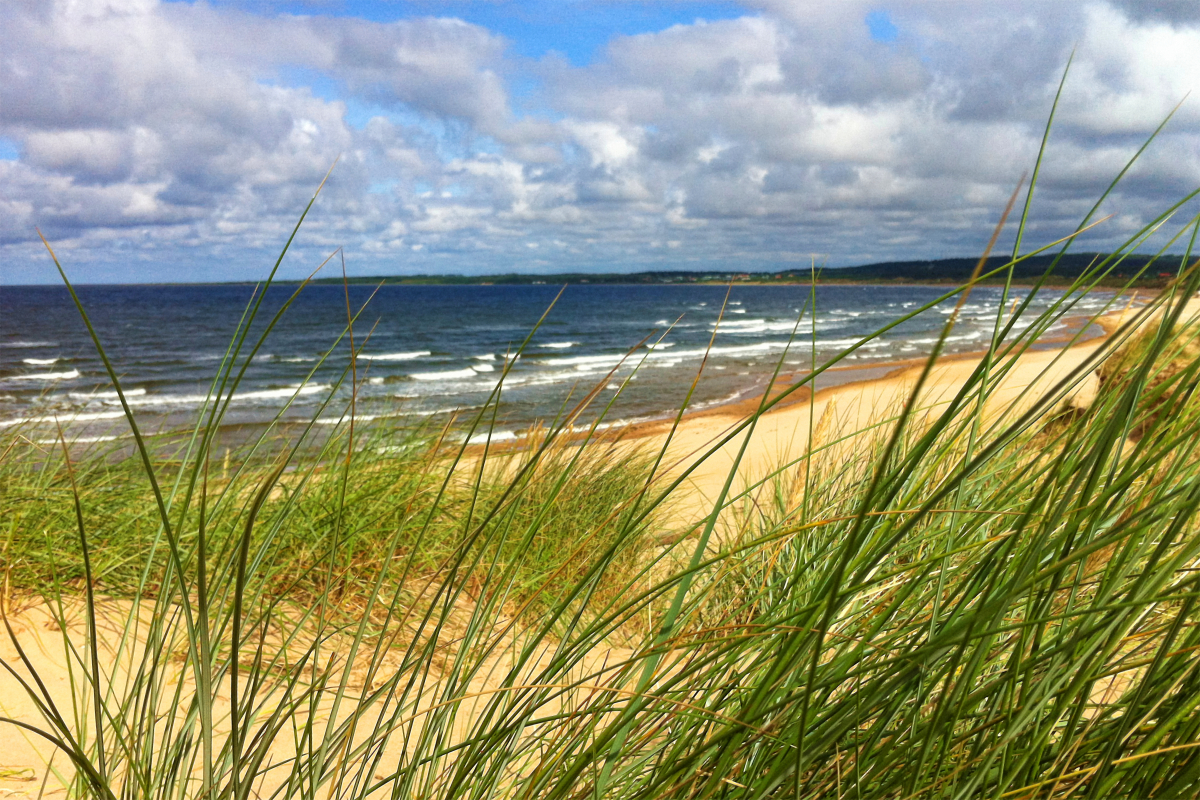
On the east coast, Öland Island attracts kitesurfing enthusiasts with its long stretches of sandy beaches and consistent winds. This spot is particularly popular in the late spring and early fall when the weather conditions are optimal for a memorable kitesurfing experience. Whether you prefer the rugged beauty of the west coast or the serene landscapes of the east, Sweden has it all for kitesurfing aficionados.
Brief History of Sweden
Sweden's history is deeply intertwined with its relationship to the sea, shaping its culture and love for water sports. The country's maritime heritage dates back to the Viking era, where seafaring played a crucial role in exploration and trade. This seafaring tradition laid the foundation for Sweden's modern water sports culture, including the rise of kitesurfing as a popular activity along its coasts.
As Sweden evolved into a modern nation, its passion for water activities only grew stronger, leading to the development of world-class kitesurfing facilities and events. Today, kitesurfing serves as a testament to Sweden's enduring connection to the sea and its commitment to providing exhilarating experiences for adventure seekers.
In conclusion, exploring Sweden's kitesurfing paradises and delving into its rich historical tapestry offers a unique blend of excitement and cultural immersion. Whether you're a seasoned kitesurfer or a novice looking to try something new, Sweden beckons with its enchanting waters and vibrant heritage, promising an unforgettable journey for water sports enthusiasts.
Exploring Beyond Kitesurfing
When you think of Sweden, kitesurfing might be the first thing that comes to mind, but this captivating country offers so much more beyond its watersports scene. Let's dive into the diverse array of experiences awaiting you beyond kitesurfing in Sweden:
Landmarks and Nature
In Sweden, nature takes center stage with its breathtaking landmarks and national parks. One must-visit destination is the stunning Stockholm Archipelago, composed of thousands of islands offering a serene escape from the bustling city life. For those seeking scenic wonders, the Northern Lights in Swedish Lapland paint the sky with mesmerizing colors, creating a magical experience like no other. Additionally, the majestic Drottningholm Palace, a UNESCO World Heritage Site, showcases a mix of Baroque and Chinese-inspired architecture, providing a glimpse into Sweden's rich history and royal heritage.
Cultural Highlights
Immerse yourself in the vibrant cultural tapestry of Sweden beyond kitesurfing. Explore the historic Gamla Stan in Stockholm, where cobblestone streets and colorful buildings transport you back in time. Indulge in traditional Swedish cuisine, from savory meatballs to delectable cinnamon buns, and savor the flavors of this culinary paradise. Don't miss out on experiencing local traditions such as Midsummer celebrations and the enchanting Lucia Festival, where you can witness the beauty of Swedish customs firsthand.
Embark on a journey beyond kitesurfing in Sweden to discover a world of natural beauty, historical richness, and cultural diversity that will leave you in awe. Whether you're drawn to majestic landmarks or eager to taste the flavors of Swedish cuisine, this enchanting country has something for every traveler, including watersports enthusiasts seeking to expand their horizons.
Your Journey to Sweden
Embark on an exhilarating journey to Sweden, a country renowned for its stunning landscapes and vibrant watersports scene. Whether you're a seasoned kitesurfing enthusiast or just venturing into the sport, Sweden offers a unique and captivating destination for your next adventure.
Getting There
When it comes to reaching Sweden, there are various means of transportation to consider. If you're keen on a convenient and efficient option, flying into one of Sweden's major airports, such as Stockholm Arlanda Airport or Gothenburg Landvetter Airport, is a popular choice. For travelers with a passion for watersports, exploring Sweden via ferry provides a scenic and immersive experience. Alternatively, train journeys offer a relaxing way to soak in the country's picturesque views en route to your kitesurfing destination.
Planning Your Kitesurfing Adventure
As you prepare for your kitesurfing adventure in Sweden, it's essential to consider accommodation options that cater to watersports enthusiasts. Look for seaside resorts or cozy beachside cottages that offer easy access to the water. Local amenities, such as equipment rental shops and kitesurfing schools, can enhance your experience and provide you with the necessary support for a successful adventure.
Before you hit the waves, ensure you're well-prepared with the right gear and knowledge. Research the weather conditions and wind patterns in your chosen kitesurfing spot to make the most of your time on the water. Don't forget to pack essentials such as sunscreen, a wetsuit, and ample enthusiasm for an unforgettable kitesurfing experience in Sweden.
Prepare to immerse yourself in Sweden's kitesurfing culture, where the thrill of gliding across the water is complemented by the country's breathtaking natural beauty. From pristine beaches to picturesque coastal towns, Sweden offers a kitesurfing paradise waiting to be explored by water sports enthusiasts like you.
Weather Considerations
When planning your trip to Sweden for kitesurfing, remember that the weather can vary depending on the season. Summer, from June to August, offers pleasant temperatures and longer days, ideal for outdoor activities. However, if you prefer less crowded beaches and don't mind cooler weather, late spring or early autumn can also be great times to visit.
Conclusion
When it comes to kitesurfing, Sweden is an unparalleled destination that seamlessly combines thrilling watersport adventures with rich cultural experiences and breathtaking natural beauty. From the pristine waters of Lake Vänern to the picturesque coastlines of Gotland, Sweden offers a diverse range of kitesurfing opportunities for enthusiasts of all levels. The unique blend of adrenaline-pumping activities, immersive cultural encounters, and stunning landscapes makes Sweden a must-visit destination for watersports lovers seeking an unforgettable experience. Don't miss the chance to kitesurf your way through Sweden's enchanting scenery and create lasting memories in this captivating Nordic gem.
When considering your next kiteboarding trip destination, feel free to add Russia to your list. Even if it never crossed your mind, this destination have proven worthy of a great kiteboarding trip because of its great conditions during the summer months, the many activities to do on-land and the history running through its streets.
In addition to the many kiting spots you can visit famous landmarks, learn about its history, enjoy the nightlife, visit a shooting range amongst many other touristic activities as well. Russia as a kiting destination can be enjoyed by anyone including beginners all the way to pro and will enjoy wind speeds from 15 to 40 knots on average.
If you have been thinking of visiting somewhere new - considering visiting Russia!
Capital: Moscow
Currency: Russian Ruble
Level: Beginner to Professional
Winds: 15-40 knots
Kites Needed:7-9m Small / 10-12m Big / 13-17m light
Waves: 0-5ft yes and no depends where
Flat Water Spots: Yes and no depends where
Beach Break Spots: Yes and no depends on area
Wetsuit Needed?: Yes/No depending on time of year and location
Water Temperatures: 0-25°C
Uncrowded Waters: Yes
Kiteboarding Lessons Average: 40-100 USD
Average Good Meal + Drink Price: 10-25 USD
Nightlife: Yes, depends where
Amazing Downwinders: Not really
Filled with magical landscapes and dreamy beaches, the country of Philippines live up to any explorer’s idea of paradise. with over 7,107 islands, this country have become more and more popular amongst kiteboarders who are looking for an affordable travel destination that allows you to explore a different culture, connect with nature and learn to kiteboard in warm waters with excellent wind conditions.
Philippines has a lot to offer from nature explorations, to kiteboarding trips and adventures, paired with a thriving nightlife that gives you the freedom and diversity to make of your trip the best possible one. If you want to do something that is nature or water related whether above or below - Philippines has something for you and is worth the visit.
Capital: Manila
Currency:Philippine Peso
Level: Beginner to Professional
Winds: 15-40 knots
Kites Needed: 5-8m Small / 9-12m Big / 13-17m light
Waves: 0-8ft yes and no depends where
Flat Water Spots: Yes and no depends where
Beach Break Spots: Yes and no depends on area
Wetsuit Needed?: No
Water Temperatures: 24-28°C
Uncrowded Waters: Yes
Kiteboarding Lessons Average: 60-120 USD
Average Good Meal + Drink Price: 5-25 USD
Nightlife: Not really, depends where
Amazing Downwinders: Not really, though different spots to visit (island hopping)
The Netherlands Antilles consist of Aruba, Bonaire, Curacao and Saint Martin islands located in the Caribbean off the northern coast of Venezuela. Within these small islands you will find an array of on and off the water activities which will make them all perfect for a holiday kitesurfing destination.
Additionally to kiteboarding you will be able to take on different activities from visiting towns, beaches and having interesting culinary experiences. If you are looking for a new kiteboarding destination, love to eat lots of tasty seafood, and have a Caribbean European environment then the Netherland Antilles will be your paradise.
Capital: Willemstad in Curacao could be considered the capital of the Netherland Antilles
Currency: Netherlands Antillean Guilder / Dutch Guilder
Level: Beginner to Professional
Winds: 10-25 knots
Kites Needed: Small 8m-10m / 11-14 Big
Waves: 0-6ft yes and no depends where
Flat Water Spots: Yes and no depends where
Beach Break Spots: Yes and no depends on area
Wetsuit Needed?: No, unless you want to use a shortie
Water Temperatures: 26-28°C
Uncrowded Waters: Yes
Kiteboarding Lessons Average: 60-120 USD
Average Good Meal + Drink Price: 10-30 USD
Nightlife: Yes, depends where
Amazing Downwinders: Not really
Montenegro is a country you do not hear much about for kiteboarding yet it’s a frequented spot for those who seek new kiting destinations. Overall it is quite a small country with more inland land than coast. Filled with mountain ranges, medieval towns, rivers, wild animals and strips of coastal beaches which some of them are within kiting conditions.
If you want to visit a new destination that has interesting activities off the water as it has on between the months of May and October - consider Montenegro. Specifically Ulcinj which is the main kite town in Montenegro with 13km strip of beach and various kiteboarding centers.
Capital: Podgorica
Currency: Euro
Level: Beginner to Professional
Winds: 12-25 knots
Kites Needed: Small 9m-11m / 12-17 Big
Waves: 0-1 ft Yes
Flat Water Spots: Yes
Beach Break Spots: Yes and no; very small shore break
Wetsuit Needed?: No, unless you want to use a shortie
Water Temperatures: 23-25°C
Uncrowded Waters: Yes
Kiteboarding Lessons Average: 50-75 USD
Average Good Meal + Drink Price: 7-25 USD
Nightlife: Yes, depends where
Amazing Downwinders: Yes, many kite safari options
Interest in Lithuania is growing year by year. Cycling enthusiasts here can find safe, newly-built routes in many Lithuanian cities. Watersport fans can try out new boat routes, kitesurfing, windsurfing and wakeboarding. Travelers are to be delighted by reconstructed heritage sites, the opening of visitor centers in protected areas, more accommodation, wellness facilities, and a wider range of entertainment and catering activities—not to mention the green forests, abundance of lakes, and the Baltic Sea with its grand dunes.
HIGHLIGHTS OF LITHUANIA
ANCIENT LAKES AND FORESTS
Lithuania is a land of lakes and forests steeped in legend, and a trip through them will appeal to the adventurous, the scenic, and the historical type of traveler. There are countless lakes, non-stop gurgling rivers, and centuries-old forests that echo with their sound.
HIKING AND MEDITATION
The opportunity to explore the country at a leisurely pace appeals to both domestic local travelers as well as international tourists. Some set out for a few hours, others spend weeks on the road. Some enjoy movement, meditation, and being with themselves, while others enjoy socializing and making new friends. As much as one-third of Lithuania's territory is covered by forests, so there is plenty of space—which is why guided hikes, meditation and yoga retreats are so popular in Lithuania.
WATER SPORTS
Due to the large number of lakes and rivers in Lithuania, water sports have special importance in the country. From kayaking, water skiing, rowing, SUP to windsurfing, surfing, wakeboarding, and kitesurfing. Wakeboarding is gaining popularity in Lithuania and extreme sports enthusiasts’ interest. As a consequence, Lithuania has a large number of wake parks as well as well-developed kitesurfing spots by the sea and the lagoon.
MUSIC FESTIVALS
As summer gets into full swing, so does the festival fever. July and August are the months when most music events, from rock to electronic music, attract visitors to exciting urban city spaces. One of the brightest, ‘Blues Nights’’ is perhaps the oldest Lithuanian open-air music festival that has become a tradition for many and has attracted a loyal crowd.
KITESURFING IN LITHUANIA
Kitesurfing in Lithuania first took root in 2001 when the first kiteboarders started to practice the sport. Soon after, kiting clubs and schools were established, where people interested in the sport gathered and kiting lessons were then organized. In Lithuania, the natural conditions are very suitable for kitesurfing. Wave lovers enjoy the Baltic Sea. High winds and waves make up a perfect combination for residents in Klaipėda who are chasing extreme kitesurfing conditions. Large uncrowded sand beaches are perfect for launching and landing the kite at ease. The most common places for professionals and amateurs to carve the waves are Klaipeda, Palanga, Sventoji, Nida, Juodkrante, and Monciškes.
For those learning to kitesurf or who like flat water, it would be hard to find a better place than the Curonian Lagoon. It is a shallow freshwater triangular lagoon on the southeastern edge of the Baltic Sea, protected from the sea waves by the Curonian Spit and influenced by the Nemunas, Minija, and other smaller rivers. The most famous spots are without doubt Svencelė, Dreverna, Kintai, and Cape Vente. The wind is typically blowing sideways to the shore between 14 and 25 knots. Some days may reach up to 40 knots. Sideshore wind direction allows epic downwind kite trips by the sea and the lagoon. Traveling from point to point along the shore, exploring remote spots, absorbing the purely natural landscape with your kite pals—there’s no better way to get to know the country.
Kiting can also be done on land with kite-skates and buggies, and winter is a great time for adventures in the snow, as it can be done on skis, ice-skates or a snowboard.
WHEN IS THE BEST TIME TO KITESURF IN LITHUANIA?
In Lithuania, the real enthusiasts kitesurf all year round as the wind conditions are favorable, even in the wintertime. This is done with the right clothing, thick wetsuits, and neoprene gloves and hats. The best spot to kitesurf is the Baltic Sea, which in winter has up to 2/3 meter waves.
Regardless, the high kitesurfing season starts at the end of May and ends early in October. The weather and water temperatures rise during the high season, however, a wetsuit at all times is necessary. Yet, who needs the tropics when you have idyllic kitesurf sunset sessions? From dusk till dawn, the sun stays up until midnight. Some night riders are chasing magic kite sessions under the full moon in the lagoon.
WHAT ARE THE BEST KITESURF SPOTS IN LITHUANIA?
Kintai
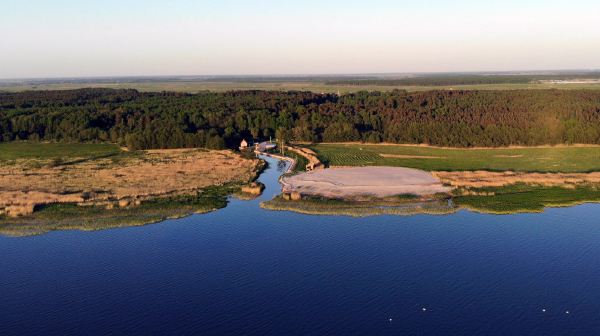
Photo: IKO Center Kintu Kaitu Klubas
Kintai is a small, old fisherman village with a harbor on the shore of the Curonian Lagoon. Due to the prevailing westerly winds, smooth water and shallow bottom, Kintai is considered one of the best and most popular kitesurfing destinations in Lithuania. Besides kitesurfing, the village enchants with its nature, fish dishes, and the beauty of the surrounding forests. The kitesurfing center there can be proud of having one of the most experienced kite instructors in Lithuania and the only examiner for the whole Baltic region and other countries around the world.
Svencele
The Lithuanian mecca of kiteboarding. As Brazil has Jericoacoara, Lithuania has the Svencele kite spot. Due to the characteristics of the lagoon, Svencele is very welcoming to newcomers. Yet, regardless of riding level, everyone has the ideal conditions to enjoy the sport. The lagoon is divided into zones for safety reasons: left side is for beginners and freeriders, whereas the right side is for freestylers. The site recently went under a major reconstruction and is now even more suitable for kitesurfers than ever before. With plenty of schools, gear rental and repair shops, restaurants, cafes and accommodation options the spot affords maximum comfort.
Dreverna
Dreverna is another old fishing village, located by the Curonian Lagoon and the Dreverna River. You can admire the panorama of the Curonian Lagoon and the coastal sand dunes, the boat and yacht harbor, and the surrounding nature. Access to the water is slightly more difficult due to the rush plants, seaweed and rocks on the shore. The water on the shore is slightly deeper as compared to Svencele or Kintai. Nevertheless, you have an option to take your kitesurfing session into the river of Dreverna.
Cape VenteCape Ventė is a beautiful furthermost corner of western Lithuania on the Curonian Lagoon coast. A red brick lighthouse was built on the tip of Cape Ventė. It is also important as the great bird migration route passes through Ventė Cape, which is why an ornithological station was established. Although there isn’t much space to pump and lift your kite up, and concrete pier serves as an exit to the water, once out there you can find an oasis of peace and tranquillity while kitesurfing in the lagoon.
Monciskes Beach
Right on the Baltic Sea coast, between Palanga and Sventoji—in Monciškės is where kitesurfers can dive into the world of wave surfing. As compared to flat riding in Svencele, kitesurfing in the Baltic Sea may seem slightly more complicated. As waves interfere with starting, the current may pull you sideways, knock you off your feet and, once you start, you crash on the first wave. Regardless, instructors with international IKO qualifications will help riders to tame the seaside wind and waves. The most common wind directions are from the south, southwest, west, northwest, or north. Dusia Lake
Dusia, Lithuania's third largest lake, is surrounded by pine forests but with plenty of room to pump up, raise, and lower your kite. It’s a shallow coast with a smooth breeze and a clean, sandy bottom. Ideal for beginners, but suitable for professionals too! Depending on the wind direction, you can choose where to enter the lake.
Elektrenai Lake
Those who are visiting big cities in Lithuania such as Vilnius and Kaunas have the pleasure to kitesurf in the Elektrenai lake nearby. The best conditions to kitesurf is when the west and northwest winds kick in. It is a spot suitable for advanced riders with their own gear as there are no kite centers or shops. The entrance to the water may be tricky as well because of the narrow grassy access being blocked by the trees.
ABOUT THE COUNTRY
A Brief History of Lithuania
The first inhabitants of Lithuania appeared 12-13 thousand years ago, as the weather warmed and the glaciers retreated northwards. These were the Baltic tribes, nomadic, often moving from place to place. As a country, Lithuania is mentioned for the first time in the history of a small German in the annals of the small German town of Quedlinburg in 1009. From the very beginning, Lithuania was attacked by the Sword-and-Sabbaths and Crusaders, allegedly to baptize the pagans, however, in reality, it was to conquer lands and enslave their inhabitants.Lithuania strategically formed an alliance with Poland and occupied large areas. But even then, the country was divided and at war with Sweden, Germany, and Russia for years. In 1914, at the beginning of World War I, Lithuania became a part of Germany and Russia. In 1915, Lithuania was occupied by the Germans. On June 15, 1940, during World War II, the Soviet Union army occupied Lithuania. The Sovietization of the country began. On March 11, 1990, The Supreme Council adopted the Act on the Restoration of the Independent State of Lithuania, and Lithuania became a non-compliant democratic country. In 2004, Lithuania joined two organizations along with Latvia and Estonia: the North Atlantic Treaty Organisation (NATO) on March 29th, and the European Union (EU) on May 1st. After this period, Lithuania's economy has strengthened and continues to grow, foreign direct investment is increasing, Lithuanian schools and universities are being renovated, and existing social guarantees are growing.
Other Attractions in Lithuania
Without any doubt, wake cable park 313 is a must-see. It’s known as the largest in Europe and one of the most high-end wake parks in the world, attracting some of the most famous athletes in the field. They also host top-level RedBull competitions. A must-do is to go wake surfing in the Curonian Lagoon. This is the best way to experience the sport of surfing. A fast boat, good company, adrenaline, and indescribable views of the lagoon and the dunes will make the day a success.. Lithuania is also a land of waves. The waves in the Baltic Sea often reach 2 meters. The surfing base near Klaipeda pier will provide you with the necessary equipment and qualified instructors. You only need to follow the wave forecasts and wait for the right moment. When in Lithuania, the capital Vilnius is worth a visit. The old town streets are full of history and interesting artistic cafes and bars, often performing various types of live music concerts. Near Vilnius, Trakai Castle is probably one of the most spectacular places in the country. It’s a castle in a lake, surrounded by nature, green forests and islands. It takes the breath away for many visitors.
Getting to Lithuania
The quickest and easiest way to reach Lithuania is by plane. The capital, Vilnius, has an international airport with low-cost airlines that connect with major European cities. There is also an airport in Kaunas, more in the center of the country, with plenty of direct flights. Palanga airport situated by the Baltic sea is the third airport, yet smaller, but still receiving international flights. From Vilnius Railway Station you’re able to travel by international trains to the following destinations: St. Petersburg, Moscow, Minsk, Riga, Warsaw and to various parts of Lithuania. The most direct route to the Baltic States is by ferry. Convenient and fast routes go to the Baltic States from Europe or the Scandinavian coast. With up to three different routes, you can reach your destination the next day. Ferries from Germany and Sweden make it easy to get to Lithuania.
USEFUL RESOURCES
SIMILAR KITESURFING DESTINATIONS
- Estonia
- Poland
SPOT
WORLD > EUROPE > LITHUANIA > KINTAI
KINTAI
Kintai is a unique settlement by the Curonian Lagoon, surrounded by forest on the way to the famous Cape Vente Lighthouse. It is the heart of Lithuanian identity, distinguished by its fishing traditions and extremely warm local people. And it would be remiss not to mentioned the unique nature, loved even by such rarities as sea eagles.
HIGHLIGHTS
SPORT FESTIVAL
During the summer months, the Curonian Lagoon coast near Kintai offers an extraordinary spectacle—the Wind Sports Festival. Kitesurfing, which became particularly popular, brings together enthusiasts from all over the country to remember safety procedures, kite repair particularities, and enroll in advanced training sessions. The festival is crowned by breathtaking performances in competitions of different kite disciplines. The athletes typically compete in the Race team event, the Children's Cup, Light Freestyle and Pro Freestyle competitions. Downwind is the culmination of the festival, a communal downwind swim with the aim that all participants complete the distance.
QUALIFIED INSTRUCTORS
In both Svencele and Kintai more and more qualified instructors are becoming available, who cannot only help to tame the wind and provide the necessary theoretical and practical knowledge, but also increase the accessibility of the sport. This is thanks to Kintai Kitesurfing Center, which is the only one in the Baltic States that trains kitesurfing Instructors and Assistant Instructors according to the IKO methodology.
BIRD WATCHING
Kintai is one of the best birdwatching sites to discover as many bird species as possible, with as many as 320 bird species. Birdwatching in the Nemunas Delta is a true Lithuanian safari. Various river routes, hidden observation platforms, half-day, full-day or multi-day excursions by wooden kayaks offer a unique opportunity to spot wild birds from a short distance and to take photos or videos.
FISH GASTRONOMY
Kintai has always been famous for its large fish markets. There may not be as many fishermen nowadays, but the smell of fish still lingers. Here local fisherman smoke catfish, perch, bream and other lagoon fish. Also, various companies farm carp, catfish, pike, crucian carp, white sturgeon, etc. in ponds. The live fish produced are supplied to major Lithuanian supermarkets and exported to Germany, Latvia and Poland. Obviously, there are plenty of restaurants in the town to get really fresh fish straight from nearby ponds. One of the recommended dishes is carp stewed in beer sauce.
KITESURFING IN KINTAI
Safe conditions are available for beginners and professionals alike—easy access, shallow and sandy shoreline, plenty of space. The many years of experience in kitesurfing and other water sports of the certified IKO instructors of Kintai Kite Club allow you to safely and quickly learn the subtleties of this sport and master kitesurfing! The cherry on top of it all—what’s better than to have an opportunity to admire the Curonian Lagoon, the Curonian Spit, and the unforgettable dunes of Nida while kitesurfing.
Wind, weather and water
Curonian Spit has a maritime climate with strong winds and relatively small annual temperature fluctuations. In summer, kitesurfers may enjoy the warmest weather among Lithuanian resorts, with an average temperature of +17.3 °C. The sun shines for an average of 858 hours. It also receives the least rainfall during the warm season. The wind is fairly steady, without gusts. On windy days the wind is blowing from 10 knots and may reach 40 knots. The prevailing wind directions are north, west, northwest and southwest, either side-shore or onshore. When the north wind kicks in, you can always add a few knots more to what the actual forecast shows. Occasionally the wind turns around and blows offshore. In such a case, advanced kitesurfers make the best of the opportunity and arrange a downwind trip with their pals to the Curonian Spit, which is around 9 kilometers away. The Curonian lagoon at Kintai offers a smooth water surface, which sometimes might be choppy when the wind picks up. The water isn’t salty so it doesn't scratch your eyes. The shallow coastline is especially good for beginners, as you will always feel the ground under your feet. It's easy to get back to where you want to be or recover a lost board. Sometimes hurricanes or smaller storms lead to increased saltwater intrusion into the Curonian Lagoon and flash flooding. However, this usually happens in autumn. The water temperature in the summer on average is around +18 degrees, soyou will still need to put on a springsuit or a full coverage 3/2mm wetsuit. Although it's not only in summer that you can kitesurf, but cold water is not much fun to kite in.
WHAT ARE THE BEST BEACHES FOR KITESURFING IN KINTAI?
KINTAI BEACH
The only beach in the Curonian Lagoon that has soft sand for an easy pump, launch and drop down of the kite. The spot offers plenty of space, no trees in between blocking the way and shallow access to the water and steady winds. When the wind direction is favorable, Kintai beach is a popular start or finish point for downwind kite trips.
Wind direction: SW-WNW-W. From 10 to 40 knots.
Water conditions: Flat, choppy.
Discipline(s): freeride, freestyle, downwind, big air.Skill level: all levels: From beginner to advanced riders.
Watch out for: (hazards) the beach is surrounded by bulrush plants and seaweed.
Getting there: Kintai is easily accessible from Klaipėda city. Straight line distance from Klaipeda to Kintai Is 33.7 km by car. A short and easy 30 minute ride to the spot.
Tip: Make sure to have an at least 3/2mm wetsuit.
OBSERVATION TOWER
Just a few hundred meters away from Kintai beach, where the observation tower stands, there’s another entry into the lagoon. Access here is indeed less ideal than on Kintai beach. Here the sand is replaced by grass, and there is only enough space for 3 kites (and the water entrance is sharply deeper). Regardless, it is a remote uncrowded spot, providing the same great wind and water conditions.
Wind direction: SW-WNW-W. From 10 to 30 knots.
Water conditions: Flat, choppy.
Discipline(s): Freeride, freestyle, downwind, big air.
Skill level: from beginner to expert.
Watch out for: (hazards) the beach is surrounded by bulrush plants and seaweed, little space.
Getting there: a few hundred meters away from Kintai beach, walking distance through the woods.
Tip: be aware of the deep water by the shore.
TRAVELING TO KINTAI AS A KITER
Getting There
The smartest and most convenient choice would be to rent a car and drive to all the spots, especially if you carry your own kite gear. From the city of Klaipeda Kintai it is about a 45 minute journey. When you reach Dreverna village you have two options: either to take the regular paved road (slightly longer) or cut some kilometers and have a little adventure taking the gravel road and going through a beautiful forest, which is more like the tropics than Lithuania. Another option is to take commuter buses from Klaipeda to Kintai, however, the schedule is limited to only a few rides per day at certain hours.
Accommodation
As interest in the sport and the number of visitors grew, the reconstruction of homesteads and farmhouses began while maintaining the ancient architecture but keeping life adapted to wind chasers. There are many such homesteads in Kintai. Guests can also stay on the water in rooms on sailboats. Another alternative is to rent a place for a tent or camper. A free camping site for a camper van by the lagoon is right next to the kitesurfing center in Kintai.
Getting Around
Kintai town is small in size, which makes it very easy to move from point a to point b. You can rent a bicycle, drive your own car, or go on foot. Concerning public transport, you won’t find any buses in Kintai. Taxi services are available by calling a local number.
Food and Drink
Like the surrounding settlements, Kintai is a seaside town with a long fishing tradition. No wonder the fresh fish caught in local waters end up on the table of every restaurant in Kintai. From chilled carp, bighead carp, trout, sturgeon, to pike perch and pike—you name it, they have it. A must is to try the fish soup and various smoked fish pieces that can be accompanied with fine Lithuanian beer or traditional homemade kvass drink.
No Wind?
If there's no wind, there's really no need to sit idly by and wait. In Kintai you will find not only everything you need for both beginners and advanced kiters but also much more. Kitesurfing, sailing catamarans, paddleboards, bicycles, beach tennis, volleyball, music festivals, bonfires, various camps, and of course no stress.As Kintai is a quiet town, there is little action after midnight. But you can always find some movement in nearby Svencelė, Dreverna or Klaipėda, which is hustling and bustling full of live jazz and rock bars. A good idea is to go and explore Dreverna port and its most attractive 15-meter-high observation tower, which offers unique views of the Curonian Lagoon, the grey Curonian Spit, or the Dead Dunes. During the summer season, a regular passenger ferry to Juodkrante departs from the Port. The harbor also has a restaurant and water entertainment centers, as well as water skis, water bikes, jet skis, fishing quadruple boats, and other equipment available for rent so that everyone can find something they like to do when taking a break from kitesurfing. Lithuanian watersports’ jewel is a three-circle wakeboarding park 313. Located near Palanga town, right next to the beach, it’s an hour’s drive away by car from Kintai. Now in its fifth year, the park is known as one of the largest and most modern wakeboard parks in the world. The park offers three newly installed ‘’Sesitec’’ system circles and 50 UNIT parktech figures. Every single one is also greeted by the park's well-maintained infrastructure, a restaurant and an entertainment and play area for children. High-level Redbull wakeboarding competitions are held annually, attracting elite wakeboard athletes from Europe and a massive crowd of spectators.
USEFUL RESOURCES
From majestic savannas to pristine beaches, this East African gem teems with adventure, culture, and relaxation. Soak up the sun in Mombasa or go on a wild safari to spot lions, elephants, and giraffes in their natural habitats. Immerse yourself in the rich tapestry of indigenous traditions and customs. This is Kenya, where adventure and culture come together in perfect harmony.
HIGHLIGHTS OF KENYA
WILDLIFE
Kenya is a hub for wildlife and nature enthusiasts and famous for its diverse range of animals including the Big Five—lions, elephants, leopards, rhinos, and buffalos. These majestic creatures can be seen roaming the savannas in their natural habitats. A visit to Kenya offers a chance to witness the raw beauty of the African wilderness and experience the grace and power of these incredible animals.
CUISINE
Kenyan cuisine is diverse and flavorful with dishes that reflect the country's cultural mix of African, Indian, and Arab influences. From traditional dishes that have been passed down for generations, to contemporary creations that showcase the innovative spirit of Kenyan chefs, the food of Kenya is an integral part of the country's cultural heritage. Visitors to Kenya can sample the country's cuisine at local restaurants, street food stalls, and marketplaces,
FESTIVALS AND EVENTS
Kenya´s richness in cultural heritage and traditions is reflected in the many unique festivals and events that take place throughout the year. Whether you're interested in music, dance, film, or wildlife, there is a festival or event in Kenya that will appeal to your interests. Nairobi International Film Festival takes place in Nairobi and showcases the best of African and international films.
PEOPLE
Kenya is home to over 40 ethnic groups, each with its own unique culture, traditions, and way of life. The largest groups are the Kikuyu, Luo, Luhya and Kalenjin. Visitors can go on a cultural tour to learn about these groups and their traditions and to experience the country's rich cultural heritage for themselves.
KITESURFING IN KENYA
Kenya offers excellent conditions for kitesurfing with warm water, steady trade winds, and beautiful landscapes. The water temperature along the coast is usually around 25-30°C, which is warm enough to kitesurf comfortably without a wetsuit. The trade winds, which blow consistently from June to September, provide ideal conditions for kitesurfing and offer a good balance of power and stability.
In terms of infrastructure, Kenya has a well-developed tourist industry, and there are many hotels, resorts, and guesthouses in the area that cater to kitesurfers. There are also several kitesurfing schools and rental shops that offer lessons, rental equipment, and guided tours for those who are new to the sport. The shops and schools are typically located close to the best kitesurfing spots, making it easy to access the water and start kitesurfing.
The landscape of Kenya is beautiful and diverse, with lush tropical forests, pristine beaches, and stunning mountain ranges. The coast of Kenya is dotted with palm trees, and there are several offshore islands that offer a secluded and peaceful kitesurfing experience.
One of the best places to go kitesurfing in Kenya is Diani Beach, located just south of Mombasa. This beach is known for its crystal-clear water, warm temperatures, and consistent trade winds.
Whether you're a beginner or an advanced kitesurfer, there is something in Kenya that will appeal to your interests and abilities. With its warm water, steady winds, and beautiful scenery, Kenya is a kitesurfing destination that offers a truly unique and unforgettable experience.
WHEN IS THE BEST TIME TO KITESURF IN KENYA?
The best time to kitesurf in Kenya is from June to September, which is peak kitesurfing season. During this time, the trade winds are consistent, offering ideal conditions for kitesurfing. The water temperature is also warm, usually around 25-30°C, which is warm enough to kitesurf comfortably without a wetsuit.
In terms of weather, the best time to kitesurf in Kenya is during the dry season which runs from June to October. During this time, the skies are typically clear with little to no rain, making it the perfect time to enjoy the warm sun and trade winds.
That being said, kitesurfing is possible year-round in Kenya, and there are many other factors that can affect the conditions, such as local winds and currents, water temperature, and wave height. For this reason, it's always a good idea to check the local weather and conditions before heading out to kitesurf.
WHAT ARE THE BEST KITESURF SPOTS IN KENYA?
Diani Beach

The beach is located on the coast of Kenya near Mombasa and is surrounded by lush vegetation and wildlife. Kitesurfing at Diani Beach offers a unique experience, with the combination of warm waters and strong winds making it an ideal spot for both beginners and experienced kitesurfers. The beach is also equipped with kitesurfing schools and equipment rental shops, so visitors can easily access everything they need to enjoy the sport. Whether you are looking to learn how to kitesurf or simply enjoy the thrill of the sport, Diani Beach is a must-visit destination for anyone interested in kitesurfing.
Kilifi

Kilifi is located on the Kenyan coast, approximately 50 km north of Mombasa, and is known for its strong and consistent trade winds. This makes it an ideal spot for kitesurfing, especially during the months of June to September when the wind conditions are at their best. The main kitesurfing spot in Kilifi is known as Bofa Beach, which is located just outside of the town. Bofa Beach offers a wide expanse of shallow, turquoise waters that are perfect for kitesurfing. In addition to Bofa Beach, there are several other kitesurfing spots in Kilifi, including Shanzu Beach and Watamu Beach.
Watamu

Watamu, a coastal town located in Kenya, is well-known for its picturesque beaches and optimal conditions for kitesurfing. This popular kitesurfing destination boasts consistent trade winds and warm waters, making it a top choice for kitesurfers, especially during the months of June to September. The main kitesurfing spot in Watamu is the Blue Lagoon, which is located close to the town and offers ideal conditions for kitesurfing, with its wide and shallow turquoise waters.
ABOUT THE COUNTRY
A Brief History of Kenya
Kenya has a rich and diverse history that spans thousands of years. The earliest evidence of human habitation in Kenya dates back to the Lower Paleolithic era, around 2.5 million years ago. Over the millennia, various groups of people settled in Kenya, including the Bantu-speaking peoples, Nilotic-speaking peoples, and various ethnic groups from the Arabian Peninsula and the Indian subcontinent.
In the 19th century, Kenya became a focal point for European exploration and colonization. The British established a protectorate over Kenya in 1895, and the country was formally annexed to the British Empire in 1920. During this period, Kenya became an important center for agriculture, with large-scale coffee and tea plantations being established by British settlers.
After World War II, Kenya became a center of political activity and anti-colonial struggle, and in 1963, the country gained independence from Britain. In the decades that followed, Kenya underwent a rapid social and economic change, with the country becoming a republic in 1964 and undergoing a series of reforms aimed at improving the lives of its citizens.
In recent years, Kenya has continued to grow and develop, and today it is one of the leading economies in Africa. Despite ongoing challenges, such as poverty, corruption, and political instability, Kenya remains an important and influential nation on the continent and is known for its rich history, diverse culture, and stunning landscapes.
Other Attractions in Kenya
Kenya is known for its stunning natural beauty and diverse wildlife, making it an ideal destination for adventure lovers. Whether you are an adrenaline junkie or a nature lover, Kenya has something to offer everyone.
Kenya is famous for its wildlife safaris, where you can see lions, elephants, rhinos, and many other species in their natural habitats. You can also experience the beauty of the Maasai Mara from a different perspective with a hot air balloon safari.
Mount Kenya is the second-highest mountain in Africa and a popular destination for trekking and climbing. Kenya also offers some of the best biking trails in the world, where you can experience the scenic beauty of the country while cycling through different terrains. The rock formations in Kenya are perfect for rock climbing and offer a thrilling experience for adventure seekers.
The Tana River in Kenya is a popular destination for white-water rafting, and the rapids offer a thrilling experience for those who love adventure.
Getting to Kenya
Getting to Kenya is relatively easy, with several flights available from major cities around the world. The main international airport in Kenya is Jomo Kenyatta International Airport (NBO), which is located in the capital city of Nairobi. From here, travelers can connect to other destinations within Kenya and around the world.
Most major airlines offer flights to Nairobi with connections from cities in Europe, Asia, and North America. Some airlines also offer direct flights to other cities in Kenya, such as Mombasa and Kisumu.
In addition to air travel, it's also possible to enter Kenya by road, either from neighboring countries such as Tanzania, Uganda, or South Sudan or by using one of the country's several land border crossings. While overland travel can be a bit more challenging, it can also be a rewarding and culturally rich experience, allowing travelers to see the country and its people up close.
Traveling to Kenya by water is possible, but not as common as by air or land. The main port of entry for maritime travel is the port city of Mombasa, which is located on Kenya's Indian Ocean coast. From here, travelers can take ferries to other islands in the region or continue their journey overland to other parts of Kenya. Also, some travelers opt to arrive in Mombasa via cruise ship, while others choose to take a private yacht or sailboat, allowing them to explore the coastline and islands at their own pace.
USEFUL RESOURCES
Indonesia has always been recognized as a surfing mecca though it is slowly becoming more and more recognized as well as an amazing kiteboarding destination. The National Institute of Aeronautics and Space (LAPAN) claims that the Indonesian archipelago has 18,307 islands. Not all are inhabited though it comes to show how amazing and vast this destination is.
Indonesia overall is a very popular place to visit regardless of its world class waves and wind. Travelers from all around the world go to experience the different activities on and off the water.
In Indo you can explore its nature, temples, monkeys, beaches as well immerse yourself in their ways of life and celebration. On the water you will have world class blue clear waters and conditions for surfing, stand up paddle boarding, snorkeling, scuba diving and kiteboarding! This is a destination we highly recommend to anyone.
Capital: Jakarta
Currency: Indonesian Rupiah
Level: Beginner to Professional
Winds: 12-30 knots
Kites Needed: Small 6m-8m / Medium 9m-11m / Large 12m-15m
Waves: 0-30ft
Flat Water Spots: Yes
Beach Break Spots: Yes
Wetsuit Needed?: No
Water Temperatures: 25-29°C
Uncrowded Waters: Yes
Kiteboarding Lessons Average: 30-50 USD
Average Good Meal + Drink Price: 3-20 USD
Nightlife: Depends on which
Amazing Downwinders: Not really
Have you ever thought about Estonia as a kiteboarding destination? Despite it not being known as a kitesurfing mecca, Estonia is a beautiful country to visit on top of being a place to kite board. In Estonia you can have chances of wind year round with the more favorable conditions in their summer time.
Additionally to kiteboarding in Estonia you can visit and explore its beautiful castles, parks, waterfalls, towns and more. Estonia is a great destination to visit if you want to make a mix trip of kiteboarding and sightseeing. Wether you are a solo traveler, couple, group of friends or family - Estonia could be an interesting destination for you to visit!
Capital: Tallinn
Currency: Euro
Level: Beginner to Professional
Winds: 12-25 knots
Kites Needed: Small 7-10m / Big 11-14m
Waves: 0-3ft
Flat Water Spots: Yes
Beach Break Spots: Yes, 0-3ft beach break
Wetsuit Needed?: Yes, size of wetsuit depends on time of the year
Water Temperatures: 0-22°C
Uncrowded Waters: Yes
Kiteboarding Lessons Average: 40-60 USD
Average Good Meal + Drink Price: 5-20 USD
Nightlife: Yes, depends on the location
Amazing Downwinders: No
Imagine gliding over crystal-clear waters with the Mediterranean sun on your back and a gentle breeze guiding your sail. That’s the magic of kitesurfing in Cyprus. This hidden gem of the Mediterranean is quickly becoming a top spot for kitesurfing enthusiasts, thanks to its ideal weather conditions and stunning coastal landscapes.
Cyprus offers more than just great winds; it presents an adventure packed with beautiful beaches and a welcoming atmosphere. Whether you're a seasoned pro or a newbie eager to catch your first wave, the island provides a playground for all skill levels. In this post, you'll discover why Cyprus is the perfect destination for your next kiteboarding escapade and learn the best spots to hit the waves. Get ready to be inspired by the vibrant kitesurfing scene that's taking Cyprus by storm!
About the Country
Cyprus is a fascinating island with a rich blend of history, culture, and natural beauty. Known for its sunny weather and beautiful beaches, this Mediterranean gem offers a perfect backdrop for kitesurfing. Let's take a quick journey through the history and features that make Cyprus unique.
Early Beginnings
Cyprus's history stretches back thousands of years. Around 9000 BCE, the first settlers arrived, making it one of the oldest civilizations in Europe. The island was coveted by ancient powers for its strategic location and resources, particularly copper. In fact, the word "copper" is derived from "Cyprus," highlighting its historical significance in metallurgy.
Influence of Empires
Over the centuries, Cyprus has been shaped by various empires, each leaving a mark. Here are some key influences:
- Greek Influence: Starting around 1400 BCE, the Greek presence introduced language, architecture, and arts.
- Roman Period: The Romans took control in 58 BCE, and Cyprus thrived under Roman rule. Many ruins from this era can still be seen today.
- Byzantine Rule: After the Roman Empire split, Cyprus became part of the Byzantine realm, influencing its culture and religion significantly.
Medieval to Modern Times
The Middle Ages brought more change. The island was taken over by Richard the Lionheart during the Crusades, eventually passing to the Lusignans and then the Venetians. In 1571, the Ottomans conquered Cyprus, ruling it for over 300 years.
In 1878, Cyprus entered a new era under British administration, paving the way for its complex modern history. Cyprus gained independence in 1960, though tensions between the Greek and Turkish communities have persisted.
Cultural Richness
Cyprus is a tapestry of cultures, where ancient traditions blend with modern life. Visitors can explore historic landmarks, from Byzantine monasteries to ancient amphitheaters. The island's vibrant festivals and delicious Mediterranean cuisine reflect its diverse heritage.
Cyprus is not just a place steeped in history; it is a living, breathing island where past and present coexist, creating a unique and welcoming environment for travelers and kitesurfers alike.
Highlights of Cyprus
Cyprus is a small island with a big heart. From its rich history to its stunning landscapes, this Mediterranean gem offers a unique blend of natural beauty and cultural treasures. Whether you're an adventurer, a history buff, or simply someone looking to relax, Cyprus has something for everyone.
Stunning Beaches
Cyprus is famous for its pristine beaches, and for good reason. Imagine golden sands meeting the turquoise waters of the Mediterranean. Some must-visit beaches include:
- Nissi Beach: Known for its lively atmosphere, this beach is perfect for those who love to party in the sun.
- Fig Tree Bay: A more tranquil spot, ideal for families and anyone who enjoys a peaceful day by the sea.
- Aphrodite’s Rock Beach: Steeped in mythology, this is where legend says the goddess Aphrodite emerged from the sea.
Captivating Culture
Cyprus is a blend of cultural influences, primarily due to its strategic location over the centuries. The island's culture reflects a mix of Greek and Turkish traditions, with a sprinkle of Middle Eastern flair. When visiting, you'll notice:
- Traditional Cypriot Music and Dance: Folk music and dance are integral parts of Cypriot culture. You might catch an impromptu performance in a local taverna.
- Festivals: From religious celebrations like Easter to cultural festivals like the Limassol Carnival, Cyprus knows how to celebrate life.
Historical Sites
With a history that dates back thousands of years, Cyprus is a paradise for history lovers. Some key sites include:
- Kourion: An ancient city-state with spectacular views over the sea. The well-preserved amphitheater is a highlight.
- Tombs of the Kings: These impressive underground tombs are part of the UNESCO World Heritage Site in Paphos.
- Kyrenia Castle: Overlooking the picturesque harbor, this castle houses an amazing shipwreck museum.
Delicious Cuisine
Cypriot cuisine is a delightful fusion of flavors. Think of it as a culinary journey through the Mediterranean. Here's what you shouldn't miss:
- Halloumi: The island's famous cheese, often grilled to perfection.
- Souvla: Large pieces of meat slow-cooked over charcoal, a traditional must-try.
- Meze: A selection of small dishes, akin to Spanish tapas. It's a feast of flavors that invites sharing and conversation.
Interesting Facts
Cyprus is more than its beaches, culture, and cuisine. Here are a few quirky facts:
- Aphrodite’s Birthplace: According to mythology, Cyprus is the birthplace of Aphrodite, the Greek goddess of love and beauty.
- Split Capital: Nicosia is the only divided capital in the world, split between the Greek Cypriot south and the Turkish Cypriot north.
- Independence: Cyprus gained independence from British rule in 1960, making it a relatively young nation in terms of sovereignty.
Cyprus, with its mix of natural beauty, intriguing history, and vibrant culture, offers an unforgettable experience. It’s a place where visitors can make lasting memories while discovering something new at every turn.
Why Cyprus for Kitesurfing?
Cyprus is a hidden gem for kitesurfing enthusiasts. Its unique geographical location and climate make it an exceptional destination for both beginners and seasoned kiters. Let's explore why Cyprus stands out as a premier kitesurfing spot.
Ideal Wind Conditions
Cyprus boasts wind conditions that are almost tailor-made for kitesurfing. The island is embraced by the Meltemi wind, a seasonal wind that strengthens during the summer months, creating thrilling conditions for kitesurfers.
- Meltemi Wind: Predominantly blows from the northwest, offering consistent wind speeds that are ideal for kitesurfing.
- Consistency: The wind is most reliable from May to September, providing plenty of opportunities to ride the waves.
- Wind Speed: Average wind speeds range from 15 to 25 knots, perfect for catching some air and riding the surf.
Stunning Locations
Cyprus is not short of breathtaking locations to set sail and catch the breeze. Here are a few spots kitesurfers shouldn't miss:
- Larnaca: Known for Mackenzie Beach, Larnaca offers shallow waters and steady winds, making it perfect for learning the ropes or perfecting tricks.
- Limassol: Limassol, is a popular destination for kitesurfing, the predominant wind in Limassol is a thermal wind that picks up in the afternoon, making late mornings to early evenings the best time for kitesurfing.
- Pissouri Bay: Nestled between Limassol and Paphos, this spot offers spectacular scenery with a mix of flat water and small to medium-sized waves.
- Ayia Napa: Famous for its vibrant nightlife, Ayia Napa also provides a thrilling kitesurfing experience with its clear blue waters and strong winds.
Each of these locations presents kitesurfers with a different flavor of the island's charm—whether it's the serene beauty of Pissouri Bay or the bustling vibe of Ayia Napa.
Climate and Water Temperature
The Mediterranean climate of Cyprus is another draw for kitesurfers. The island enjoys mild winters and hot summers, allowing for a long kitesurfing season.
- Summer: From June to September, temperatures soar to an average of 85°F (29°C). This is the peak kitesurfing season, thanks to warm waters and consistent winds.
- Winter: While cooler, with temperatures rarely dropping below 60°F (16°C), winter offers gentle winds for those who enjoy a calmer ride.
- Water Temperature: Ranging from 63°F (17°C) in winter to around 82°F (28°C) in summer, the sea remains inviting throughout the year, ensuring comfortable kitesurfing sessions.
Cyprus’s inviting waters and favorable climate make it a kitesurfing paradise, offering something for everyone—whether you seek gentle breezes or adrenaline-pumping wind speeds.
Community and Events
Kitesurfing in Cyprus is more than just a sport—it's a vibrant community that brings people together, celebrating the thrill of the wind and waves. Whether you're a seasoned kitesurfer or just starting out, the island offers a welcoming atmosphere filled with events and camaraderie. Let's dive into the community spirit and the exciting happenings on this beautiful island.
Kitesurfing Competitions
Cyprus hosts several kitesurfing competitions that draw participants and spectators from all over the world. These events are perfect for those looking to test their skills against others or simply soak in the adrenaline-fueled action.
- King of Kite Cyprus: Held annually, this event showcases the talents of both local and international kitesurfers. Competitors go head-to-head in various events, with judges scoring based on style, technique, and creativity. It's a sight to behold, with colorful kites dancing across the Cypriot sky.
- Cyprus Kitesurfing Festival: A celebration of kite culture, this festival is more than just a competition. It includes workshops, music, and social events, making it ideal for families and fans of all ages. Whether you're participating or watching, the festival atmosphere is contagious and makes for a memorable experience.
These competitions aren't just about winning; they celebrate the kitesurfing lifestyle and foster a sense of belonging among enthusiasts.
Local Kitesurfing Community
The local kitesurfing community in Cyprus is like a close-knit family. They are passionate about the sport, sharing tips, stories, and even equipment with one another. Its friendly vibes make it easy for newcomers and veterans alike to feel at home.
Being part of the kitesurfing community in Cyprus feels like having a second family. Whether you're riding the waves or hanging out on the shore, the connection with like-minded individuals adds to the joy of the sport. Check out IKO Centers
Other Attractions
While kitesurfing is a thrilling activity to try in Cyprus, the island offers an array of other attractions that can make your visit unforgettable. Whether you're a nature lover, history buff, or just want to relax, Cyprus has something special for everyone. Let's explore some of the must-see attractions and activities.
Hit the Hiking Trails
For those who love the great outdoors, Cyprus offers breathtaking hiking trails. Head to the Troodos Mountains, where you can trek along paths that weave through lush forests and past stunning waterfalls. Hiking here is like diving into a real-life fairy tale, with hidden gems around every corner. Don't miss the chance to hike the Caledonia Trail, perfect for capturing the island's natural beauty.
Discover Breathtaking Beaches
Beyond the excitement of kitesurfing, Cyprus is home to some of the most beautiful beaches in the Mediterranean. Spend a day soaking up the sun on the sandy shores of Nissi Beach or explore the picturesque Blue Lagoon. Whether you want to swim, snorkel, or just relax with a good book, these beaches offer the perfect escape.
Visit Charming Villages
Take a break from the hustle and bustle by visiting one of Cyprus's charming villages. Omodos and Lefkara are known for their quaint architecture and friendly locals. Stroll through cobblestone streets, explore local markets, and perhaps even pick up a handmade lace souvenir.
Cyprus is more than just a kitesurfing destination; it's a vibrant island full of adventures waiting to be discovered. Which attraction will you explore first?
Getting to Cyprus
Cyprus, the sun-drenched island in the Mediterranean, is a paradise for kitesurfing enthusiasts. Before you can enjoy those perfect waves, you'll need to figure out how to get there. Fortunately, Cyprus is well-connected and easy to reach. Let's explore the simplest and most convenient ways to travel to this beautiful island.
By Air
The fastest way to reach Cyprus is by plane. With two major international airports, Larnaca International Airport and Paphos International Airport, flying offers flexibility and convenience. Both airports are serviced by numerous airlines from Europe, the Middle East, and beyond. It's almost like the island opens its arms to travelers from all around the globe.
- Book Flights in Advance: To snag the best deals, consider booking your flights well ahead of your planned travel dates.
- Direct Flights: Many European cities offer direct flights to Cyprus, reducing travel time and hassle.
- Luggage Considerations: If you’re bringing kitesurfing gear, check your airline’s baggage policy to avoid surprises.
By Sea
For those who prefer a more leisurely start to their adventure, arriving by sea is a viable option. Cyprus is accessible through ferry links from nearby countries like Greece and Turkey.
- Ferry Services: Though less frequent than flights, ferries provide a scenic way to arrive on the island, especially during the warmer months.
- Cruise Options: Some Mediterranean cruises include Cyprus as a stop, allowing you to explore multiple destinations in one trip.
Travel Tips
Before setting off, here are a few tips to ensure a smooth journey:
- Check Visa Requirements: While Cyprus is a part of the European Union, visa requirements vary depending on your nationality. Ensure all your paperwork is in order.
- Currency Exchange: Cyprus uses the Euro, so consider exchanging some money before your trip for convenience upon arrival.
- Local Transport: Once on the island, renting a car can be a practical choice. It gives you the freedom to explore various kitesurfing spots dotted along the coastline.
By considering these travel options and tips, you'll be well-prepared for an exhilarating kitesurfing experience in Cyprus. The journey may be the first chapter of your adventure, but it's bound to set the tone for the waves that await.
Why Kitesurfing in Cyprus is a Must-Try
Imagine having the wind at your back, the sun on your face, and the endless vivid blue of the Mediterranean Sea before you. Kitesurfing in Cyprus isn't just a water sport; it's an adventure that calls to those with a spirit of thrill and discovery. If you're pondering your next getaway, here's why Cyprus should shoot right to the top of your list.
Breathtaking Beaches and Ideal Conditions
Cyprus boasts some of the most stunning beaches in the Mediterranean, which create the perfect backdrop for kitesurfing. The island's coastline is dotted with pristine sandy shores and crystal-clear waters, making every ride exhilarating. Whether you’re a beginner or a seasoned pro, the consistent wind conditions and gentle waves offer an ideal environment for all skill levels. Plus, the island's mild weather means you can kitesurf almost all year round!
Rich Culture and Incredible Cuisine
Beyond the beaches, Cyprus is steeped in a rich tapestry of history and culture. The island is a blend of ancient ruins, bustling markets, and charming villages. After a day of kitesurfing, indulge in the local cuisine. The flavors of Cyprus are a delicious adventure of their own, featuring dishes like halloumi cheese, fresh seafood, and souvlaki. The local food is the perfect reward after a day on the water.
A Community Like No Other
Cyprus is not just about the sport; it's about the people you meet along the way. The kitesurfing community here is warm, welcoming, and always ready to share a tip or a trick. Whether you’re traveling solo or with friends, you’ll find a sense of camaraderie and make connections that can last a lifetime.
Planning Your Trip
Thinking about planning your trip? Here’s what to keep in mind:
- Best Time to Visit: While kitesurfing is possible all year, the best winds typically blow between May and October.
- Gear Up: Whether you're bringing your own gear or renting on the island, Cyprus offers plenty of shops and schools ready to assist.
- Accommodation: From luxury resorts to cozy guesthouses, there's something for every budget close to the best kitesurfing spots.
Not only does Cyprus offer the perfect conditions for kitesurfing, but it also extends an invitation to explore its vibrant culture and experience unforgettable adventures. So, pack your bags, book your flights, and ride the wind in Cyprus!
China… Who has not heard of China? What about China as a kiteboarding destination? Many people would not think of China as a kiteboarding destination though it is slowly gaining popularity. Many people are drawn to this destination to see China for themselves. This makes it a destination interesting both to people who want to learn kitesurfing as well kiters who already know and want to explore the country both on and off the water.
In China you will have lots to do. The activities will vary depending where you go in the country though in general you can expect to find various different activities whether on the water or off in addition to kiteboarding. Exploring and experiencing the Chinese culture while there is one of the main lures for this destination. If you are considering to visit China - do it!
Capital: Beijing
Currency: Chinese Yuan (Renminbi)
Level: Beginner to Professional
Winds: 8-28 knots
Kites Needed: 7-10m / 11-15m
Waves: Yes and no depends on spot. Size will range 0-2m
Flat Water Spots: Yes
Beach Break Spots: Yes/No Depends on spot
Wetsuit Needed?: Yes and No depends on time of year
Water Temperatures: 8-24 °C
Uncrowded Waters: Yes
Kiteboarding Lessons Average: 50-75 USD Per Hour
Average Good Meal + Drink Price: 5-25 USD
Nightlife: Yes and No depends which spot you go
Amazing Downwinders: No
Can you imagine riding the waves with a kite in hand, the Canadian Rockies or pristine blue waters as your backdrop? Kitesurfing in Canada is becoming the adrenaline junkie's dream that you can't afford to miss. From the wild, windy shores of British Columbia to the vast lakes of Ontario, this country offers some of the best spots in the world for kitesurfing.
Canada's diverse weather conditions and stunning locations cater to all skill levels, making it a top destination for kitesurfers of any experience. Whether you're a seasoned rider or just starting out, there's a perfect spot waiting for you. This blog will guide you through the best kitesurfing locations in Canada and what makes them unique, along with tips and tricks to make the most of your adventure. So, are you ready to catch the wind and explore the Canadian waters?
Why Kitesurf in Canada?
Have you ever wondered why Canada has become a kitesurfing hotspot? Beyond just the thrill of riding the waves, Canada's diverse climate, breathtaking scenery, and welcoming kitesurfing community offer unparalleled experiences for enthusiasts. Here’s why you should consider kitesurfing in the Great White North.
Diverse Weather Conditions
Canada's vast size and varied climate create an array of kitesurfing experiences. Whether you like battling strong winds or prefer calm, sunny days, Canada has it all.
- British Columbia: On the west coast, you get consistent winds and year-round conditions perfect for kitesurfing. The waters here vary from chilly to moderately warm in the summer.
- Prairies: In Manitoba and Saskatchewan, you'll find plenty of lakes with steady wind conditions during the summer months.
- Eastern Canada: Nova Scotia and Newfoundland offer something unique with their mix of Atlantic winds and seasonal variations, making every ride a new adventure.
No matter your skill level or preference, there's a spot in Canada that meets your needs. And, with an ever-changing climate, you're guaranteed a unique experience every time.
Scenic Beauty
Imagine soaring over crystal-clear lakes with snow-capped mountains in the background or gliding along the rugged Atlantic coastline. Kitesurfing in Canada isn’t just about the sport; it’s about connecting with nature in some of the most beautiful locations on the planet.
- Rocky Mountains: Kitesurfing in Alberta or British Columbia offers views of towering peaks and lush forests.
- Great Lakes: Ontario and Quebec have vast freshwater lakes, offering expansive spots to ride.
- Atlantic Shorelines: The striking cliffs and rolling waves of the East Coast are perfect backdrops for an exhilarating day on the water.
Every kitesurfing session becomes a visual feast, where you can immerse yourself in natural splendor while catching the wind.
Thriving Kitesurfing Community
Canada is home to a vibrant and supportive kitesurfing community. Local clubs and online forums offer plenty of opportunities for networking and learning. Joining a local group can provide invaluable tips on the best spots, weather conditions, and gear.
- Lessons and Clinics: Many places offer beginner-friendly lessons and advanced clinics, making it easy to pick up or improve your skills.
- Events and Competitions: Throughout the year, various kitesurfing events and competitions take place, bringing together enthusiasts from all over the world.
- Social Networks: There are numerous online communities and social media groups where kitesurfers share experiences, tips, and even organize meetups.
Being part of this thriving community means you’re never alone; there’s always someone to help you out, share a story, or even become a lifelong friend. Whether you're drawn by the promise of diverse weather conditions, the beauty of natural landscapes, or the sense of community, kitesurfing in Canada offers something for everyone. So grab your gear and get ready to explore a world of kitesurfing possibilities in Canada.
Top Kitesurfing Spots in Canada
Canada boasts some of the best kitesurfing locations in the world! From pristine beaches to bustling urban centers, the country offers a variety of spots perfect for every kitesurfer. Here are the top kitesurfing destinations in Canada that you must visit.
Métabetchouan, Quebec
Métabetchouan, located in Quebec, Canada, is a picturesque area known for its natural beauty and outdoor activities, including kitesurfing and kite flying. Situated near Lac Saint-Jean, it offers ideal conditions for kite enthusiasts due to its wide open spaces and favorable wind conditions.
Lake Ontario, Ontario
If you love the idea of urban kitesurfing, Lake Ontario, especially around Toronto, is the spot for you. The lake offers several kitesurfing spots, each providing a unique experience.
One of the best things about kitesurfing on Lake Ontario is the chance to combine your love of the sport with the conveniences of city life. You can easily spend the day on the water and then head into Toronto for a great meal or some nightlife. Whether you prefer Cherry Beach or the Toronto Islands, you'll find top-notch urban kitesurfing experiences here.
Nitinat Lake, British Columbia
If you're looking for a kitesurfing paradise, Nitinat Lake is where you should head. This stunning location offers consistent thermal winds due to its unique geography. The wind usually starts around noon and can blow up to 25 knots in the afternoon, making it perfect for kitesurfing.
Accessibility is surprisingly good. Though tucked away in the wilderness, Nitinat Lake is easily reached by a well-maintained gravel road from Vancouver Island. And let's not forget the local amenities. The campsite right by the lake offers a friendly vibe, complete with clean facilities and a small store for your basic needs. You'll find everything from gear rentals to local eateries nearby, ensuring you have a comfortable stay.
Squamish, British Columbia
Known as the "Outdoor Recreation Capital of Canada," Squamish is a dream come true for kitesurfers. The consistent winds here blow steadily through the Squamish Spit, providing perfect conditions for both beginners and experts. What sets Squamish apart are the breathtaking views. Surrounded by rugged mountains and crystal-clear waters, the scenery is nothing short of spectacular. The well-established kitesurfing facilities here also make it incredibly easy to get started or refine your skills. From gear rentals to professional lessons, everything you need is at your fingertips.
Parlee Beach, New Brunswick
For those on the East Coast, Parlee Beach offers a kitesurfing haven with its sandy beaches and warm waters. The shallow, sheltered waters make it an excellent spot for beginners, while the steady breezes keep more experienced riders coming back for more. One of the highlights of Parlee Beach is its community vibe. Locals and visitors alike gather here, creating a welcoming atmosphere. You'll find plenty of amenities, from picnic areas to nearby cafes, making it easy to spend the entire day on the beach. These top kitesurfing spots in Canada offer a variety of experiences, from serene lakes to bustling urban centers. No matter your skill level or preference, there's a spot perfect for you. So, pack your gear and explore the best kitesurfing destinations Canada has to offer!
Best Time to Kitesurf in Canada
Picking the right season for kitesurfing in Canada can make a huge difference in your experience. Each season offers unique conditions, so understanding what to expect can help you plan your adventure perfectly.
Spring and Summer
Spring and summer are the most popular seasons for kitesurfing in Canada, and for good reason. The warm weather, consistent winds, and longer daylight hours create an ideal environment for hitting the water.
Warm Temperatures: The temperatures during these months are just right, not too hot and not too cold, making it comfortable for kitesurfers to spend long hours on the water. In places like Ontario and British Columbia, the water is warmer and more inviting, perfect for both beginners and experienced riders.
Consistent Wind: Spring and summer bring steady winds that are crucial for a good kitesurfing session. The winds are not only more predictable but also tend to blow at consistent speeds, making it easier for kitesurfers to plan their rides.
Longer Days: With more hours of daylight, you have more time to enjoy the water. This is especially beneficial if you’re travelling to a spot that requires a bit of a drive. You can make the most out of your day, getting in multiple kitesurfing sessions.
Popular Destinations: During these months, places like Squamish in British Columbia or Parlee Beach in New Brunswick come alive with activity. The community vibe is generally more vibrant, with plenty of kitesurfers around to share tips and enjoy the sport together.
Fall and Winter
While fall and winter might not be the first seasons you think of for kitesurfing, they offer unique challenges and opportunities that can be incredibly rewarding.
Cooler Temperatures: The colder months bring a different set of conditions that can be thrilling for those who are prepared. Wearing appropriate gear like wetsuits or drysuits can help you stay warm while you enjoy the sport.
Stronger Winds: Fall and winter often bring stronger, gustier winds. For advanced kitesurfers, these challenging wind conditions can provide an adrenaline-pumping experience. It’s critical to have experience and the right equipment, as the winds can be less predictable.
Off-Peak Benefits: One of the significant advantages of kitesurfing in the off-peak seasons is the lack of crowds. Popular spots are less congested, giving you more space to practice and ride. Plus, accommodations and local amenities are often less expensive during these months.
Choosing the best time to kitesurf in Canada depends on what you’re looking for. Whether it's the warmth and community vibe of spring and summer or the solitude and challenges of fall and winter, Canada has something to offer every kitesurfing enthusiast.
Brief History of Canada
Canada’s history is a rich tapestry woven from diverse cultures, remarkable discoveries, and transformative events. Understanding Canada's past helps appreciate its present, making it an intriguing backdrop for kitesurfing enthusiasts.
Indigenous Peoples and Early Inhabitants
Long before European settlers arrived, Canada's land was home to various Indigenous peoples. These original inhabitants had rich and diverse cultures and societies, each adapted to their specific regions. They lived off the land, using resources sustainably. The First Nations, Métis, and Inuit peoples were the first to navigate the vast Canadian wilderness.
The Age of Exploration
The late 15th and early 16th centuries marked the arrival of European explorers. John Cabot, an Italian navigator, landed on the coast of Newfoundland in 1497, paving the way for further exploration. Jacques Cartier's voyages between 1534 and 1542 were crucial, as they set the stage for French colonization. He explored the Saint Lawrence River, leading to the establishment of New France.
French and British Colonization
The 17th century saw the French establishing colonies along the Saint Lawrence River. Samuel de Champlain founded Quebec City in 1608, which became the heart of New France. However, British forces captured Quebec City in 1759 during the Seven Years’ War. By 1763, the Treaty of Paris ended these hostilities, handing control of Canada to the British.
Path to Confederation
The 19th century was a period of significant growth and change. The fur trade expanded, and settlements spread. In 1867, the British North America Act united three British colonies—New Brunswick, Nova Scotia, and the Province of Canada—into a single country. This act, known as Confederation, marked the birth of the Dominion of Canada on July 1, 1867.
Expansion and Development
Canada rapidly expanded westward and northward post-Confederation. The construction of the Canadian Pacific Railway, completed in 1885, was integral to connecting the vast stretches of land. New provinces and territories joined, including British Columbia in 1871 and Alberta and Saskatchewan in 1905.
World Wars and Modern Era
The 20th century saw Canada emerge on the global stage. Canadian forces played crucial roles in both World Wars, cementing the nation's reputation as a dedicated and capable ally. Post-war, Canada experienced economic growth and cultural evolution. In 1982, the Canada Act was signed by Queen Elizabeth II, giving Canada full sovereignty and establishing its constitution.
Cultural Mosaic
Today, Canada is known for its cultural diversity, welcoming immigrants from all over the world. This diversity is a cornerstone of its identity, contributing to the rich tapestry of Canadian life. Cities like Toronto, Vancouver, and Montreal are thriving hubs of multiculturalism.
Canada’s historical journey from Indigenous lands to a culturally rich and diverse nation sets the stage for its vibrant present. The land’s history is not just a backdrop but an integral part of the experience for any visitor, including those geared up for the thrill of kitesurfing on its pristine waters.
Other Attractions
While kitesurfing is a major draw, Canada offers a wide range of other attractions that can make your trip even more memorable. Whether you're seeking adventure or relaxation, there's something for everyone.
Scenic Hikes
Canada is a haven for hikers, offering trails that suit every skill level. Imagine trekking through lush forests, around crystal-clear lakes, and over rugged mountains. It's a nature lover's dream come true.
Jasper National Park: Situated in Alberta, Jasper offers scenic trails that take you through ancient glaciers, waterfalls, and an abundance of wildlife.
Gros Morne National Park: Located in Newfoundland, this park features striking fjords and dramatic cliffs, making it a must-visit for adventurous hikers.
Bruce Peninsula National Park: In Ontario, the Bruce Trail offers breathtaking views of the Niagara Escarpment and the Georgian Bay.
Urban Excursions
If you love exploring cities, Canada won’t disappoint. Each city offers its own unique blend of culture, history, and modern amenities.
Toronto: This bustling city offers everything from world-class museums to shopping districts like the trendy Queen Street West. Don't miss the iconic CN Tower.
Montreal: Known for its rich history and vibrant arts scene, Montreal combines the old-world charm of cobblestone streets with modern cultural experiences.
Vancouver: Nestled between the mountains and the ocean, Vancouver offers stunning scenery along with a thriving food scene and lively cultural festivals.
Wildlife Watching
Canada's wilderness is home to diverse wildlife. Whether you're in the mountains, by the lakes, or in coastal areas, the opportunity to witness animals in their natural habitat is one you shouldn’t miss.
Whale Watching in British Columbia: Head to places like Vancouver Island for a chance to see orcas, humpback whales, and gray whales.
Polar Bear Watching in Manitoba: Churchill is one of the best places in the world to see polar bears, especially during the fall.
Bird Watching in Ontario: Places like Point Pelee National Park offer incredible bird-watching opportunities, especially during migration seasons.
Cultural Experiences
Canada's multicultural heritage is reflected in numerous festivals, museums, and cultural landmarks. These experiences can add depth and richness to your travel itinerary.
Indigenous Culture: Learn about the First Nations, Métis, and Inuit peoples through various cultural centers and museums across the country.
Music Festivals: From the Toronto International Film Festival (TIFF) to the Montreal Jazz Festival, Canada hosts world-renowned events that attract audiences from around the globe.
Historical Landmarks: Visit places like the Fortress of Louisbourg in Nova Scotia or Old Quebec City to get a glimpse into Canada's colonial history.
Adventure Sports
If kitesurfing gets your adrenaline pumping, you'll find plenty of other adventure sports in Canada to keep the excitement going.
Skiing and Snowboarding: In the winter, head to places like Whistler Blackcomb in British Columbia or Mont-Tremblant in Quebec for world-class slopes.
Mountain Biking: Enjoy thrilling mountain biking trails in places like the North Shore in British Columbia or the Canadian Rockies.
Canoeing and Kayaking: Paddle through serene lakes and rivers in Ontario, or explore the famous Bowron Lake Circuit in British Columbia.
Canada's vast array of attractions ensures that your kitesurfing trip will be complemented by amazing experiences both on and off the water. Whether you're an outdoor enthusiast, a city explorer, or a culture buff, there's something to enrich your journey.
Kitesurfing Tips for Beginners in Canada
Are you ready to dive into the exciting world of kitesurfing in Canada? Before you hit the waves, let’s cover some essential tips to help you get started. From finding the right lessons to understanding local conditions, we've got you covered.
Taking Kitesurfing Lessons
Starting your kitesurfing journey with professional lessons is a smart move. Not only does it make learning safer, but you’ll also progress faster.
Benefits of Professional Lessons
- Safety First: Instructors teach you how to handle equipment correctly, ensuring your safety and that of those around you.
- Solid Foundation: Lessons provide a structured learning path. You’ll master the basics before moving on to more complex maneuvers.
- Equipment Know-How: You’ll learn about different types of gear and how to choose the right setup for various conditions.
- Boosted Confidence: Knowing you’re learning from pros helps build your confidence, letting you focus on enjoying the ride.
Finding Reputable Schools and Instructors
Finding a good kitesurfing school or instructor in Canada is easier than you might think. Check our IKO Center list to find best kitesurfing centers and professional instructors.
How to Get There
Planning a kitesurfing trip in Canada involves a bit of strategizing. From assessing travel options to understanding the best routes, getting to your dream kitesurfing destination is all part of the adventure. Here’s a comprehensive guide to simplify your journey.
By Air
Flying is often the quickest and most convenient way to reach kitesurfing spots across Canada. Most major cities have airports with connections to smaller regional airports.
- Vancouver International Airport (YVR): For kitesurfing in British Columbia, YVR is your best bet. It’s close to popular spots like Squamish and Nitinat Lake. Numerous airlines offer direct flights from various international locations.
- Toronto Pearson International Airport (YYZ): If you’re heading to Ontario’s Great Lakes, Pearson is the primary gateway. From here, you can easily drive or take a regional flight to your specific destination.
- Halifax Stanfield International Airport (YHZ): For East Coast spots like Parlee Beach in New Brunswick, flying into Halifax is convenient. From Halifax, you can drive to various kitesurfing locations.
By Road
Driving gives you the freedom to explore at your own pace and discover hidden gems. Canada’s roadways are well-maintained, making road trips a viable option.
Rental Cars and Vehicles
- Rental Cars: Most major airports have rental car services. Renting a car is ideal if you’re planning to stay for an extended period or want to explore multiple kitesurfing spots.
-
RV Rentals: For a more adventurous experience, consider renting an RV. It doubles as accommodation and transport, giving you flexibility to stay close to kite spots.
Scenic Routes and Highways
- Sea-to-Sky Highway: Travel from Vancouver to Squamish along the Sea-to-Sky Highway. This scenic route offers breathtaking views and is a smooth, enjoyable drive.
-
Trans-Canada Highway: This highway connects most provinces, making it an excellent route for cross-country kitesurfing trips. It passes near many prime kitesurfing locations.
By Ferry
Ferries are an essential part of travel in some regions, especially in British Columbia.
- BC Ferries: If you’re heading to Vancouver Island for spots like Nitinat Lake, BC Ferries offers numerous routes. The ferry ride itself is a picturesque experience, allowing you to relax and take in the coastal scenery.
- Atlantic Ferries: For those kitesurfing on the East Coast, ferries operate between Newfoundland and mainland Canada. These services are a convenient way to access less visited kitesurfing spots.
Public Transport
Public transportation is an option in some regions, but it may limit your flexibility.
- Buses and Trains: VIA Rail and regional bus services can take you to cities and towns near popular kitesurfing spots. However, from there, you may need to rent a vehicle or use local transport to reach specific beaches or lakes.
- Local Transit: Cities like Toronto and Vancouver have robust local transit systems. These can be used to get close to urban kitesurfing spots, but for more remote areas, a car is typically necessary.
Travel Tips
Traveling in Canada, especially to kitesurfing spots, can be straightforward with a little planning.
Check Conditions: Always check weather and road conditions before you travel. Canada’s weather can change rapidly, especially in mountainous or coastal areas.
Pack Smart: Ensure you pack all necessary kitesurfing gear. Also, bring warm clothing and rain gear as Canadian weather can be unpredictable.
Plan Ahead: Book accommodations in advance, especially during peak kitesurfing season. Popular spots can fill up quickly, and camping sites may require reservations.
Navigating your way to Canada’s top kitesurfing destinations is part of the adventure. Whether you fly, drive, or take a ferry, each route offers its own set of unique experiences. So gear up and get ready to explore the stunning landscapes while riding the winds in Canada.
Kitesurfing in Canada offers an incredible mix of thrilling adventures, scenic beauty, and a welcoming community. Whether you're battling strong winds on the West Coast, gliding over the Great Lakes, or catching Atlantic breezes, each spot has its unique charm.
Don’t miss out on these amazing experiences. Share your kitesurfing stories and join the enthusiastic community that makes this sport so special.
Grab your gear, hit the road, and explore the fantastic kitesurfing destinations Canada has to offer!
USEFUL RESOURCES
When you think of Bulgaria your first thought most likely is not kiteboarding - though don’t let that fool you. Bulgaria is a beautiful country where you can kiteboard as well indulge in other activities.
Bulgaria is a well rounded destination for both those who want to learn to kite board and those who already do. Along the coast you will find IKO Centers and Spots that are kiteboarder friendly.
Apart from kiteboarding, in Bulgaria you can enjoy its tasty foods, explore its different towns, go on day cruises, trek, dive, stand up paddle board, enjoy its amusement parks, nightlife and much more. If you are a kiteboarder - big on rap/rock music and want to experience a different culture and scene - check out Bulgaria!
Capital: Sofia
Currency: Bulgarian Lev
Level: Beginner to Professional
Winds: 10-25 Knots
Kites Needed: 8-10m / 11-14m
Waves: No - Very Rare 0-1m
Flat Water Spots: Yes
Beach Break Spots: No
Wetsuit Needed?: Yes - size depends on time of year.
Water Temperatures: 7-27°C
Uncrowded Waters: Yes
Kiteboarding Lessons Average: 35-60 USD Per Hour
Average Good Meal + Drink Price: 5-20 USD
Nightlife: Yes and no depends where you are
Amazing Downwinders: No
Thailand is exotic and surprisingly contrasting. Modern skyscrapers and ancient tribes, majestic temple complexes and modern shopping malls, and colorful Thai markets and the wonders of the wilderness share the same space. You don't have to visit just the famous sights to fall in love with the country. The warmth of the local people, the wild beauty of nature and the tasty food will inspire you to enjoy every moment.
HIGHLIGHTS OF THAILAND
URBAN VARIETY
Thailand's capital, Bangkok, is perhaps the country's biggest attraction and is often seen in movies. It has a population of over 8 million. As soon as you arrive, Bangkok lives up to its name as a country of contrasts, with luxurious buildings lining the poorest neighborhoods and a huge infrastructure of services and attractions such as sin-worthy street food, a floating market, a sea of spices, temples and, of course, the city's calling card—massages. After dark, some streets are particularly bright and full of advertisements, doubling traffic congestion and pedestrian flow.
WILD ANIMALS
Thailand is bursting with wildlife. It's fun to watch the wild monkeys crowding around, fighting, "robbing" the garbage bins and, sometimes, the tourists. Lizards will often sneak into hotel rooms. Even the big wild animals are tamed here, and tourists are allowed to have close contact with them, and are permitted to pet a tiger, hug a snake, hand-feed a giraffe, rent a monkey and, of course, ride an elephant.
RICH CUISINE
When traveling in Thailand, the easiest place to get lost is not on the beaches, not among the houses, not even among the bamboos— but in the food markets. Street chefs grill noodles under the noses of starving revelers, roasting squid, octopus, prawns, fish and other seafood on the grill, steaming rice and vegetables in pots, and throwing beef, duck, and chicken in stews. Roaring street cooks cook octopus and squid with rice in tall, round-bottomed frying pans, and the aromas of all sorts of chopped delicacies waft from the pots. Other chefs' pans are filled with noodles with chicken pieces or duck wings. You can taste fried scorpion, cockroach, tarantula, or a crocodile—safely bred in farms like chickens and sold on the street, piece by piece.
ARCHIPELAGOS
The idyllic beaches, tropical landscapes, crystal clear water, and golden sand are just some of the characteristics of Thailand. It is impossible to see all of the islands of Thailand—there are a lot of them and it is not always easy to get to them. Some of them are natural parks, or so small that they do not even have lodging or food services.
KITESURFING IN THAILAND
Thailand is an amazing place to kitesurf. It’s famous for its beautiful white sand beaches and huge coastline. Most places have flat water (usually lagoons), while others have waves. If you are planning to do your first kitesurfing lessons, it is a good idea to go to a place with a lagoon and flat water where you can stand up. In addition, the light winds are ideal for gentle kitesurfing, so it is perfect for the beginner. This will make it much easier to learn and you will progress much faster. These ideal conditions have led to an explosion of kitesurfing schools in Thailand, so you will have options to choose from. Most have certified instructors who speak various languages and are using the IKO teaching system.The price to learn kitesurfing in Thailand is almost the same in all kitesurfing schools and, compared to the rest of the world, is cheaper.Typically you don’t need a wetsuit, however, if you see kiters in wetsuits on the beach, it might be a sign that jellyfish season has arrived and it's best not to wear a swimsuit.
WHEN IS THE BEST TIME TO KITESURF IN THAILAND?
There are two main seasons: high season (from November to April) and low season (from May to September).
The season of excellent winds is considered to be the period from November to April, when the wind can reach up to 20 knots.
From May to October, it is hot and humid and there is a lot of precipitation in the form of frequent or short-term heavy rains. The winds are light as the thermal breeze kicks in. Again, in the low season, we see quite a lot of rain—from half an hour to several hours—and sometimes even tropical storms.
Another reason why many people choose Thailand to learn to kitesurf is the tropical climate. The average temperature in the central and southern parts of Thailand ranges from 25 to 35 degrees. This gives you the opportunity to kitesurf 90% of the time in your swimsuit. During monsoon season (mid-October to mid-December) the temperature can be a bit cold, therefore, a short wetsuit comes in handy.
WHAT ARE THE BEST KITESURF SPOTS IN THAILAND?
Koh Phangan
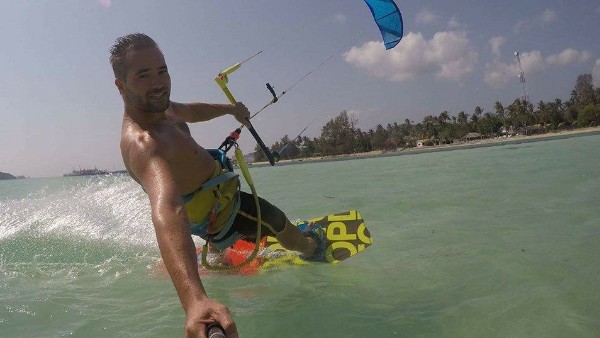
Photo: Accrokite Koh Phangan
The beach is one of the wildest on the coast, surrounded by coconut trees and tropical vegetation. It is more than two kilometers in length and is covered by blankets of fine white sand and bathed with turquoise waters, which invite you to dive in and practice kitesurfing. It is an excellent spot to learn the sport as it offers shallow waters. The wind and waves are quite small, so safety is almost guaranteed.
Hua Hin Beach
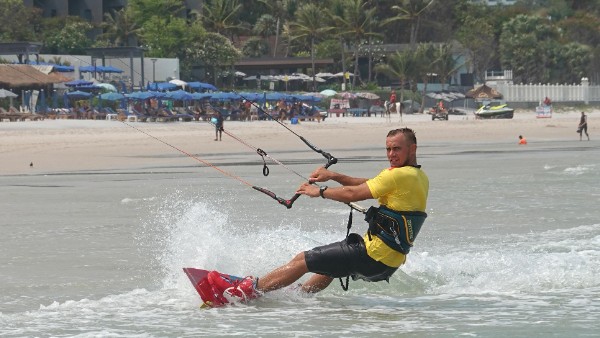
Photo: Kiteboarding Asia Hua Hin
The best time to visit Hua Hin is from the end of October to the end of March—and sometimes, until the beginning of April. The winds are ideal at this time, blowing at 14-16 knots every day. There is a large beach, small waves, and lots of flat water—easy and friendly conditions. 12-14 and 16-meter kites are the most used here. Hua Hin is also a famous kite foil and wing foil location. There are many kitesurfing schools here.
Pranburi
The small town of Pranburi, located near Hua Hin, should draw more attention, yet, few people know about it. There is a beautiful beach to practice kitesurfing. It is best to come here in March. Pranburi is a favorite spot of the famous Kite Tour Asia (KTA), the place where world-famous kiters gather in March to compete in the Big Air discipline.
Phuket
The island's beach is quite long, providing a good base for the varied range of winds generated. The shallow, rock-free lagoons with smooth surface water make this island a great place for newcomers to the sport. The wind usually starts to appear in March and blows until September.
ABOUT THE COUNTRY
A Brief History of Thailand
Thai migration to Thailand began in the first millennium. Their most prominent states were the kingdoms of Sukhothai and Ayutthaya, which were constantly threatened by Myanmar and Vietnam.
Sukhothai is considered the birthplace of Thai culture. In 1782, Bangkok became the capital of Thailand.
English and Portuguese colonists began to threaten the kingdom. However, Thailand was the only country in Southeast Asia that did not become a European colony.
King Chulalonkorn, who ruled the country from 1851 to 1910, was a good diplomat, established trade relations with Great Britain and France, and set about modernizing the country by inviting foreign experts.
Thailand was formerly known as the Kingdom of Siam and was only officially named Thailand in 1939. The term Thailand also means "land of the free."
At the outbreak of World War II, the nation secretly negotiated with Japanese forces and allowed them to use its land to invade Singapore, Burma, and the British-ruled Malay Peninsula region.
In 1997, Asia experienced an era of financial recession negatively impacting the Thai economy. This period is known as the "Asian financial crisis."
Bhumibol Adulyadej, the world's longest-ruling monarch with more than 70 years of reign, died in 2016 at the age of 88. This made Crown Prince Vajiralongkorn the new King.
A new structure has been drawn up and signed by King Vajiralongkorn, which means democracy has been restored in Thailand.
Other Attractions in Thailand
A very interesting thing to see is the Pattaya Floating Market. It is divided into four different areas and sells goods from different regions of Thailand. In this market, you can find eateries to suit all tastes, fruit stalls, souvenir shops, and art galleries. There are shows every afternoon. If you want to get an even better feel for the rhythm of Pattaya's floating market, hire a local boatman to take your boat around the market.
For those interested in Thai history and culture, Ayutthaya is a must to visit. This city is a UNESCO World Heritage Site. Thailand's old capital with the ruins of a four-hundred-year-old kingdom, temples, monuments, and spectacular parks. Ayutthaya Historical Park has many interesting and magnificent buildings such as Vat Phra Si Sanphet, which includes three large temples and the old royal palace. Wat Chaiwatthanaram is a Buddhist temple with 120 seated Buddhas. And the highlight of the area is Phra Mongkhon, a huge golden statue of Buddha.
The Golden Triangle is perhaps the most famous attraction in Northern Thailand. The area is the most popular tourist destination in the world, where the borders of three countries (Thailand, Myanmar and Laos) intersect. The name of the area comes from the drug trade that once flourished here. Besides that, the Golden Triangle is home to many small ethnic groups who preserve ancient customs and dress in traditional costumes.
Getting to Thailand
The most common way to get to Thailand is by air. Most travelers stop over at European or Asian airports to fly to Bangkok's Suvarnabhumi airport, although the capital also has Don Muang, which was built earlier. Once in Thailand, it is possible to fly to other tourist destinations far from Bangkok on domestic flights—Thailand has several companies that allow good coverage and frequency of routes. The islands of Phuket and Koh Samui have airports.
Thailand has six international airports: Bangkok, Phuket, Ko Samui, Krabi, Chiang Mai and Hat Yai. Most international flights, especially those from other continents, arrive at Bangkok's Suvarnabhumi International Airport. There are also quite a few charter flights landing in Phuket and, to a lesser extent, in Samui or Chiang Mai. To get reasonable prices during the high season, especially from late November to late February, it is necessary to book the flight several months in advance.
For closer destinations you can opt for the train, road transport, or ferry if you are going to move to the islands.
USEFUL RESOURCES
SIMILAR KITESURFING DESTINATIONS
SPOT
WORLD > ASIA > THAILAND
KOH PHANGAN
Koh Phangan is an island of incredible beauty in the Gulf of Thailand famous for its unique Full Moon Party—a wonderful three-night celebration in the middle of the wilderness. Apart from the noise, the music, and the excitement, the island offers a haven for a blissful holiday.
HIGHLIGHTS
FULL MOON PARTIES
The famous beach party takes place every full moon on the five kilometer long Haad Rin beach. The deafening music, trendy DJs, alcohol buckets, and crazy atmosphere will be a lasting memory even for those who don't really like going to clubs and discos in their everyday life.
ELEPHANT RIDES
Without the noisy parties, you can navigate your way through a tropical jungle on the back of an elephant. Tourists can visit the jungle on their way through the island. Before the trip, you can watch the elephants bathe and feed the baby elephants with your own hands. At the end of the tour, you can thank your elephant by feeding him whole pineapples.
WAT PHO TEMPLE
This temple is located in the southwest of the village of Baan Tai and is the most important temple on the island. The current Buddhist temple is open to the public. Although it has a sanctuary where you can pray, the most striking features are its herbal sauna surrounded by a lush forest and a fish pond as well as its massage center (which is particularly effective after a party or an intense kitesurfing session).
WILD BEACHES
The island's coastline is carved by bays and lagoons with narrow strips of white sand beaches and crystal clear waters that offer a picturesque landscape. The most beautiful sunsets can be seen from the beaches in the south of the island where you can rest and disconnect. On the east coast there is hardly any tourist development, therefore, the beaches and coves are practically wild. Some other famous beaches are Chalok Lam, Mae Haad, Ko Ma, Ao Chaloklum.
KITESURFING IN KOH PHANGAN
Koh Phangan is an island located in the southern gulf of Thailand and is known mainly for its relaxed atmosphere and wild parties, but also for its spiritual side and the hippy lifestyle it offers residents. In this little piece of paradise you can find a number of kitesurfing spots and schools. Kitesurfing on the island became one of the most fashionable, vibrant, and progressive trends. Most of the kitesurfing schools are located on the south coast of the island (Baan Tai and Tong Sala), which have huge lagoons of shallow flat water protected by a reef. Due to the shallow flat water, it is a very good place for students to practice and one of the best kite spots in Thailand for beginners to learn. Keep in mind that the shallow beaches of Koh Phangan have coral reefs, which means that sharp stones, corals and sea urchins are present.
Wind, weather and water
Koh Phangan has a tropical climate with high humidity levels and pleasant annual temperatures ranging from 24 °C to 32 °C. As in the rest of Thailand, it has two distinct seasons: dry and rainy.The wind season starts in January and lasts until April or May when the wind comes from the southeast. Winds are quite stable and range from 10 to 20 knots. This is also the dry season with very pleasant temperatures. February and March are the best months for kitesurfers to visit, as they have an average of 75% of windy days during this period.
The second season starts from July to October when the wind comes from the southwest. At this time of the year, there can be occasional/intermittent rain storms that can bring strong winds, sometimes more than 20 knots. This is a good time for experienced kiters. The two rainiest months are from mid-October to mid-December. In these months there is almost never any wind.
December is the only month when the wind comes from the north. At this time the only good kitesurfing spot is Chaloklum (on the northern side of the island). This spot can get a bit crowded, as all the kitesurfing schools come here during these few weeks.
WHAT ARE THE BEST BEACHES FOR KITESURFING IN KOH PHANGAN?
BAAN TAI BEACH
Baan Tai, on the south coast of Koh Phangan, stretches from Haad Rin to Thong Sala, making it the longest stretch of coastline on Koh Phangan. The 8 kilometer long beach has different landscapes: rocky with palm thickets and snow-white sand cloth under the blazing sun. But there is one thing that never changes, and that is the turquoise color of the water. Baan Tai is an ideal place for lovers of the sun, water sports and parties until dawn. When the wind blows, Baan Tai is an ideal place for kitesurfing.
The entrance to the water at some places is difficult thanks to underwater vegetation, boulders, and rocks. The bottom is quite shallow, affected by the tides.
Wind direction: West Southwest, West (from 8 to 16 knots, onshore)
Water conditions: flat, choppy water (the water temperature is, on average, 28 degrees)
Discipline(s): freeride, freestyle
Skill level: all levels
Watch out for: (hazards) coral reef and rocks
Getting there: with improved roads and new infrastructure connecting more areas of the island, getting to the beach is super easy. You can arrive by tuk-tuk, taxi, motorcycle, or a car.
Tip: regularly check wind and tide conditions; no need to bring a wetsuit.
CHALOKLUM BAY
The beach is three kilometers in length abd is one of the quietest. It’s there where you can enjoy a swim, take a nap, or kitesurf without stress.
Due to tides, the water levels at some points are low, however, you will have plenty of space to launch and land your kite. Watch out for the sharp coral reefs lurking under the water that can cut your feet. There is a possibility you will encounter box jellyfish, too. Therefore, exercise caution while kitesurfing.More experienced kitesurfers tend to head to Chaloklum Bay in December as, it is the season when the north (stronger) wind kicks in.
Wind direction: West Southwest, West (from 10 to 20 knots)
Water conditions: flat, choppy water (water temperature on average 28 degrees)
Discipline(s): freeride, freestyle
Skill level: all levels
Watch out for: (hazards) coral reefs, jellyfish
Getting there: Easily accessible by motorcycle or taxi boat. You can also park your motorcycle or a bike at some point on the road and enjoy the walk from there.
Tip: the road has ups and downs, and therefore if walking on a sunny day, don’t forget your sunscreen.
TRAVELING TO KOH PHANGAN AS A KITER
Getting There
There are no direct flights to Koh Phangan Island, however Koh Phangan is easily accessible by ferry, speedboat, or boat from the coastal town of Surat Thani or Koh Samui. The fastest and most convenient option to get to the island is by taking a flight from Bangkok to Koh Samui island, which is super close to Koh Phangan, and then board the ferry for a wonderful journey to Koh Phangan. From Samui, the boat takes passengers to Koh Phangan in half an hour.Another alternative way to get to the resort is to fly from Bangkok to Surat Thani Airport in Thailand and pick up a ferry from there. A ferry or boat from Surat Thani takes slightly longer.Finally, it is always possible to take a car to the Donsak port to reach the ferry, but it can be a long and exhausting drive (depending on where in Thailand you are traveling from).
Accommodation
Over the last few decades, the island has developed new hospitality infrastructure, including many hotels. You can easily rent a room or stay in a guest house with amenities for a very reasonable price, or you can stay in a bamboo house, wooden chalet or bungalow with almost no amenities and hot water. You can rent an inexpensive bungalow on every beach.
During the party season, the price of accommodation rises significantly. The further the hotel is from Haad Rin beach, where the parties take place, the cheaper the rooms.
It is advisable to book a room before your trip, especially for the period when parties are planned on the island.
Getting Around
Transportation does not cost much. The best option is to rent a motorcycle as you will be able to visit all the places on the island at your own pace. Filling the tank of the motorcycle costs about €2.
If you don't like to drive, you can take a cab or hire a famous tuk-tuk.
To visit small secluded beaches, you can also use "sea taxis."
Food and Drink
Koh Phangan serves delicious cuisine on every corner, so food lovers won’t be disappointed either. The food is affordable, rich and tasty, but spicy in some dishes.
There are plenty of places to eat on the island. The restaurants are for all kinds of people, as we find options for all tastes: international food, local food, vegetarian options, or more exotic dishes.
Like so many other locations in Thailand, Koh Phangan also has its own street market. The Thong Sala market, also known as Phantip Night Food Market, has a multitude of stalls with the most typical Thai street food dishes: kebabs, curries, fruit shakes, pad thais, and much more.
No Wind?
If there is no wind for kiteboarding on a given day, you won't have too much trouble finding other activities. The island's beaches are the most attractive and fun part of the island. There are also beautiful waterfalls and natural landmarks. Such as Nei Sadet Park. You can go there at any time at your convenience without any entrance fee. Admire the cascading Peang Falls and Lemo Lake surrounded by coconut palms—these are great places to relax. A must-visit is Wat Thong Sala Temple.
The most common activities on the island are snorkeling, scuba diving, boat riding, jungle treks, cooking classes, and muay thai classes.
Besides, what could be better than a good massage after an intense day of kitesurfing? You can get an excellent massage at one of the many Thai massage stores, and it will cost you around €10 per hour. Many kite spots even have massage spots right on the beach—afterwards, you'll feel revived and ready to get back in the water!
USEFUL RESOURCES
Peru is still an unpopular kiteboarding gem. It is now becoming regarded as one of the countries with the best waves in the world. The reason they are so revered is because they are slow, predictable and gentle even when big. This makes it an excellent place to learn to ride waves or improve your level. Though do not worry - Peru is filled with various flat water locations that are perfect for learning and practicing freestyle.
If you decide you want to take a break from kiteboarding and do something else - you will have many activities to take part of. For example, Peru has been referred as the leading culinary destination for three years running which means you will have many great restaurants to visit. Apart from eating you can indulge in some of the nightlife it has to offer. When you are done with that if you’d like to branch out during your stay, you can explore its mountain ranges or go surf some of the best waves in the world.
Capital: Lima
Currency: Sol
Level: Beginner to Professional
Winds: 10-30+ knots
Kites Needed: Small 5-7 / Medium 8-10 / Big 11-14
Waves: Yes; 0-2m
Flat Water Spots: Yes
Beach Break Spots: No
Wetsuit Needed?: Yes/No depends spot and time of the year
Water Temperatures: 20-22°C
Uncrowded Waters: Yes
Kiteboarding Lessons Average: 50-75 USD Per Hour
Average Good Meal + Drink Price: 8-15 USD
Nightlife: Some depending on location
Amazing Downwinders: Some depending on location.
New Zealand is one beautiful destination that doesn’t get the credit it deserves in the kiteboarding world. It has countless of kite-able spots with excellent conditions and amazing backdrops. Apart from great kiteboarding,it has countless of activities and places to see to make it worth the trip.
If the wind is not on, you will not be bored. You can explore the NZ landscapes, coastlines or get the blood rushing by bungee jumping, skydiving, zip lining or rafting. Apart from that you have countless of other activities like visiting White Island or Hobbiton, the famous set location of the Lord of the Rings.
If you have been to Australia before, or are debating between Australia and New Zealand. Consider New Zealand, as it is still a hidden kiteboarding gem.
Capital: Wellington
Currency: New Zealand Dollar
Level: Beginner - Advanced
Winds: 10-30 knots +/-
Kites Needed: Small 5-7m - Medium 8-10m - Big 11-14m
Waves: Yes, 0m-3m
Flat Water Spots: Yes
Beach Break Spots: Yes
Wetsuit Needed?: Yes, even consider using booties - cap - gloves as well.
Water Temperatures: 12-20°C
Uncrowded Waters: Yes
Kiteboarding Lessons Average: 50-75 USD Per Hour
Average Good Meal + Drink Price: 10-25 USD
Nightlife: Yes, depends on the area
Amazing Downwinders: Yes, some for example 25km between Waitotara and Whanganui.
Tranquil historic towns, welcoming locals, towering mountains, the Amazon rainforest, rivers, valleys, waterfalls, and vast stretches of coastline on the Caribbean Sea and the Atlantic Ocean are what strike travelers when they first visit Colombia. Besides unparalleled landscapes and sunsets, Colombia offers a vacation full of adventure and adrenaline while practicing watersports such as kitesurfing.
HIGHLIGHTS OF COLOMBIA
BIODIVERSITY
Colombia is one of the most biologically and culturally diverse countries around the world. It is estimated to possess 15% of the biodiversity on the planet, meaning it has the highest number of flora and fauna species by area in the world. You can find vibrant cities, the Tatacoa Desert, coffee plantations, volcanos, and even snowy areas in its borders.
GASTRONOMY
Colombian gastronomy is as diverse as its nature and cities and can be defined as a fusion of other cultures, mainly Spanish and African, complemented with typical dishes of each region of Columbia. Typical Colombian dishes such as bandeja paisa, mote de queso costeño, sancocho, arepa, mute santandereano, and carne a la llanera (among many other Colombian gastronomic delicacies) will certainly be a delight.
NATIVE CULTURE
Colombia is one of the countries with the greatest number of native tribal communities in Latin America. With over 100 ethnic groups, 65 of whom have retained their own native languages. Recognizing, caring for and preserving their cultural life and wisdom is essential for the retention of Colombia’s history.
MUSIC
Columbia is named the land of a thousand rhythms. From African beats, Spanish and European influences, to tribal sounds, you can find everything. The Cumbia and Bambuco are the most representative dances of the country abroad. Amongst other popular genres, there is also the Salsa, Champeta, Salsa Choke, Bullerengue, Curralao, and Vallenato.
KITESURFING IN COLOMBIA
Columbia as a kite destination has enormous potential. It is gaining more and more followers to the sport everyday, and people are squeezing the best out of it. The motives? Colombia has close to ideal wind conditions, diverse spots, and more and more options for lodging and learning centers. For strong wind lovers, Santa Veronica or Cabo de la Vela are the spots to go. If you like green hills and calm murky water, you can go to Lago Calima. San Andres will allow one to kitesurf in turquoise blue water. The water in the Caribbean is clear and still, and in the Pacific, fairly wilder. You can also experience some really fantastic and exciting kitesurfing spots in the Pacific Ocean. Jump into the waters, test your spirit of adventure, and take off in big jumps. Recently, Colombia has become the first stop on the GKA world tour. The tour continues to 16 more destinations, from Dakhla (Morocco) to Fuerteventura (Spain) and Ceará (Brazil). Overall, Colombia is one of the most worthwhile kitesurfing destinations to visit on a kitesurfing trip to South America!
WHEN IS THE BEST TIME TO KITESURF IN COLOMBIA
In Cabo de la Vela the wind is especially strong and blows between 25 and 35 knots continually. The low wind season is from May to June, and the unstable and gusty wind blows from 15 to 25 knotsalthough it hardly ever blows less than 15 knots. The prime time to kitesurf is very early in the morning or later in the afternoon when you can expect steady winds.In Cartagena, the main season starts in the month of December and ends at the end of March. Santa Veronica is comparable to Cartagena but has a second season from June to August. Calima Lake has navigable winds 360 days a year and offers a warm tropical climate, making it the water sports capital of Colombia. The weather, on a warm day, can be between 27 and 35°C, and in a cooler season it can range between 20 and 27°C.
WHAT ARE THE BEST KITESURF SPOTS IN COLOMBIA?
Cabo de la Vela
This spot is particularly remote and it takes around 3 hours to drive from the last city Uribia, desert of Guajira. The region is home to the Wayuus tribe. Wayuu means ‘people of the sun, sand and wind.’ And indeed, the wind is strong and the direction is offshore. Suitable for more experienced kitesurfers, Cabo de La Vela is also a well-known tourist attraction for surfers and non-surfers alike, as it not only offers the option to practice water sports, but also has splendid landscapes with lodgings in front of the beach and local premeval ranches.
Santa Veronica
Santa Veronica, situated 45 minutes from Cartagena, is an area increasingly attracting kitesurfing enthusiasts to enjoy a good surf, allowing them to advance in the wave mode.It is definitely a wave spot, with strong winds up to 45 knots, and is great for big air and strapless freestyle. The climate is typically humid and tropical with an average temperature of 30°C.
Mayapo, RiohachaMayapo is another remote area that provides plenty of space to practice kitesurfing. It is located next to the capital of the tribal territory de los wayuus Riohacha. Riohacha is a city that you cannot miss for its unique combination of desert, sea, and culture—which is the attraction of the city. This spot is windy almost all year round, and the season runs from December to August with September/October being the least likely months due to the heavy rains.
Lago Calima
Roughly 2 hours north of Cali is Lake Calima, which attracts kite and windsurfers throughout the entire year due to the consistant wind conditions. Due to its geographical position, this place receives winds of up to 43 knots, making it the third lake in the world to have extremely strong winds—and the first in America. The lake is widely known as one of the largest artificial lakes in Colombia. This is an extra-mystic kite spot that offers a high chance of kiting with rainbows, as it is often foggy.
CartagenaOne of Colombia's tourist attractions is the city of Cartagena, which not only stands out for its historic old town, its gastronomic attractions, and its great nightlife, but also for its beaches. It is perfect for kitesurfing and suitable for all levels. Between December and April you can kite at different spots close to the city. The closest spots are La Boquilla and El Laguito. You can go to Manzanillo (a 30 minute drive from city center) where the beach is emptier and prettier.
San AndrésSan Andrés is an exotic island with a sea of seven colors positioned further away from Columbia mainland in the Caribbean ocean. Due to its intertropical setting, the archipelago is distinguished by a hot climate that registers an annual average of 27.3°C. Hundreds of kitesurfers take advantage of the constant strong winds (of more than 18 knots coming from the north), and crystal clear, warm and choppy water to glide, jump, and fly over.
Macanal, BoyacaIt is no wonder that, in Colombia, kitesurfing is being practiced mainly on the coast in the ocean. But a few years back (and fortunately for the locals of Bogota), there is a new destination for kitesurfers that is hitting hard: the Macanal in Boyacá. The best time to go is between November and March, because the wind is good almost every day.
ABOUT THE COUNTRY
A Brief History of Colombia
Much of Colombia's history is closely connected to the history of Spain until its independence (discovery, conquests and colonization), where in 1886 Colombia emerged, like the other Latin American countries, as a unit with a claim to political independence following the Napoleonic invasion of the Iberian Peninsula. Throughout the 19th century, Colombia's path was mainly concentrated on the presence of two political-administrative trends: political centralism and federalism. The country experienced political tension and several civil wars until the so-called War of the Thousand Days in 1902 when the twentieth century started and made the country more prosperous. Gold mining and primary products such as tobacco were the basis of the economy until the coffee export cycle began. But despite sustained economic growth, the current Republic of Colombia is still highly unequal in income and opportunities. Drug-related violence and corruption serves as an obstacle to further growth, as well as deficiencies in education and infrastructure, which hinders insertion into the world economy.
Things to Do When There’s No Wind
There are times of the day when you cannot kitesurf, and these are the perfect times to experience the wonders of Colombia. The country surprises with its multiformity of landscapes, from as deserts to idyllic Caribbean beaches to lively cultural cities. Whatever you are looking for, you will find it in Columbia.As a result, you can enjoy the city life in Medellin, Cartagena, and Bogotá y Cali. Those are undoubtedly the most picturesque cities in the country. Take, for example, strolling through the historic center of Cartagena, with its narrow streets full of life, color, and atmosphere. It will be one of the great places amongst many others to see in Colombia.The capital of Colombia is another must-see. The Plaza de Bolívar, Barrio de la Candelaria, and the Plaza del Chorro de Quevedo, is where you will be able to see some of the coolest urban street art.Adventure seekers and nature fans can get in kayaks or boats and reach extraordinary waterfalls, hit some trails to walk and enjoy the vegetation, and (during the summer) sunbathe.Among the wide variety of activities available, the Colombian Amazon stands out. There, you can see animals in the wild or go fishing for piranhas. The Mundo Amazónico Ecological Park and Cahuinari National Natural Park are places where outsiders can observe the best of the Amazon's flora and fauna.
Getting to Colombia
There are several alternatives for routes to Colombia depending on your starting location. Most visitors arrive in Colombia by plane at one of the four main international airports: Bogota, Medellin, Cartagena, or Cali. Also, Colombia has borders with Panama, Venezuela, Brazil, Peru, and Ecuador, but there are only road connections with Venezuela and Ecuador. From Ecuador, Venezuela, and Panama, it is possible to arrive by car. Keep in mind that the road from Panama to Colombia has a jungle stretch in between, and cars must be shipped by boat to one of the Colombian ports. Cartagena, due to its privileged position, has an embankment port for not only cruise lines that travel the Caribbean, but also for sailboats, yachts, and other vessels. Unfortunately, there are no international rail connections.
USEFUL RESOURCES
SIMILAR KITESURFING DESTINATIONS
- Venezuela
- Brazil
SPOT
SANTA VERONICA
Santa Veronic is a little town located just in between Cartagena and Barranquilla, where no one is in a hurry, no one has a headache, and no one is planning long-term strategies. People live in the here and now—the slow and calm rhythm of the Caribbean.
HIGHLIGHTS
GALERAZAMBA SALT FLATS
The nearby village of Galerazamba has a reputation for its waters turning an intense pink color. Between February and March, one of the phenomena that most attracts tourists is when the salt flats turn red. In addition, you can see salt dunes, salt pans, and pretty houses full of history and legends.
GASTRONOMY
It is one of the most beautiful beaches in Barranquilla with a quiet atmosphere for relaxation, and if you let yourself get caught by the marine delicacies served in the kiosks and stalls on the beach, you will be able to taste a bowl of delicious traditional rice with coconut, tostones, and fried fish with shrimp sauce (and don’t forget to hydrate and drink lots of coconut water, too). The Seafood Festival in May features a varied menu. The festival also has live music shows, traditional sweets, handicrafts, etc.
GLOBAL KITEBOARDING CHAMPIONSHIP
The prestigious Global Kiteboarding Association has added Santa Veronica, Colombia as its newest location. It will be the very first stop on the annual World Tour competition, bringing action and adrenaline to the daily lives of Colombian citizens.
THE SANTO DOMINGO DE GUZMAN CHURCH
Another important tourist attraction in Usiacurí town is its church. The white and blue Santo Domingo de Guzmán Catholic church, which was built in 1892, stands vigilantly on one of the highest hills in the area retaining its original materials and adding up to the already rich architectural heritage of Colombia.
KITESURFING IN SANTA VERONICA
The beaches of Juan de Acosta (Santa Veronica) have long become an ideal and unique destination for water sports, which attracts hundreds of national and international tourists due to its perfect conditions that include breeze, good waves, warm temperatures, bright sun, flat water, uncrowded beaches, and a beginner-friendly set-up. The stretch located on the Caribbean Coast of Colombia between Cartagena and Barranquilla (in particular Salinas del Rey beach) has received enormous attention from the top athletes and international competition organizers of the high kitesurfing league. For the first time in history, the World Kitesurfing Championship has made a stop in Colombia (Salinas del Rey) and has hosted the best of the best kitesurfers from 30 different countries, making Santa Veronica one of the best destinations in America to practice kitesurfing.
Wind, weather and water
Even the most traveled and experienced kiters may be surprised by the conditions in Santa Veronica, which include a permanent breeze from early in the morning until late in the afternoon, allowing kitesurfers to easily practice the sport due to the reliability of the wind. The average wind speed in the stretch is about 20-30 knots during the peak season with a water temperature between 25 to 30°C, so you can leave your wetsuit at home. The water conditions are a combination of flat and choppy with some 1-meter waves, depending on the beach. The direction of the wind is onshore and side-onshore, making it convenient for downwind safaris and for beginners to easily learn the sport. Since the destination is still ramping up in popularity, the beaches are quite deserted and uncrowded, making enough room for kitesurfers to enjoy the ride freely and for beginners to learn in maximum safety conditions. More experienced wave kitesurfers will find the area amusing, as they will be able to catch some great waves. It is worth mentioning that the spot is tide-independent, therefore, you won’t be tied to a schedule or need to keep on top of high and low tides.
WHAT ARE THE BEST BEACHES FOR KITESURFING IN SANTA VERONICA?
Salinas Del Rey
Situated on the northern Caribbean coast of Colombia outside the small fishing village of Santa Veronica, the site of Salinas del Rey is world-famous for its combination of extremely good wind conditions, flat water and waves, and warm weather and landscapes. The primary wind season in Salinas del Rey starts in January and goes throughout April, with daily constant winds averaging between 20-35 knots. From May through July, the wind is (on average) 15-25 knots.
The predominant wind direction is from the NE, making for a side-onshore breezes and an average 30°C temperature—allowing one to ride in board shorts and bikinis all year long.Wind direction: N-NE, side-onshore, between 20-35 knots
Water conditions: Flat, choppy, 1-2m waves
Discipline(s): Strapless wave-riding, freeride, downwindSkill level: all levels: From beginner to advanced riders
Watch out for: (hazards) Waves may be up to 3 meters, be aware of strong currents too
Getting there: From the two international airports Barranquilla (just 45 minutes away) and Caragena (1 hour 20 minutes away), catch the coastal bus all the way to Santa Veronica/Salinas del Rey. The most common form of public transport in Salinas are the taxis, also known as tuk tuk’s.
Tip: Bring your small set of kites. No wetsuits are needed
Palmarito
Palmarto is situated 5 kilometers upwind from Salinas del Rey beach. As in Salinas del Rey, more than 90% of the days are navigable during the high season (from December to May). It is a relatively undiscovered kitesurfing location and, therefore, not crowded. It’s a flat spot ideal for freestyle or learning how to kitesurf. It mainly boasts small waves and chop.
Wind direction: N-NE, side-onshore, up to 27 knots
Water conditions: Flat, choppy
Discipline(s): Strapless wave-riding, freeride, downwind
Skill level: from beginner to expert
Watch out for: (hazards) None
Getting there: Same as going to Salinas del Rey, as Palmarito is very close by.
Tip: It’s famous for its coconut water.
Puerto Velero
This spot is located around 10 kilometers upwind of Santa Veronica. There is a wave spot as well as a flat water lagoon divided by a pretty sandbank. Schools (besides giving classes, renting boards, and kites for your complete enjoyment) also offer guided downwind tours from the spot to Santa Veronica. Puerto Velero is an excellent place for beginners because of the lagoon. Thehe water is typically flat and the wind is strong with side-onshore and sideshore conditions. For advanced riders, you can reach a wilder spot with great waves and wind with three types of conditions ( side-onshore, side-shore and side-offshore) within a five minute walk.
Wind direction: NE, side-onshore, side-shore, side-offshore, between 15 -25 knots
Water conditions: Flat, choppy, waves up to 2 meters
Discipline(s): Strapless wave-riding, freeride, downwind
Skill level: All levels, from beginner to expert.Watch out for: (hazards) windy, may be gusty at times
Getting there: Marina Puerto Velero is located only 25 minutes from Barranquilla and 50 minutes from Cartagena by car or public transport.
Tip: If there’s no wind, try some wakeboarding at the spot.
TRAVELING TO SANTA VERONICA AS A KITER
Getting There
Santa Veronica is well-connected to the rest of the world via the airports of Cartagena and Barranquilla. If it happens that you are coming from one of these airports, the shortest and most optimal road route from Barranquilla to Santa Veronica (distance is 41 km with an approximate travel time is 50 min), would be by car. Similarly, to arrive from Cartagena would take around 1 hour 30 minutes (roughly 81 km). The other option would be to take public transport from the terminal bus stops in Cartagena and Barranquilla. The trips are very pleasant and relaxing, as the routes are taken by the coast and the buses are in excellent condition driven by competent drivers. Another form of travel would be to take a taxi. Although it is the quickest and most comfortable alternative, it is also the most costly.
Accommodation
As Salinas del Rey has become a reference point in the kitesurfing sector due to hosting the GKA Kite World Tour event, it also offers great opportunities for the national and international tourism sector. As a result, various types of accommodation options exist in Santa Veronica. It is relatively easy to find and book unique accommodations online starting from hotel rooms and apartments, to huts, bungalows, and even entire luxury villas. Some of the favorites among kitesurfing enthusiasts are Kite Eco House, Casa Kite Surf, Villa Kite House, and Palomar Cabaña.
Getting Around
There are a number of decent restaurants, a variety of nice hotels and other accommodation establishments, and small stores and supermarkets. Everyday transfers in tuk tuks are to most used by tourists. They are easy to find and almost always available. Other public transport includes scheduled city buses or private taxi hires. You can also rent a scooter— however, it is important to be careful on the roads because the traffic is relatively wild and intense.
Food and Drink
Even though some restaurants may be deserted, abandoned, and closed, there are some great food and beverage establishments, too. Most of such are seafood, and they’re situated on the beautiful beaches of Santa Veronica. You can find international dishes such as mofongo from Puerto Rico and traditional dishes from the Colombian coast such as fried mojarra, coconut rice, and patacones. Beach clubs have been specially designed for tourists to enjoy unforgettable moments contemplating the Caribbean Sea, have the best tanning day, and offer all the tranquillity of an exclusive place in front of the sea. Another great thing about Santa Veronica is that typical dishes are served right on the spot while visitors are relaxing in hammocks that are set up on the beach.
No Wind?
During windless days, visiting the native tribes could be a great educational opportunity, as Tubará town is well-known for its ethnic past. The Lodo el Totumo volcano is an incredible natural attraction because of the great healing and therapeutic qualities of its mud. The ritual is to typically immerse yourself from head to toe in the mineral-rich mud and warm, sulphuric waters. It is one of the few volcanoes in the world where you can dive without any problems. The medicinal characteristics of the mud are due to the ingredients it contains: water, silica, aluminum, magnesium, sulfur, calcium, iron, and more minerals. The area is also famous for its yoga practices. It has a tradition of holding yoga retreats and workshops with professionals and instructors who, with love and knowledge, will help anyone advance in yoga. It is a great option for kitesurfers looking to stretch their muscles.
USEFUL RESOURCES
As time passes, Mauritius becomes ever more popular within the kiteboarding community. Both beginners and world class riders visit this island because of its picturesque beauty and amazing conditions. In Mauritius, you will find flat water spots as well as amazing waves to ride. The main season lasts 4 months though throughout the year you have a chance to get winds.
If you visit Mauritius and want to do more than just kitesurf; you have various other activities to choose from! You can go scuba diving, stand up paddle boarding, deep sea fishing, scuba diving, catamaran cruises, parasailing and more. If you are a beginner thinking to learn in Mauritius or a wave rider considering to surf One Eye in Mauritius- we have one recommendation… do it.
Capital: Port Louis
Currency Mauritian Rupee
Level: Beginner-Professional
Winds: 10-35 Knots
Kites Needed: Small 6m-9m / Big10m-14m
Waves: Yes
Flat Water Spots: Yes
Beach Break Spots: No
Wetsuit Needed?: Not necessarily though full wetsuit recommended.
Water Temperatures: 23-29°C
Uncrowded Waters: Yes
Kiteboarding Lessons Average: 50-80 USD per hour
Average Good Meal + Drink Price: 30 USD
Nightlife: Yes
Amazing Downwinders: Yes
Kitesurfing in the United States is bound to be a blast as the country's massive size and varied geography offers something for every level of kiter in every discipline. Whether you’re into ocean kitesurfing, flat water slicks, lake or river kitesurfing, you can find it in the US. The country has hundreds of kiting destinations and some of the best kiting conditions for every month of the year.
HIGHLIGHTS OF THE UNITED STATES
A VARIETY OF KITESURFING CONDITIONS
The United States has a spot for every level of kiter for every discipline. The East and West Coasts offer amazing wave kitesurfing, and the interior of the country has plenty of lakes and rivers that offer great kite conditions.
A NATURE LOVER’S PARADISE
The United States has more geographical diversity than any other country in the world. You can surf or kitesurf giant waves in Hawaii, hike Everest-like Mountains in Alaska, snowboard in some of the best powder in the world in Colorado, flyfish world-class rivers in Oregon, and trek through beautiful deserts in Utah.
CULTURAL DIVERSITY
According to a US Census Bureau survey from 2015, there are over 350 languages spoken in the United States. A long-time sanctuary for immigrants, the US still attracts people from every part of the world. The diversity of culture can be experienced in a variety of ethnic foods, music, and traditions available in the states.
EXCITING CITIES
If you’re both a nature and city lover, the United States has a number of exciting cities that offer some of the best restaurants in the world, world-class art collections and entertainment, and top-notch healthcare facilities including the Mayo Clinic and the Fred Hutchinson Cancer Research Center.
KITESURFING IN THE UNITED STATES
It’s hard to compare kitesurfing in the United States to any other country because the US has such a varied landscape offering something for every kiter. Kitesurfing in the United States is as diverse as the country’s culture.
WHEN IS THE BEST TIME TO KITESURF IN THE UNITED STATES?
Luckily for American and visiting kiters, you can kitesurf in the United States all year round. Whether you’re kiting on the California Coast (in the West) or Cape Hatteras (East Coast) from April through October, or chasing wind and waves in Hawaii from November through March, you can find wind and great kite spots all over the US.
It might be obvious for us North Americans, but it’s worth mentioning that many spots are less active from November through March. There are definitely hard-core winter kiters in the US, but many of them wear very thick wetsuits or drysuits.
WHAT ARE THE BEST KITESURF SPOTS IN THE UNITED STATES?
Kitesurfing is done in almost every state in America, and American kiters are no different than kiters in other parts of the world. If they can’t travel to kite the best spots in the country, they make the best of their local spots. That said, there are some renown spots worth mentioning that attract international kiters and domestic water addicts.
Cape Hatteras, North Carolina
Cape Hatteras Island, also known as the Outer Banks, is one of the most well-known kiteboarding spots in the United States. The area has some of the most consistent winds, and--more notably--there are kiting spots for every wind direction. Cape Hatteras offers both oceanside waves and flat bayside kiting, which makes it ideal for beginners and flat water junkies who visit Hatteras to kite the famous glassy slicks. There are bayside and ocean launch spots all along Cape Hatteras Island, starting in Rodanthe and continuing down about 25 miles past Buxton, NC.
Hood River, Oregon
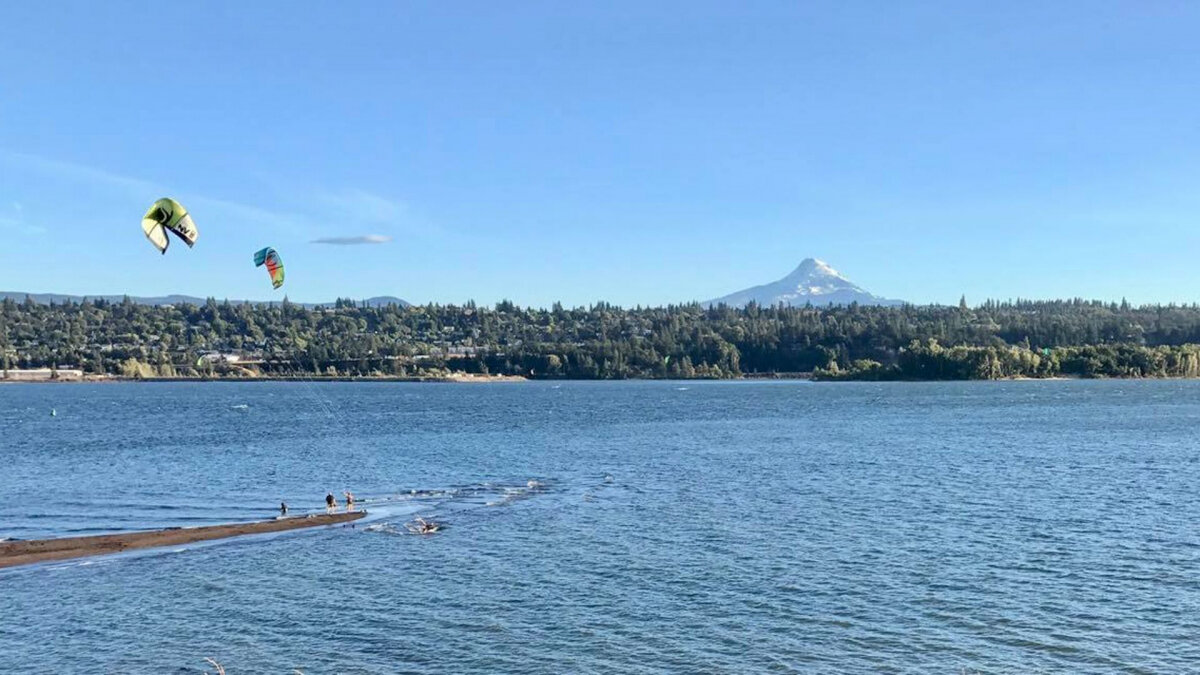
Referred to as “the Gorge,” Hood River is often regarded as the birthplace of kiteboarding in the United States. All kiting is done on the Columbia River, which flows east to west towards the Pacific Ocean. The wind, during the most popular kiting months of May to August, blows west to east through a natural wind tunnel in this gorgeous canyon. Hood River is known for its strong, gusty winds, and the spot is host to one of the few Kite Parks in the world. Kite spots are located all along a 43 mile stretch of the Columbia, starting at the Cascade Locks and running to The Dalles, Oregon.
Miami, Florida
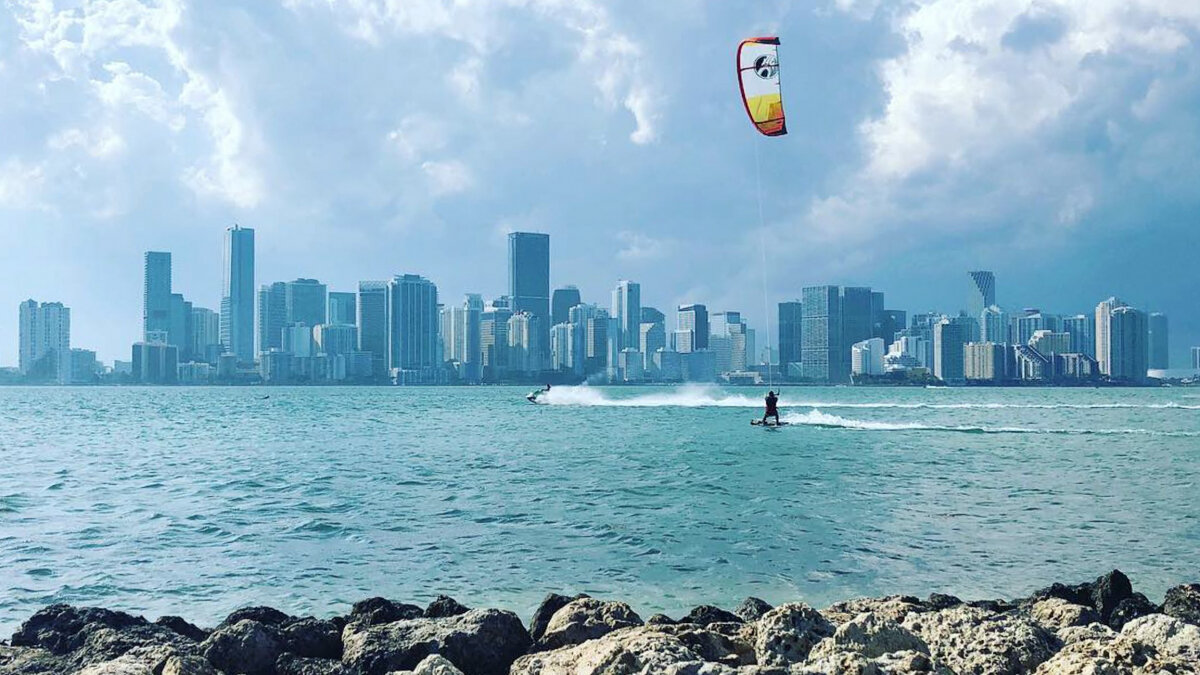
Located in southern Florida, Miami is a popular kite destination because of its beautiful, sunny weather. From November to April, the tradewinds offer consistent and reliable wind which is great for foiling and bigger kites. If you like kiting strong wind and massive waves, head to Miami between July and September during hurricane season. Miami has more rules and regulations for kitesurfing than most other cities, so it’s important to do your research and know all the rules before you go. If you drive about 90 minutes north, you can kite alongside some well-known kiteboarding pros in Jupiter, Florida.
South Padre Island, Texas
Like Cape Hatteras Island, South Padre Island is a barrier island that offers warm water oceanside and shallow, flat bayside kiting almost year-round. The island offers consistent winds averaging knots in the high teens. The wind is most consistent between March and July, and South Padre’s hurricane season is August through October. You can expect stronger, but less reliable winds during this time.
San Francisco, California
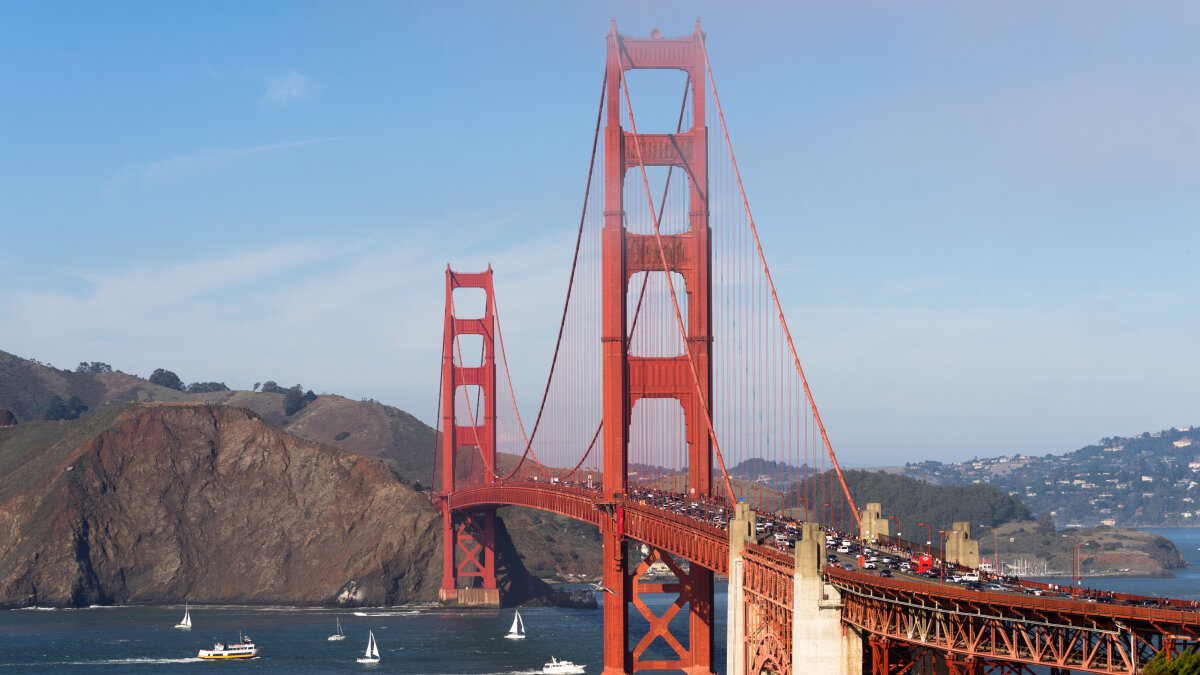
If you’re looking for that iconic photo under the Golden Gate Bridge, Chrissy Field is where you want to be. The spot is infamous for its gusty conditions, high volume of boat traffic and strong currents, but a lot of kiters will risk it for the photo opp. It’s an expert level spot for sure. But San Francisco has other great spots for beginner to advanced kiters, including Alameda and Third Avenue in San Mateo. The water is cold in the bay. You’ll be wearing at least a 3/2mm in the summer, but the wind is strong.
Long Beach, California
Belmont Shore in Long Beach is an ideal location for both beginners and experienced kitesurfers. This sunny Southern California spot has plenty of space for launching, a breakwater that blocks the waves and cross onshore thermal winds that are strongest from April to November. Long Beach will be the venue for the 2028 Olympic Games kitesurfing event, the spot hosts an annual kite expo and is only 30 minutes away from Los Angeles International Airport.
Sherman Island, California
Just an hour drive from downtown San Francisco, Sherman Island boasts some of the best kitesurfing conditions in the entire Bay Area. The water and weather are warmer than the bay, and the winds are very reliable during the summer months. Bring small kites for the strong winds, and get ready to have a great session.
Waddell Creek and Scott Creek, California
If you’re looking for great wave kiting, you’ll need to leave the bay and head for the ocean. Just north of Santa Cruz, both Waddell and Scott Creek offer great waves, strong winds, and a picturesque setting. Scott Creek has a beautiful point break, making it an excellent spot for new wave kiters looking for an easy drop-in. The waves are bigger from September through April, but the water is chilly, so bring a thick wetsuit.
Maui and Oahu, Hawaii
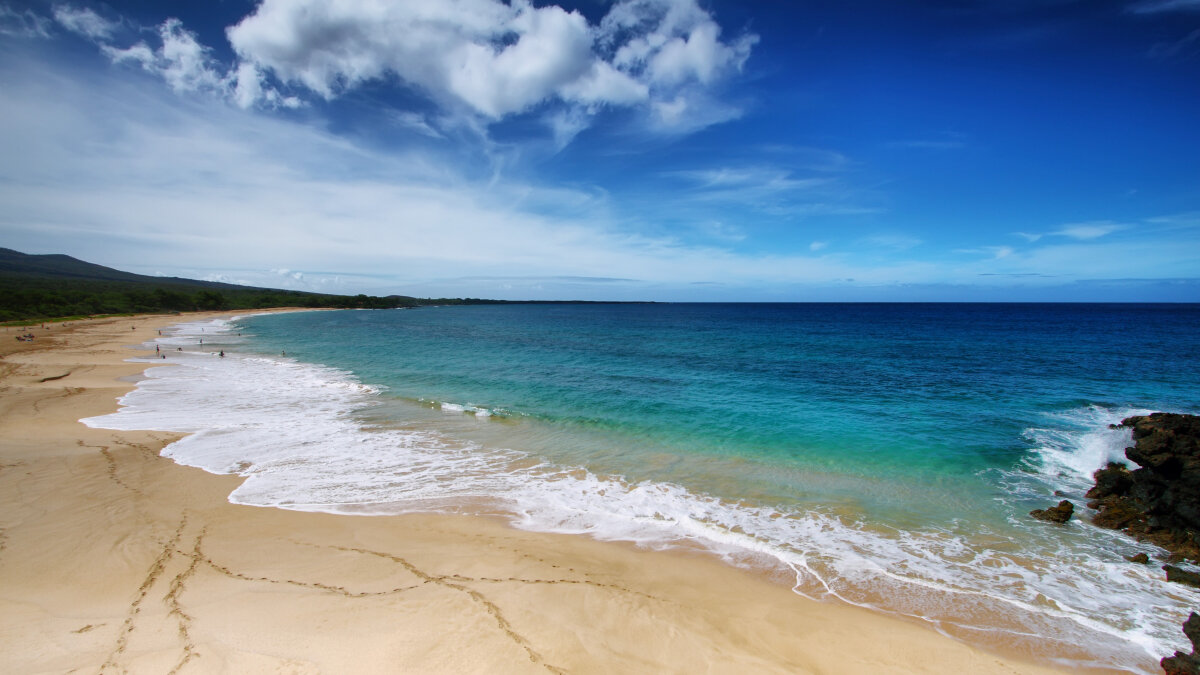
The Hawaiian Islands have attracted watersports fanatics for decades. The wind blows year-round, but the best months to kite are May through October. Although you can find wind on all of the islands, the most popular kitesurfing spots are located on Maui (Kite Beach) and Oahu (Kailua) where the winds blow anywhere from 15 to 35 knots. You can book a stay at one of the many resorts in Hawaii for an unforgettable kitesurfing experience. Kiters should be aware that all of the kite beaches in Hawaii have strict rules and regulations. For example, you can’t start kiteboarding on Maui until 11 am--which is tough when the wind is blowing at 9 am! It’s important that the locals and tourists follow the rules so that kiteboarding will continue to be allowed on the Hawaiian beaches.
ABOUT THE COUNTRY
Brief History of the United States
Founded by a bunch of rebellious Brits looking for personal freedom, the United States is now the world's largest economy and accounts for about a quarter of the global gross domestic product. The country has also made significant contributions to the kitesurfing community. In addition to being host to the very first King of the Air competition, the US is also headquarters for many well-known kitesurfing brands including Naish, Cabrinha, North, Slingshot and Crazy Fly. If kiting isn’t your thing -- and it probably is if you’re reading this post -- you can play pretty much every other sport invented in the US.
Other Attractions in the United States
Because of its size and diverse population, the United States has something for everyone. Whether you’re an outdoors type or city snob, you can entertain yourself in the US.
You can surf or kitesurf giant waves in Hawaii, hike Everest-like Mountains in Alaska, snowboard in some of the best powder in the world in Colorado, flyfish world-class rivers in Oregon, and trek through beautiful deserts in Utah.
A long-time sanctuary for immigrants, the United States still attracts people from every part of the world. The diversity of culture in the US can be experienced in a variety of ethnic foods, music, and traditions in most of its exciting cities.
Getting to the United States
Flying to and around the states is easy and convenient. Transatlantic cruises are available to the United States if you have the time, but we’re guessing that isn’t the kind of “on the water” time that most kiters are looking for.
Once you arrive in the States, car rentals are usually reasonably priced depending on the season. Keep in mind that American cars have the driver seat on the left side of the car, and cars are driven on the right side of the road.
The U.K. may be small, but it’s certainly mighty when it comes to kitesurfing! Some of the top pros in the kitesurfing industry were born and bred here in the U.K. You can kitesurf here all year round providing you're not scared of the cold and have invested in a suitable wetsuit.
HIGHLIGHTS OF THE UNITED KINGDOM
Easily Accessible
The U.K. is a reasonably small island in comparison to other countries around the world. This means it’s easy to travel between kitesurf spots and to discover new ones. No matter where you live or are staying during your visit, you will never be far from the sea! Being a well-developed country means that not only domestic travel is easily accessible by car and train but also international flights in and out of the U.K are very affordable and run regularly.
An adventure sports capital!
Whether you're into kitesurfing, surfing, stand-up-paddleboarding, mountain biking, climbing, trekking, or fishing... We have it all! The U.K offers such a diverse range of geographic locations making it suitable for almost any adventure sport you can think of.
Unrivaled historical sites
The U.K has some of the most famous historical sites in the entire world. A huge range of castles and fortresses such as The Tower Of London where you can see the Crown Jewels, Highclere Castle; filming site of the T.V drama Downton Abbey, or St Michael's Mount which is perched on top of its own tiny island and only accessible by foot at low tide.
The Great British Pub
Many countries try to replicate the Great British Pub but it's not quite the same as being here in the flesh. You'll do well to miss one as they are scattered all over the country offering great warming food and drinks. If pubs aren't fancy enough for you, major cities such as London, Edinborough, Manchester, Brighton have some world-class restaurants pushing the boundaries of what's possible to deliver on a plate.
KITESURFING IN THE UNITED KINGDOM
The most impressive part of kitesurfing in the United Kingdom is the variety of kitesurf beaches and the conditions which these different spots have to offer. If you're into big wave kitesurfing then the west coast of Ireland and Cornwall is where you want to look. Ireland is where the famous 'Red Bull Storm Chase' windsurf event is often held, check it out! If you're after reliable sea breezes then the South East is where you'll want to head. With the addition of foil boards, you'll be able to kitesurf almost every day of the year in the U.K. Providing you are willing to make the occasional trip to other nearby beaches which may offer a better wind direction on the day.
WHEN IS THE BEST TIME TO KITESURF IN THE UNITED KINGDOM?
Think of it in two halves... April-September (Our summer half) and October-March (Our winter half). Both have their benefits and their disadvantages.
April-September
Pros:
- Warm weather and sunshine
- Warm water (about 18 degrees is as warm as it gets in the U.K.)
- Long days, early sunrises and daylight until 10 pm in the summer months
- Regular sea breezes especially in the South East
Cons:
- Lighter winds
- Crowded beaches
- Small waves
October-March
Pros:
- Strong winds
- Regular storms
- Big waves
- Uncrowded beaches
Cons:
- Cold weather
- Coldwater temperature
- Short days
WHAT ARE THE BEST KITESURF SPOTS IN THE UNITED KINGDOM?
Pevensey Bay
Pevensey Bay is a hidden gem and only 1.5 hours from London! A shingle beach at high tide gives way to a beautiful sandy open beach at low tide. Home to Be-Rad Watersports Shop/School/Rental. This village and the surrounding area of Eastbourne is statistically the sunniest place in the U.K. This means you can rely on regular sea breezes, therefore increasing the number of days you'll be able to kite. A super safe bay for kitefoiling even in light winds! While you're there why not walk to Pevensey Castle? The landing place of William the Conqueror's army in 1066.
Best for: Twintip riding, Small/mediumwave riding, Kite foiling, Wing Foiling
Ideal wind direction: South-Southwest through to North-East winds are perfect for kitesurfing in Pevensey Bay.
Greatstone
Greatstone beach is a fantastic kite location. It is the perfect spot for learning how to ride upwind, master new techniques, or land your first trick. It is a very mellow spot with perfect flat water in between the small waves. Here you will find a vast sandy beach meaning there is plenty of space to launch and land kites.
Best for: Twintip riding, Freestyle
Ideal wind direction: North or North-East winds are favorable for Greatstone
Gwithian
Gwithian is one of the meccas within the U.K for wave riding, big wave riding, and storm sessions. Check out Sam Light's recent vlog showcasing some of the U.K's top pros sending it during storm Francis.
Best for: Wave riding, big wave riding, big air
Ideal wind direction: SW & NE for cross-shore conditions. Southerly winds are great but slightly cross off-shore, so only for experienced riders.
East Wittering
East Wittering is a fantastic all-in-one kitesurf spot. Here you can find waves, flat water lagoons, chop, and rolling swell. Directly at east wittering itself, you will find some great wave riding conditions. If you travel about 1km to the west you will enter West Wittering. West wittering is where the flat water lagoons are located. One thing to mention is that West Wittering is a member-only kitesurf spot, therefore best to check out the rules and regulations before trying to kite there.
Best for: Twintip riding, Small/mediumwave riding, Kite foiling, Wing Foiling
Ideal wind direction: Westerly through to South-East winds are perfect for kitesurfing in East Wittering.
Portland Harbour
This has got to be one of the best flatwater spots in the U.K! Portland is a small island just south of Weymouth town. Connecting Weymouth to Portland is Chesil beach. Winds from the South and West blow directly over Chesil beach and create a super flatwater offshore spot on the other side. Most offshore spots are for advanced kiters only, however, this spot is much safer and opens up the spot to intermediate riders too. It stays shallow for a relatively long distance downwind and you kitesurf within the walls of Portland Harbour which act as a barrier from the open ocean. You should still take care when kitesurfing at all offshore spots as they do present more dangers than cross-onshore spots.
Best for Flatwater freestyle riding, Kite foiling, Wing Foiling
Ideal wind direction: South, South-West, West
Camber Sands
Camber is already a well-known kitesurf beach within the U.K. Here you'll find a vast sandy beach at low tide and super reliable sea breezes. The wind funnels through the English Channel when blowing in the prevailing direction (South-Westerly), creating a Venturi effect that can increase the actual wind speed dramatically at spots on the South East coast such as Pevensey Bay and Camber Sands.
Best for: Twintip riding, small/medium wave riding, big air
Ideal wind direction: South-West
ABOUT THE COUNTRY
Brief History of the United Kingdom
The United Kingdom (commonly abbreviated to the U.K) is the merging/formation of the following countries; England, Scotland, Wales, and Northern Ireland. The U.K has long been a powerful and colonizing country and in relatively recent years, has been the birthplace of some world-known inventions such as the steam engine, turbojet engines, the World Wide Web, the lightbulb, the list goes on... For such a small country in comparison to the size of the globe, the U.K has an immensely rich and interesting history.
Things to Do When There’s No Wind
SUP
Stand-up paddleboarding is a great sport to take up for light wind days. The perfect conditions for paddleboarding are light winds, calm days, flat water. As you can tell these are the complete opposite conditions kitesurfers tend to look for therefore meaning when it's no good for kiting it's great for SUP. The U.K has a variety of coastal waters, rivers, lakes, and reservoirs to paddle along meaning there are always new places to discover.
Mountain Biking
Another exhilarating outdoor sport that works well with those light wind days is mountain biking. Whether you like trail riding, cross country riding, or even road cycling the U.K will have you covered. Bike Park Wales is definitely worth a visit and offers mountain uplifts so you can make the most of the descents.
Wakeboarding
Lots of cable parks have been popping up across the U.K in recent years. They are a great way to develop board skills and unhooked tricks. One of the top parks in the country has to be Liquid Leisure and being less than an hour from central London, it has to be on your to-do list!
Visit London
Offering such a unique vibe to any other city around the world, here you'll find famous attractions such as the London Eye, Big Ben, Tower Bridge, Buckingham Palace. It's a must-do!
Hike the Seven Sisters
The Seven Sisters chalk cliffs are a popular location for locals and international visitors who come to experience this magnificent stretch of coastline between Seaford and Eastbourne. Seven extraordinary cliffs with the tallest cliff in Britain, 'Beachy Head' reaching a massive 162 meters in height. A great option if you're kiting at Pevensey as this is only a twenty-minute drive.
Getting to the United Kingdom
Traveling to the United Kingdom is extremely accessible, it’s possible to travel by plane, boat, or even by train with Eurostar. This is an international high-speed rail service connecting the United Kingdom with France, Belgium, and the Netherlands. These trains travel underwater through the Channel Tunnel which connects the United Kingdom to France. If flying is more of your style, getting to the U.K from countries all over the world is easy. London Heathrow, the largest airport in Europe and well connected to central London offers international flights to and from many countries. Other key international airports in the U.K include London Gatwick, Manchester, Birmingham, and Glasgow.
USEFUL RESOURCES
- Be-Rad Watersports: https://www.be-rad.co.uk
- Visit Britain: https://www.visitbritain.com/gb/en/plan-your-trip/getting-britain
- Eurostar: https://www.eurostar.com/uk-en
- Liquid Leisure: https://windsor.liquidleisure.com
- Bike Park Wales: https://www.bikeparkwales.com
- Historic-UK: https://www.historic-uk.com/Blog/Top-10-Historical-Sites-in-the-UK/
|
Kitesurfing in Spain is one of those holidays from which you will come back with renewed energy, plenty of discoveries, and maybe even a new you! It's a place where the wind and sun and the mountains and lagoons meet. It’s easy to see yourself in the midst of it all; so real and unvarnished, like a part of all this nature—a piece of ordered chaos.
HIGHLIGHTS OF SPAINFOR BEGINNERS AND PRO KITERS ALIKE As Spain is windy all year round, with its thermal winds during hot summer months and strong storm winds during winter, it will not only allow you to take your practice to the next level but will give you that adrenaline rush you’ve been looking for. From choppy to flatwater lagoons, Spain is ideal for all levels of kitesurfing. A WEALTH OF SEAFOOD DISHES Nearly every kitesurfing spot in Spain will treat you to a large variety of sea delicacies. What can be better than feasting on fresh seafood and recovering after hours spent harnessing the wind? From tuna, lobsters, and scallops to traditional paella, it is the protein every athlete needs to power their game for the next day in the water. CLASSIC FLAMENCO PERFORMANCE Do not miss out on various artists of the local area offering live flamenco shows at intimate beach clubs and bars. It is one of those must-do things in Spain while your kite is packed at the end of the day. WINERIES TO TOUR As Spain is a leading producer of wine, it would be close to a crime not to have a stroll through a vineyard. How often do you get an opportunity to walk into the grounds of a historic winery? So make the best of your time in Spain and immerse yourself in a tub of wine.
KITESURFING IN SPAINSpain is one of the best places to practice kitesurfing in Europe, endowed with a perfect combination of extensive coastlines, waves, and favorable winds to practice the water sport in complete safety. Therefore, no matter the style or level of riding (whether you are taking the first steps or if you are a seasoned kitesurfer), Spain has got you covered. Shallow lagoon and flatwater destinations such as South Fuerteventura, Denia, La Manga, Tarragona, and Sant Pere Pescador are known as perfect spots for beginners and intermediate-level riders to have loads of fun. Whereas Tarifa, North Fuerteventura, and Tenerife are known for their strong winds and waves. As such, it’s a playground for more advanced, freestyle, and strapless riders.
WHEN IS THE BEST TIME TO KITESURF IN SPAIN?Due to the large number of kite spots in Spain, wind is practically guaranteed year-round. In warm countries like Spain, winds are caused by temperature differences when very high temperatures prevail. As a result, the high kitesurfing season starts in summer. Generally speaking, the wind is more consistent between May and October. In spots like Denia and La Manga, by the end of March the thermal winds start to pick up to 8-14 knots and, as the months go by and the temperature rises, the wind also picks up in strength. In case you're going in the late spring, consider taking a wetsuit. From September 1st the beaches start to clear and are less crowded than in the high season. Take, for instance, Tarifa. No matter the season, it is practically open all year round. That is why it is a favorite among kite enthusiasts. In contrast, Fuerteventura and Tenerife, with average temperatures above 20°C throughout the year, are more relaxed—and from April to August it’s the best time to kitesurf. Tarragona, as it happens, is considered a spot of winter harvest time, as it is when the wind reaches up to 40 knots and kitesurfers are required to use smaller kites.
WHAT ARE THE BEST KITESURF SPOTS IN SPAIN?Tarifa
Photo: KTS Tarifa Tarifa is a windswept town in the southernmost province in Spain also known as the “adventure capital of Europe” where the (GKA) Kite World Cup events often take place. The Strait of Gibraltar forms a natural funnel that offers strong winds, waves, and a fast current. It’s a spot where the Mediterranean Sea meets the Atlantic Ocean. There is a real mix of nationalities -. Life in Tarifa is also moving at a fast pace. Sun, waves, kitesurfing, and tanned and smiling people trying to catch the wind and luck.On a sunny day, you can kitesurf while admiring the hazy African coastline, which is just a few kilometers away.
Tenerife
Photo: PKS Tenerife Tenerife (the largest of the Canary Islands) offers kitesurfers high waves, great beaches, and strong winds. The town of El Medano is famous for its winds and is a favorite among many windsurfers and kiters from all over the world. Note that the wind is stronger and more reliable in the summer. The northern bay of El Medano offers excellent conditions for jumping through 1-2 meters and throwing some kite loops.
Fuerteventura
Photo: reneeglifuerteventura and @photoservice_spot_shot No wonder why the island in Spanish is named el Fuerte Viento (strong winds), as the island is particularly popular because of them. Like the rest of the Canary Islands, the weather in Fuerteventura is fantastic in all seasons! The northern area (Corralejo) has a wide variety of wave spots, while in the southern part of the island (Sotavento), the conditions are more freeride, with strong winds and some waves for beginners.
Gran Canaria
Photo: Pro Surfing Company Gran Canaria is a privileged place for kitesurfing with 300 days of wind per year. Its geographical position means that the strong and constant trade winds are predominant most of the year, with ideal temperatures no matter the season. The best Canarian kitesurfing spots, famous for their kilometers of white sandy beaches and turquoise water, are Las Palmas, Caleta de Famara, La Oliva, and Playa del Inglés.
Dénia
Photo:Denisurf In the last few years, Denia has become a kiting hub in the Valencia community. The spot is unique due to its flatwater, which makes it a paradise for freestyle lovers and hydrofoil surfers. Thermal constant winds are dominant from the start of April to September, blowing between 12 and 25 knots. Among the popular beaches in Denia are Pèrenollet, Patacona, Pobla de Farnals, and the seashore of Molins.
Sant Pere Pescador
Photo:Maureen Hofman A few hours away from Barcelona, the Costa Brava region has some of the best beaches for kitesurfing in both the spring and summer months. A town such as Sant Pere Pescador is well-trafficked. There, the water is mostly choppy and shallow next to the shore, the thermal wind typically picks up in the afternoon, and the water temperature stays between 20ºC and 26ºC.
La Manga
Photo: Maskite-maswind La Manga in Murcia is an exceptional area for beginners, as it is distinguished by the absence of waves and the shallow depth of its waters. It is undoubtedly a great spot for first-timers to make fast progress without encountering excessive dangers. La Manga del Mar Menor is the largest saltwater lagoon in Europe, typically with onshore or offshore winds.
Tarragona
Photo: Surf-ferIn Tarragona, the Ebro Delta is a site that attracts considerable attention of nearby riders, both from the Catalan coast and the Valencian community. A sandy tongue at the tip of the delta allows for adequate space to launch the kite, and the delta itself has no waves. The water is shallow, therefore, the conditions are optimal for beginner riders. To get the most out of this spot, it is recommended to kitesurf in the winter season.
ABOUT THE COUNTRY
Brief History of SpainSpain is a country with deep historical roots in Europe and has gone through periods of conflict and great glory. During the seven centuries of which the Iberian Peninsula was occupied, the early Roman presence and settlement have left an important legacy of constructions in Hispania, such as amphitheaters, and temples—although their aqueducts are probably one of their most emblematic works that have survived to the present day.Another notable period was when almost the entire Iberian Peninsula was conquered by Arab Muslim armies from North Africa. During the period of Muslim domination, the city of Cordoba in the South of Spain was the largest, most prosperous, and sophisticated city in Western Europe. As a result, Muslims left a very important mark on Hispanic culture: in music, cuisine, language, and, above all, architecture.Spain became a democracy in the late 1970’s, after the dictatorship had fallen. Today, Spain is fairly equated with the best Western democracies and finally well-placed in the European Community, seen as one of the best countries in the world.
Other attractions in Spain
Photo: Maureen Hofman Beaches, mountains, landscapes, monuments, enviable climate, cultural diversity, and exquisite cuisine—Spain packs everything into a modest expanse of land. Visiting the Alhambra (in Granada) is an almost mandatory trip if you’d like to fully understand the eccentricity of Spanish culture and art. If you are spending time in Tarifa, Alhambra palace is just a few hours drive away by car or bus.Kitesurfers at Tarragona are close by Siurana—a fairytale village next to the river that evokes the memory of the Middle Ages. It is also one of the most important climbing destinations in the country and the world. For those kitesurfing in Denia, arriving early in the morning at the Central Market to browse more than 300 stalls at your leisure is one of the best things to do in Valencia. Due to the quality of its products, modern Valencian architecture, and its size, this market is considered one of the best in Europe.
Getting to SpainSpain is a country that currently has 13 major airports that operate on both domestic and international routes. However, the main international gateway to Spain is Madrid. The Adolfo Suárez Madrid-Barajas airport receives millions of tourists a year. It is known as the busiest airport in the country and is the main link between Europe and Latin America. There are different ways to travel around Spain from Madrid: by plane, train, or by renting a car. Freeways, railways, and domestic air transport allow a quick connection from Madrid to other important cities in Spain and main kitesurfing destinations. The railway network, managed by Renfe, offers long-distance, regional, high-speed services. If you have any concerns about renting a car and driving, take note that the roads are wide and well connected. The average trip by car may take around 4 hours depending on your chosen destination.
USEFUL RESOURCES
SIMILAR KITESURFING DESTINATIONS
|
SPOT
Canary IslandsThe Canary Islands in the Atlantic Ocean are a true paradise for watersport lovers, with wind most days of the year and a multitude of alternatives for leisure. The islands have many spots to practice kitesurfing. Some are suitable for beginners and others only for advanced kiters.
HIGHLIGHTSNATURAL BEAUTY The vibrant, volcanic origin of this archipelago caused a gorgeous, rich terrain with fertile farmlands and steep coastal cliffs, and beaches of all types and colors (500 of them), as well as a lush biodiversity. HISTORIC SITES What can be better than beautiful landscapes mixing with a great cultural heritage? The Canary Islands have plenty of archaeological sites, museums, and historical sites situated in inland valleys far from the coast and surrounded by mountains to better facilitate defense and protection. FESTIVALS Similarly, the Canary Islands are known for their festivals. If you want an extra thing to do on your trip, during February you can enjoy the Carnival of Santa Cruz de Tenerife when the streets of the island are filled with music and dance, or the Indianos party that is celebrated in La Palma. What most characterizes this party is the throwing of talcum powder and the dress of the all-white attire of the attendees. KITESURF COMPETITIONS Fuerteventura, Gran Canaria hosts one of the most exciting kitesurfing and wing foil championships in the world every year. For any kitesurfer enthusiast, it is a spectacular event where you get to see globally famous athletes uniting in one place and showing off their highly-refined skills.
KITESURFING IN THE CANARY ISLANDSThe Canary Islands prove that you can go to so-called "windy all-year-round" destinations even in the low season and have an action-packed week. The Canary archipelago has eight islands where you can practice your favorite kitesurfing sport. From Tenerife, with its golden sandy beach of Las Americas, to Caleta de Fuste in Fuerteventura, through Las Canteras in Gran Canaria—the wind never fails. The islands also offer a series of spots for various levels and kitesurfing styles. There are plenty of lagoons, chopped waters and big waves. The Canary Islands are also blessed with good waves for surfing, so if that's your thing, you can certainly combine the two sports. Essentially, all eight islands offer a good combination of everything you want; good weather, good nightlife, and decent kite spots as well as wind stats for most of the year. It is affordable and easily accessible, and it is a great place to come back to whenever you need a getaway.
Wind, Weather and WaterThe wind, weather and water are the big three “Ws” that keep any kitesurfer awake at night. Yet, the islands of the Canaries won’t leave you with a troubled state of mind. Here’s why: The climate in the Canary Islands is pleasant year-round, with no rainy periods and an average temperature of 21°C. This makes travel to the Canary Islands ideal whenever you choose to make the trip. Just note that the constant north/northeasterly trade winds season are particularly intense during the summer months when it is the peak season. In winter, the winds are not as strong, but the waves are better. Locals say you can kitesurf in the Canary Islands any day if you have a car and know where to go. All these islands offer rental schools and equipment for kitesurfers. As a result, it suits anyone who wants to try to learn the sport. WHAT ARE THE BEST BEACHES FOR KITESURFING IN THE CANARY ISLANDS?
El Médano, Tenerife
Photo: Duotone Pro Center El Medano beach, located in the southern part of Tenerife right in the nature reserve of Montaña Roja volcano has ideal wind conditions for kitesurfing. Although it can be enjoyed year round, it’s during the summer when this spot becomes a playground for kitesurfing lovers. Wind direction is, typically, side onshore and the spot is beginner-friendly with many schools and equipment rental shops to choose from. Wind direction: N - NE (15-35 knots) Water conditions: Small waves, choppy water, average temperature—between 19 to 22C. Discipline(s): All disciplinesSkill level: All levels, from beginners to professionals Watch out for: (hazards) rocks on the beach Getting there: Fly to airport Tenerife Sur. El Medano. It’s a five minute drive. Tip: During January-April, it’s good to wear a 3/2mm wetsuit with long sleeves.
Playa del Inglés, Gran CanariaMaspalomas is the biggest beach on the island, which makes it an ideal meeting point for water sport enthusiasts looking for optimal sea and wind conditions. The tradewind season is from May-September, pumping the wind up to 45 knots. Playa del Inglés is a great attraction for tourists who come in search of good weather. That said, you can kitesurf only in the area designated for kitesurfers, respecting the rest of the beach reserved for other beachgoers. Wind direction: N-NE (25-40 knots) Water conditions: Choppy water, medium waves, big waves, average water temperature of 20º. Discipline(s): Freeride and freestyle Skill level: Semi-beginner, intermediate level, advanced level Watch out for: (Hazards) rocks or pebbles Getting there: The trip from Gran Canaria airport to Playa del Ingles is around 21 km. The quickest way is to take a taxi or to drive by car, which will take around 20 minutes. Tip: Small kites of 7m down to 5m are required in the high (summer) season.
Corralejo, Fuertaventura
Photo: Rene Egli Fuerteventura Whether you are a beginner or an expert, Corralejo is the perfect area for kitesurfing in Fuerteventura. It is located on Flag Beach, which is known for its constant wind and dynamic waves that offer great versatility to athletes. Corralejo in North of Fuerteventura offers seven kilometers of beautiful white, sandy beaches, half of which are for kitesurfing. Besides that, on the beaches of Corralejo, you can rent equipment for your kitesurfing practice and hire the experts that will instruct you when it comes to improving your technique. Wind direction: N-NE (15-20 knots) Water conditions: Flat, chop water, lagoon, small waves, water temperature on average - 22º. Discipline(s): Freeride and freestyle Skill level: All levels Watch out for: (Hazards) be aware of swimmers, reefs, and sharp rocks Getting there: It’s advisable to take a rental car to reach the spot or to go by taxi, as the nearest bus stop is quite far away from the beach. Tip: High season is between March and late October. Bring bigger kites and check the latest tide tables.
TRAVELING TO THE CANARY ISLANDS AS A KITER
Getting ThereThe Canary Islands are the southernmost point of Europe. The main form of travel to the islands is by air. All the islands that make up the Canary Islands have airports. Every day there are frequent flights connecting with most EU countries, Latin America, and Russia within a few hours. Yet some of them, such as Gran Canaria and Tenerife, can be reached by ferry from the mainland of Spain (Huelva and Cádiz). That trip can last between 31 and 43 hours.
AccommodationDue to a large number of visitors each year, there's an impressive increase in accommodation options across the islands. From all-inclusive resorts, boutique hotels, vacation homes, apartments, and B&Bs, to camping and motorhome sites.Luxury beach hotel resorts are for those seeking maximum comfort. They usually include on-site restaurants, spas, sports facilities, swimming pools, and organized events. Leading hotel chains such as Radisson Blu, The Ritz-Carlton, and others are located on the islands. For a real feel of island life and for something out of the way, it is best to stay in a campground or an RV park site. Some of the islands (Gran Canaria) are state-run free campsites, meaning you won’t be charged for an overnight stay. Self-catering rental properties, vacation homes, and apartments are for those who are likely to travel with a group of friends or a family, as it provides far more privacy and convenience. The Canary Islands offer a wide range of beautiful villas and beach apartments to rent.
Getting AroundSeveral islands that make up the Canary Islands (Tenerife, Fuerteventura, and Gran Canaria) have public transportation such as cabs and buses (called guaguas) that are, in general, excellent: punctual, fast, and cheap. Although, if you want the freedom to move around at ease on each island, it is advisable to use the services of a car rental company. Renting a bicycle is also very easy, but considering the mountainous terrain, it is only recommended for very brave and fit tourists. Furthermore, it is possible to travel between the islands by charter flights or ferry, which is most convenient.
Food and DrinkTo truly get to know the Canary Islands, one must delve into its gastronomy and try out some of its most delicious traditional dishes. Some of the most traditional and ancient Canarian recipes are gofio, sancocho, las papas arrugadas, and puchero canario, to name a few. There are a great number of restaurants, even those with vegetarian options, takeaway, and street food markets. Country food, seafood, snacks, and even high-end cuisine are available. Additionally, Canary tropical fruits are some of the most outstanding fruits, and they come in all colors and flavors around the islands.
Things to Do When there’s No WindIf you are a nature lover, on Tenerife island you can find more than 40 protected natural environments and Teide National Park listed as a World Heritage Site—the most visited in Spain. It’s not surprising that it has long been considered the most important thing to see in Tenerife, as the volcano is the highest peak in Spain. For city dwellers, Gran Canaria is the most cosmopolitan of the Canary Islands with a variety of shopping malls, museums, cinemas, theaters, restaurants, hotels, and spaces for leisure and nightlife that would be a shame not to explore on your visit during windless days.As for those who still do not want to separate from their boards, The island of Fuerteventura is also known as the "Hawaii of Europe" for surfing hot spots and waves of all sizes.
USEFUL RESOURCES
OTHER KITESURFING SPOTS IN SPAIN
|
Greece, having the longest coastline in Europe and more than two thousand islands is also a place where theater, philosophy, democracy, and sporting competitions were born. The entire country is like an open-air museum. You will be amazed at the fabulous architecture and heritage of Greece, not to mention its rich gastronomy.
HIGHLIGHTS OF GREECE
HISTORY, ART AND CULTURE
Greece is a land rich in history, art, and culture, and its people are particularly attached to their traditions. Democracy, the Olympic Games, and philosophy, myths, and Greek theater have left important marks of their greatness throughout the country. Temples and theaters are some of the most remarkable buildings that remain. The museums of Greece are numerous and of great importance too, as are the archaeological sites—the most important of which are the Acropolis and its museum, the Agora of Athens, the National Archaeological Museum of Athens, and the Oracle of Delphi.
COFFEE
Coffee is the national drink. In the winter Greeks drink a lot of hot coffee for obvious reasons, but in the summer you can enjoy famous Greek frappés, which are basically coffee with ice. All in all, Greeks do drink coffee all the time, no matter the hour of day or the time of the year.
OLIVE PLANTATIONS
Since Ancient Greece the olive tree gained importance, making Greece one of the Mediterranean countries with the longest tradition in the processing of table olives with some 600 varieties for local use (and are frequently consumed outside the country, too).
BLUE ROOFTOPS
The architecture of the Cyclades is characterized by whitewashed houses, usually accompanied by blue doors, windows, and roofs matching the country's flag and in harmony with the clear blue sky and the vast Aegean Sea.
Also Greeks, being superstitious, believe that typical dome-shaped roofs of intense blue color scare away the evil eye (according to tradition).
KITESURFING IN GREECE
Almost everywhere in Greece, you can find great places to kiteboard, both near Athens and with a trip to the islands. There are not just one but three seashores—the Mediterranean, the Aegean, and the Ionian. The islands of Ionia, Rhodes, Corfu, Kos and Crete are a true paradise for kitesurfers. These islands are considered to be the best places for beginners and professionals alike.
A special mention should go to Rhodes, which has many great spots and is adored by advanced kitesurfers due to a combination of strong winds and waves.
Beginners are advised to start exploring the coasts of Lemnos. In the summer, there is a constant mild wind and the water warms up as well.
In the majority of the islands there are equipment rental points and schools. Amateurs can take part in instructor-led sessions, while professionals can conquer the waves and, if needed, rent some equipment.
The climate allows you to enjoy the sea and the sun from May to the end of September, but in July and August the winds are at their strongest (the Meltemi), while in September you get the perfect combination for kitesurfing—calm, warm water with moderate winds.
And indeed, there is no better place to kite in September than Greece in Europe, as the summer season extends. Warm seas, mild sunshine, scenic views, many beautiful beaches and ideal winds—nothing more is needed, it’s total perfection.
WHEN IS THE BEST TIME TO KITESURF IN GREECE?
Greece has a Mediterranean climate with mild winters and hot summers. The hottest months are from June to August when temperatures soar above 30°C during the day and 20°C at night. The coldest months are January and February.
The main kitesurfing season in most Greek islands runs from May to September. This is due to water temperature, wind direction, and wind strength. However, the summer months see an influx of tourists (also, the heat may be unbearable). So the spring and autumn season is more suitable for all those who wish to avoid the noisy crowds of tourists. Autumn in Greece occurs quite late, so in September the weather typically remains summary. But take note that the wind probability is lower than in the summer months, and the spring and autumn bring more rainfall.
WHAT ARE THE BEST KITESURF SPOTS IN GREECE?
Naxos
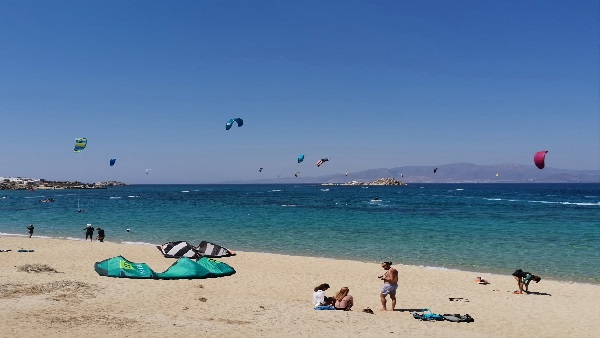
Photo: Kite Center Naxos by Thalasea Sports
From the end of May to mid-September the ‘’Meltemi’’ wind rocks the Cyclade islands and Naxos and becomes a must-visit for kitesurfers. The bay of Mikri Vigla is a great kite spot and is always packed with kitesurfers. If you find the beach too busy, the beach of Glyfada remains preserved with a long stretch of fine sand.
Limnos
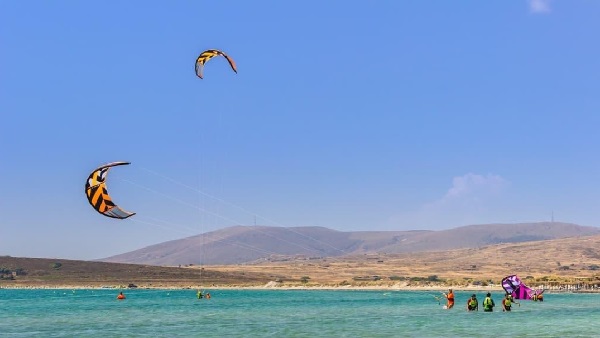
Photo: Surfclub Keros
Limnos is another beautiful island with green landscapes on a volcanic background; a preserved and peaceful island. It has a beautiful beach with flat and shallow water in the north, and if you feel like you desire waves, you will find them at the tip of the bay. The island is preserved from mass tourism, therefore, the spot is still not very crowded. The wind is constant and the setting is nothing but superb.
Kos
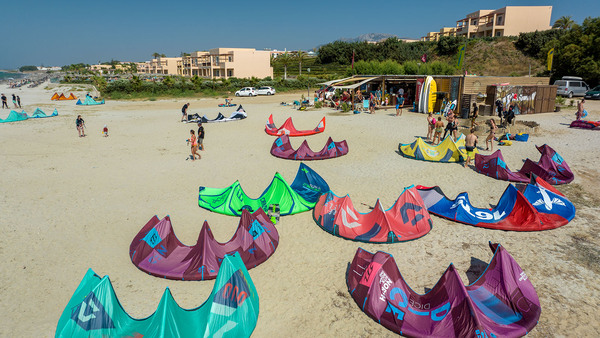
Photo: Horizon Surfing Center Kos
The island of Kos, located just off the coast of Turkey offers strong winds from the end of June to the end of August. In the northernmost part of the island, you have the spot of Marmari offering choppy water and some waves when the wind rises. In the northeast you have a spot of Psalidi which is one of the most loved and frequented spots. It has a well-developed infrastructure on the beach for kitesurfers. And then you have Kohilari spot, in the southwestern part of the island. The wind is generally a little less strong, however, the area is huge with choppy water which makes the kitesurfing pleasant.
Crete
What makes this island so fascinating is that each region is different, so everyone who comes here will find what they like best. The mountains, the beaches, the olives, the delicious octopus, and the hospitality of the locals will accompany you during your stay on the island. Also, Crete has all the conditions for kitesurfing. The wind-water sport is popular here from June to September. The best place to go in Crete is on the eastern edge of the island of Palaiokastro where the bay is ideal for beginners and professionals.
Rhodes
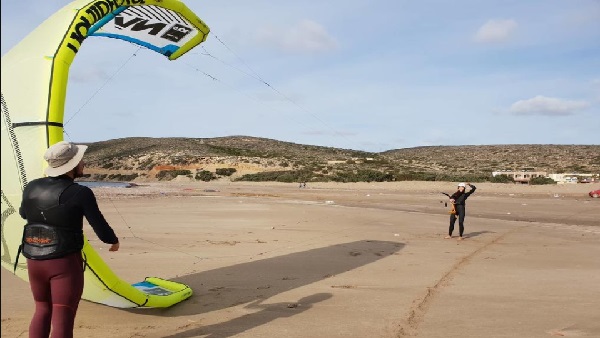
Photo: Wetskillz kitecenter
Rhodes is closer to Turkey than mainland Greece and is quite windy—a favorite among kitesurfers. The southern side of Rhodes is quieter, less populated, and a little less touristy. The autumn season is, therefore, the best season for anyone who wants to avoid the noisy crowds devoting their holidays to beating the waves. The most popular spot, Prasonisi, is the place that attracts the majority of kitesurfers. Experienced kiters prefer the second half of the day, which is when the wind is at its best, speeding up to 20 knots.
Paros
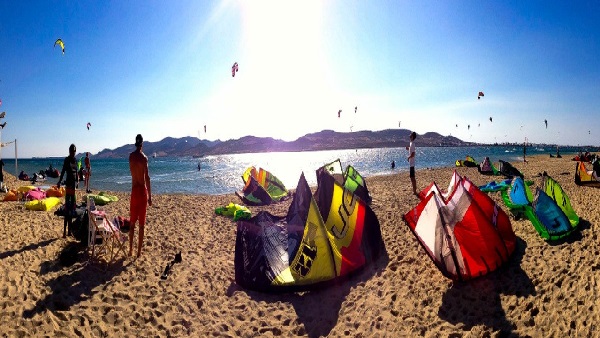
Photo: Paros Kite Pro Center
The kitesurfing season here runs from May to October. The beach in New Golden is a favorite destination for lovers of wind and water sports. For beginners who are just starting to master the basics of kitesurfing, Pounda Beach is the best place to go, as it is a small strait of 1.7 kilometers that separates the island of Antiparos from the coast. Here, a venturi effect is created and the ‘’Meltemi’’ blows between 12 and 25 knots.
Mykonos
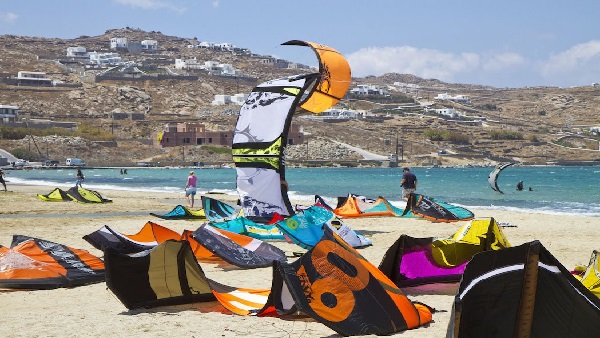
Photo: Kite Mykonos
The island of Mykonos is a natural paradise because of the number of beaches and night parties. It is also a windy island, especially in the northern part. Kalafatis beach is the ideal beach for the most sporty people. The beach is usually very exposed to the wind and allows kitesurfing on most days. In fact, on the same beach, you can rent all kinds of kitesurfing equipment. Other important beaches are Ftelia and Korfos Bay.
Nea Kios
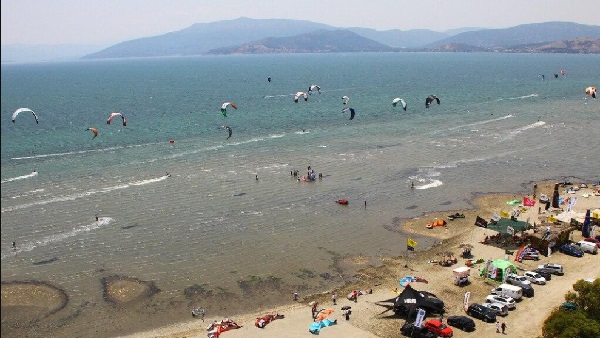
Photo: Radical Kite Center
The kitesurfing spot is well known for its proximity to the capital. It serves as a gateway from busy Athens to enjoy the sport. The conditions are great for beginners as the water is shallow, flat, and sometimes choppy. In addition, there is plenty of space on the beach to launch and land the kite. The best season is considered to be from April to September (with thermal winds in summer). Apart from kitesurfing, the neighboring town of Nafplio has great nightlife with a number of dance clubs.
Drepano
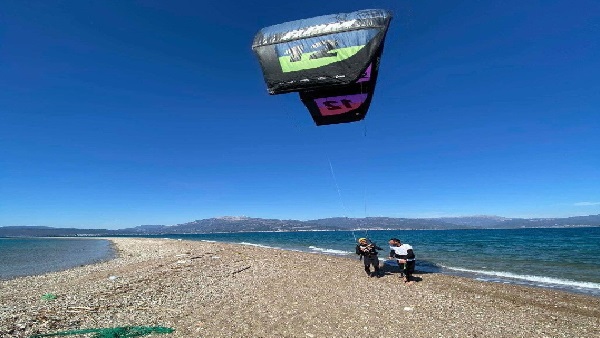
Photo: Cape Drepano Watersports
Cape Drepano is one of the few kite spots in Greece that is specially designated as a kite beach. Cape Drepano is a long, narrow headland that stretches into the Gulf of Corinth. The fairly wind-safe kite spot works in both westerly and easterly winds. The kite spot is not only popular with locals and tourists, but also well-known kitesurfing athletes.
Lesvos
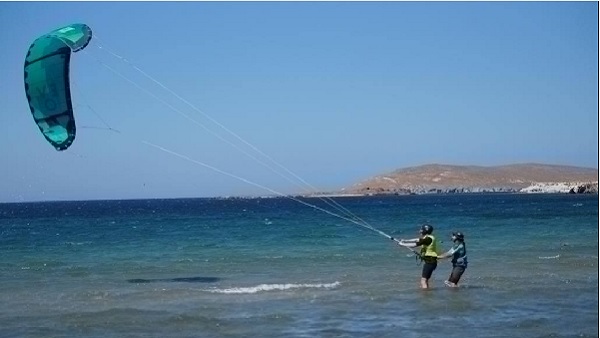
Photo: Extrados Kite Activity
The third largest Greek island, Lesvos, is just as windy as the other islands swept by the ‘’Meltemi’’, and yet more authentic and preserved from the crowd. The Sigri spot offers excellent conditions with a wind that increases from morning to afternoon: getting up to 25 knots at midday. You can kite there safely from beginner level to the free-rider, the freestylist or the foilist.
ABOUT THE COUNTRY
A Brief History of Greece
Stone Age farmers lived in Greece as early as 7,000 BCE.
But later, the most important civilization of ancient Greece was the Minoan. Around 2,500 BCE this sophisticated society grew up on the island of Crete.
However, it was during the Archaic period (VIII B.C.E.-VI B.C.E.) when the Greek cities (polis) and the most characteristic features of their identity developed. The period of maximum political, economic, and cultural splendor was reached during the Classical Period. During this period, the Century of Pericles (V B.C.E.) took place when the Parthenon and other symbols of Athens were built.Also in this stage, the theater reached its greatest apogee. In the 5th and 4th centuries BCE Greece excelled in architecture, sculpture, and literature. They also produced some of the world's greatest philosophers and mathematicians—and also gave us the Olympic Games.
Alexander the Great was the figure who consolidated the Greek territories. He led an army into what is now Turkey in 334 BCE. He crushed the Persians at the Battle of Issus in 333 BCE and conquered a vast empire stretching from Egypt to India. However, Alexander died in 323 BCE and his empire was broken. Nevertheless, Greek culture spread throughout the Middle East.
From the 15th to the early 19th century, Greece was ruled by the Ottoman Turks. The Ottoman Empire was at its peak in the 16th century. However, from the end of the 17th century, it slowly declined and, by the end of the 18th century, nationalism grew in Greece.
Eventually, the European powers intervened and a French, British, and Russian fleet destroyed the Turkish fleet at the Battle of Navarino in 1827. Greece finally became independent in 1829.
In 1896 the Olympic Games were revived.
When World War I began in 1914, Greece remained neutral at first, but in 1917 joined the Allies.
The Germans invaded Greece on April 6, 1941. They captured Athens on April 23. Greece was then occupied by Germans and Italians. The Greeks suffered terribly during World War II and many starved to death.
In 1981 Greece joined the EU. In 2001, Greece joined the euro.
Other Attractions in Greece
Greece has a wide range of attractions. There is just too much to do, visit, and see.The Meteora Monasteries are a must to see and will take your breath away—it’s a religious site with a mystical landscape where the patterns of sandstone cliffs and the tranquillity of 300 meters of altitude converge. It is one of the most photogenic places in Greece.
Also, Mount Olympus is the seat of the gods of Greek mythology. It is the highest mountain in all of Greece and one of the highest in Europe. The Mount Olympus mountain range is not only remarkable for its size, but also for its amazing fauna and endemic species.
The Valley of the Butterflies is a real natural highlight of Rhodes for romantics. Don't miss the chance to walk through the multicolored butterfly-covered vegetation with the roaring waterfalls in the background.
Finally, Navagio Beach is the calling card of Zakynthos, a paradise on earth. Apart from the bright white sand and the turquoise Ionian Sea framed by steep cliffs, a sunken smuggler's ship can be found washed up on the beach.
Getting to Greece
Greece has numerous airports. The Athens International Airport is the largest airport in the country. Other international airports with major traffic are Heraklion, Thessaloniki, Rhodes, or Corfu. Athens and Thessaloniki handle the majority of international scheduled flights. And yet, during the tourist season, many low-cost carriers also have domestic flights to the Greek islands and smaller airports.
In regards to international rail service, Thessaloniki is Greece's hub. Trains connect Thessaloniki to Sofia, Bucharest, Budapest, Istanbul, and other international cities. In summer there are direct services to Prague, Bratislava and Moscow. There are special fares for train travel in Europe.
You can also reach Greece by car via neighboring countries. From Italy, ferries transport cars to Greece. From Europe, the most popular route is through Eastern European countries.
Going by bus is also an option as there are some, although limited international buses from neighboring Albania, Bulgaria, and Turkey, as well as from Georgia.
Arriving in Greece by boat is the best option if you wish to take a Mediterranean cruise or a transfer from Italy, Cyprus, Turkey, or Croatia, which is recommended especially during the summer and spring. The maritime network in Greece is particularly extensive and guarantees transport to all the islands of the Greek territory. Its internal maritime transport, high-speed ferries, make numerous trips. Most of the trips have occur daily throughout the year.
USEFUL RESOURCES
SIMILAR KITESURFING DESTINATIONS
- Italy
SPOT
WORLD > EUROPE > GREECE > NAXOS
NAXOS
Naxos is a spot very well known amongst kitesurfers for its great conditions. The choppy water is ideal for freeride and also for good bump and jump sessions in the open sea where the swell is very present. It is on the west coast of Naxos that you will have the most wind—the thermal wind from the North blows all day long with an average strength of 20 knots.
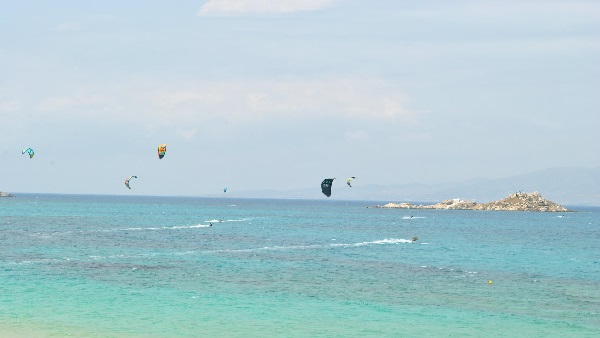
Photo: Flisvos Kitecenter Naxos
HIGHLIGHTS
REMOTE BEACHES
One of the best partss of the island is its beaches. The island of Naxos has more than 100 kilometers of large sandy beaches. Remote places with few tourists and turquoise waters that you will not want to leave are what await you on the coastline. Some of the most beautiful ones are Hawaii Beach, Agios Prokopios, or Apollonas.
CYCLADIC ARCHITECTURE
Chora is the capital of Naxos and everything you want to know about Cycladic architecture you will find there. Whitewashed white houses with blue-painted doors and windows, small chapels, stone-paved roads, arches, and endless cobblestone alleys make this labyrinth so charming.
ICONIC SUNSETS
For sunset fans who always try to find the best spots, the most famous in Naxos is the one from the Temple of Apollo. The gate is the only remaining part of the temple, however, it is one of the most photogenic places on the island.
Another unforgettable sunset spot is from Hawaii beach, where you can witness how the colors of the rocks are changing as the sun goes down.
CULTURAL FESTIVALS
In Naxos, you may enjoy many traditional festivals that attract internationally renowned musicians, dancers, and actors. For this reason, Naxos has become a favorite summer destination for lovers of the arts. From classical, modern, and jazz music, to painting and sculpture exhibitions, lectures, and seminars, you can find it all here. These events create a very interesting cultural mosaic which impresses not only the locals but also foreign visitors.
KITESURFING IN NAXOS
Naxos, as the largest island of the Cyclades, forms the center of the archipelago and is also a hub for kitesurfers. It is separated only by a narrow strait from the neighboring island of Paros through which the ‘’Meltemi’ (Greek trade wind)’ accelerates considerably. In Naxos, the more you go south, the more the beaches follow one another, the more you feel the peace and quiet. The colors gain in contrast, the mountains rise, and the ’Meltemi’ strengthens.
The spot at Agios Georgios is one of the few good wave spots for kitesurfing in the Aegean Sea. The ‘Meltemi’ pushes the swell through the strait between Naxos and Paros and so you have an onshore wind and up to 2 meters of clean waves (which invites you to have some jumps). What makes the spot especially attractive is that right next door and behind a reef a huge lagoon with shallow water begins, which also offers the best conditions for freeriders and beginners.
Further south, in Mikri Vigla there are great conditions for kitesurfing. At the local kitesurfing schools, you can easily rent equipment and book kitesurfing classes with a certified instructor. The fine sandy beach is wide and offers plenty of space, which makes this spot the number 1 kiting area on Naxos. The further out you kitesurf, the higher the waves become, whereas, at the entrance, there is almost flat water.
Wind, weather and water
The ’Meltemi’ blows from May to October with particular intensity between June, July, and early September. ’Meltemi’ winds are strong, dry, seasonal winds that occur throughout the Aegean. Depending on where you are in Greece, they can come from the north, northeast, or northwest. The ’Meltemi’ helps lower the scorching summer temperatures and clears the atmosphere, providing great visibility. If it weren't for the ’Meltemi’, temperatures in the Aegean would be much higher. The channeling of the wind between the islands causes its speed to increase.
Mikri Vigla, located on the southwestern part of the island, benefits fully from the venturi effect generated between the islands of Paros and Naxos. This spot, with a main wind direction side onshore, is rocked by a light wind in the morning that strengthens at the end of the morning to reach its full force in the afternoon.
Greece enjoys a temperate Mediterranean climate. In the summer the days are long and the temperatures are high. Often, at the end of the day, there can be a cooling breeze—especially in the coastal areas and in the north of the country. On summer days it gets quite hot on the mainland, with temperatures oscillating between 25 and 30 degrees. Athens can reach up to 42ºC. However, on the islands, it is less hot. The rainy season lasts from November to March.
The water temperature is average, so a short sleeve wetsuit can provide more comfort and sun protection if you intend to surf for a long time. Some areas have flat, choppy water, while others will have waves up to 2-3 meters in height.
WHAT ARE THE BEST BEACHES FOR KITESURFING IN NAXOS?
Mikri Vigla Beach
Over the years, kitesurfing has established itself on the spot of Mikri Vigla to finally become the main spot on the island of Naxos. Being 18 kilometers from the capital, the area of Mikri Vigla has remained authentic. The natural beauty of the landscapes is very appreciated by the kitesurfers who come to recharge their batteries. It is a nice spot that consists of a wide beach of golden-white sand, perfect in terms of safety, as it is enclosed in a bay. More so, you can make long rides between the beach of Mikri and the small rocky island of Parthena.
In summer, the wind is strong, matching the effects of the ’Meltemi’. This wind during the summer starts in the early morning and stops at sunset. The beginning of July or the end of August offers easier conditions for beginners, therefore, you will not be alone on the water.
Wind direction: N-NE, constant, on average 20 knots and more.
Water conditions: chop, small waves, crystal clear water, water temperature between 19 and 25 degrees.
Discipline(s): freestyle, big air, freeride.
Skill level: all levels
Watch out for: (hazards) rocks near the island
Getting there: about 20 minutes south of Naxos town by car, but there is also a direct bus departing from Naxos and arriving at Mikri Vigla. Buses depart four times a day and operate daily with a journey time of approximately 17 minutes.
Tip: the wind is often very strong in high season, plan on small kite sizes.
TRAVELING TO NAXOS AS A KITER
Getting There
Naxos has a small domestic airport with direct domestic flights to Athens airport. Therefore, you can fly to Athens and from there travel by plane or ferry to Naxos. This option is not always the most convenient. Planes departing from Athens to Naxos are small with a maximum of 50 passengers.
Also, Naxos is very close to Mykonos and Santorini, both islands with international airports and ferries arriving at Naxos. So the best option to get to Naxos from Europe is to take a direct flight to Mykonos or Santorini and from there travel by ferry. Mykonos is the closest location to Naxos and therefore takes less time by ferry, whereas from Santorini the ferry takes from 1.5 to 2.5 hours depending on the boat and the route.
Accommodation
Naxos is an island that offers many apartments and family-run accommodation. There are also few large resorts or big hotels for maximum comfort. The best place to sleep in Naxos is Chora. In the capital of the island, you will have access to more amenities and several beaches nearby. Chora is also great if you want to go out for drinks or have fun at night.
Agios Georgios, located just steps from Chora, is another good place to stay and enjoy the beach all day then walk into the town of Chora for a sunset drink or dinner.
Another area to overnight is Agia Anna, thanks to its beautiful beaches protected from the wind with turquoise waters, golden sand, and a variety of restaurants and fun beach clubs.
The best places to live like a local are the mountain villages, especially Chalki, Moni, Sangri, and Filoti, which offer modern comforts and excellent locally sourced food in a picturesque setting.
Other small villages worth mentioning are Moutsouna, Kalandos, and Apollonas—all far from Chora, yet quiet and with few tourists.
Getting Around
Naxos is an island with many beaches and places worth visiting, so if you want to travel around the island and reach all the remote spots, the best is to rent a car or a scooter and explore the region on your own. This is the most expensive option, but also the most comfortable, since you do not have to depend on bus schedules so you can go anywhere at your own pace.For short distances you can take a taxi or a local bus. However, the fact that Naxos isn’t that touristy also has its disadvantages, as the public transport is not so good.
Food and Drink
Naxian food is famous all over Greece. Naxos is particularly known for its potatoes, citrus fruits, kitron (a citrus-based liqueur), cheeses, lamb and goat, wine grapes, honey, and fresh fish. Chora town has the most restaurants and almost all the bars in Naxos. Most of the restaurants in Chora are located along the harbor or inside the old labyrinthine village. The restaurants along the harbor have incredible sunset views, but the food is usually better inside the town. Traditional dishes to try are Paidaki—goat or mutton ribs with lemon, oregano, salt and pepper; Sfakiano—lamb stewed in wine with spices; and psaria plaki—fried fish with vegetables and tomato, fennel, olive oil sauce.
The country has been producing wine for thousands of years and offers some truly amazing varieties, especially white wines. The main wine regions of Greece are, in fact, the Cyclades (the group of islands including Naxos). Types to try include Assyrtiko and Moschofilero (both whites), Agiorgitiko (rosé and red), Xinomavro (red), and Vinsanto (white dessert wine).
Don’t forget the delicious puff pastry—baklava.
No Wind?
The island is too beautiful and singular not to go and discover it. The distances are very reasonable, and the roads very pleasant. The landscapes pass by and do not resemble each other. Everything is a pretext for a stop: a small mountain chapel, a traditional village, a sunset with a little height.
The most beautiful beaches of the island are considered to be in the southwestern part, including the bay of Mikri Vigla, and the beaches of Kastraki and Glyfada.
Also, do not miss the Portara, built from the ruins of an ancient temple.
Discover Agia Anna, a small family resort during the day with its restaurants and cafes on the waterfront, which becomes a lively place in the evening.
There are more than 500 churches and chapels on the island as well as many medieval castles to visit.
Like all the best historic centers, the old town of Naxos is a place where you can wander idly for hours and has irregular marble cobblestones and beautiful white Cycladic houses. Kastro is a confusing little world of alleys, stairways and passages which is worth your attention too. Many of these have doors, railings and window frames painted deep or pale blue.
The geography and mythology make Naxos one of the best places in the Cyclades for hiking. Go to meet Naxos secret coves. There are two reasons to hike Mount Zas: to stand on the highest point of the Cyclades and to reach the top of the mountain where Zeus was born and raised. Hidden in the slopes of the mountain is a small cave where Zeus was born. You can visit this cave while walking to the top.
Finally, enjoy Greek cuisine on a mountain path or in the evening facing the sunset on the roof terraces of the restaurants of the city.
USEFUL RESOURCES
France is one of the most romantic countries with its roots in gothic art, medieval harbor towns, peaceful villages, majestic mountains, and fabulous beaches. The cities are filled with elegance and beauty, and the refined taste of the French is reflected not only in their fashion but also in their fabulous cuisine. Resorts on the French Riviera and in the Provence region guarantee great beach holidays with plenty of activities.
HIGHLIGHTS OF FRANCE
FASHION
Fashion is a matter of national identity.. Today, the most prestigious firms and famous designers have France and its capital, Paris, as the major stage to present their collections and announce new trends. Throughout the year you will find numerous glamorous fashion shows and events hosted in the country.
LAVENDER FIELDS
French smedia is booming with a great deal of photos of lavender fields.
France is just that place where you can find yourself in the heart of the colorful lilac shades. The region of Provence, in southeastern France on the Mediterranean Sea, is covered by lavender fields that take over the valleys. The flowering season runs from June/July until September.
FESTIVALS
You'll be amazed at the number of French festivals the country hosts yearly. From art and music festivals to chocolate and wine festivals and fiestas Nice's Carnival is one of the largest in the world. It takes place in February and dazzles with colorful parades of flowers, dancers, and lights. Another destival is the Cannes Film Festival in May. In December, the spectacular Fête des Lumières in Lyon attracts huge crowds of tourists as well. The list goes on.
MICHELIN-STARRED RESTAURANTS
It is well known that the French are masters of high-end cuisine in terms of taste, decoration, and variety. Therefore, it is not surprising that France has a large number (more than 600) of Michelin-starred restaurants spread throughout its territory, with the majority being located in the capital. This makes France a gastronomic paradise for food lovers.
KITESURFING IN FRANCE
The sport of kitesurfing originated in the northwestern region of France, where in the ’80s the brothers Bruno and Dominique Legaignoux were testing boards, skis, and different types of sails and kites without even suspecting that years later they would become the pioneers of the discipline.
Today, France, benefiting from the Atlantic and the Mediterranean coast, is one of the best spots in Europe for kitesurfing. Whether it’s on the French Riviera, the French Brittany, the Atlantic or the southwest area—you will find ideal long sandy beaches and favorable wind conditions to kitesurf everywhere. No matter whether you are a beginner or an expert, the spots will allow you to enjoy the sport. Some spots have flat, smooth-water surface, while others will allow you to have fun in the waves. If you prefer kitesurfing in shallow lagoons, you will find them in France, too. The majority of the spots are equipped with an abundance of kitesurfing schools, in case you need some lessons, tips, equipment or companionship. Some of the spots became prestigious due to world-class international kitesurfing competitions being held annually, gathering the best of the sport to showcase their skills.
WHEN IS THE BEST TIME TO KITESURF IN FRANCE?
The months of March to September are excellent for kitesurfing due to ‘’Le Ponant,’’ the southern thermal wind, which blows constantly and lightly.
This wind can be found throughout the year but usually reaches its peak in spring and autumn.
In the summer, it can be similar to the thermal breeze which emerges at the end of the day. However, many beaches prohibit kitesurfing during July and August due to the crowded beaches. As a result, it is recommended to aim fortravel in April/May or September/October.
In the winter months, big storms make the Mediterranean a place with a good amount of waves, although the weather might be chilly.
WHAT ARE THE BEST KITESURF SPOTS IN FRANCE?
St. Pierre la Mer
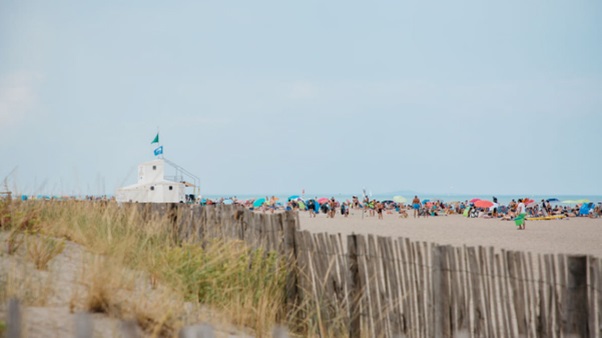
Located on the Mediterranean coast, Saint Pierre La Mer allows you to kitesurf along a huge, wild beach. A part of it is dedicated exclusively to water activities. This is great for beginners, as they can learn how to handle kites safely on the shore. For professionals, the beach offers waves when the wind is from the South. Besides, the spot hosts numerous kitesurfing competitions throughout the year, such as the Junior Kiteboarding Freestyle World Cup and the French Kite Boarder Cross Cup.
La Palmyre

The Charente coastline is full of great spots to practice kitesurfing. One of them is the cove of La Palmyre located nearby the city of Bordeaux.La Palmyre forms an enormous cove in which the sea rushes in at high tide, and when the tide is at its highest, you can kitesurf on a perfectly flat area of water sheltered from the waves by a long strip of sand.
Brest
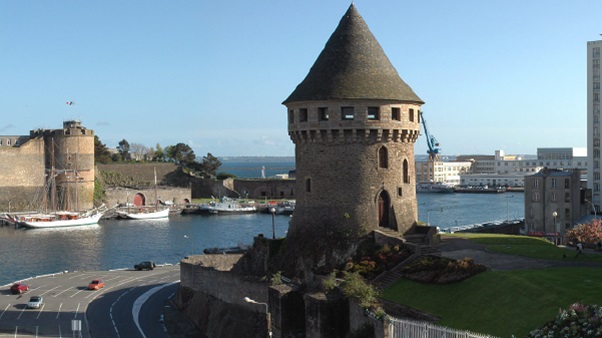
Brest coast (in the North of Finistere) offers a multitude of beaches ideal for kitesurfing, and as it benefits from the influence of ocean currents coming from the Atlantic and the English Channel, everyone can find their own playground. Depending on the direction of the wind and tides, you can choose to kitesurf in various spots: Rade de Brest, Keremma, Goulven Bay, Dossen, Kernic Bay, and the Dunes of Sainte Marguerite. Most are freeride spots, which can turn into wave spots.
Gruissan
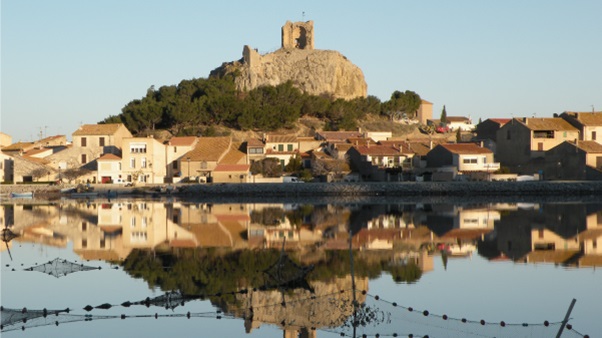
In Gruisann you will find the weather conditions are ideal, the temperature mild, and the landscapes spectacular. Kitesurfers here will enjoy a 5 kilometer-long beach and strong tramontana winds. A good spot to fall back on when the tramontana blows a little too hard is Grazel. Sheltered by the massif of Clape and the island of Saint Martin, the airflow is less powerful than on the rest of the beach making the water shallow and flat, which is just perfect for beginners.
Almanarre
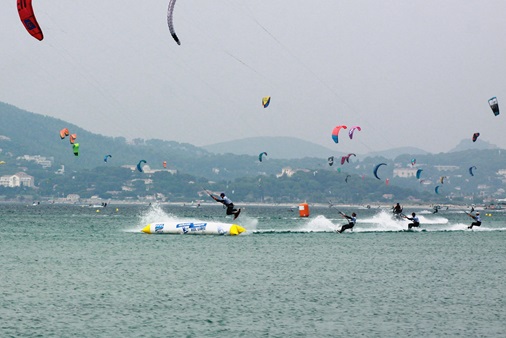
Located just at the outskirts on Toulon,Almanarre is one of the most acclaimed locations in the south of France.The beach itself is 4 kilometers long and stretches west. The second official kite zone ("Mérou") is available in the Northeast of the peninsula. It is a perfect flat water spot for beginners if the conditions become too rough at Almanarre.
ABOUT THE COUNTRY
A Brief History of France
France has a long and eventful history full of major conflicts. It is important to distinguish between the late 18th and early 19th centuries and highlightNapoleon Bonaparte. He crowned himself as an Emperor of France in 1804 and built a vast Empire that led the continent. During the Empire of Napoleon I, the territories of France extended to the Russian border. Napolean dissolved the Holy Roman Empire to spread revolutionary ideals throughout Europe, and consequently, the world.
Later, World War I will be summarized as a war between France and its allies against Germany and its allies, which lasted from 1914 to 1918.
During World War II, France and the United Kingdom declared war on Nazi Germany on September 3, 1939, under a treaty with Poland. France was defeated during the first part of the war which led to the northern half of the country being occupied by the Germans until close to the end of the war (1945) when the Allies recovered northern France. Today, France, being a semi-presidential republic in Western Europe with a number of overseas regions and territories, rises as one of the world's major powers with a strong cultural, economic, military and political influence in Europe and around the world.
Other Attractions in France
It’s impossible to talk about France without mentioning the capital of light, romance, and elegance—Paris. The variety of museums, palaces, famous landmarks, and lesser-known but still noteworthy places, restaurants, idyllic cafes, and bars hosting staggering live cabaret shows will leave any avid traveler speechless. Beyond Paris, Marseille is a charming city, partly because of its labyrinthine streets and street art. The Panier district is the most picturesque in the city. A large number of small craft stores and bars and restaurants also contribute to the charm of this area. Nice, located on the shores of the Mediterranean Sea and surrounded by several hills,is the capital of the French Riviera. If you want to be active, you can hike along the cliffs while absorbing the magnificent views. A little further out of Nice, there are trails of different lengths. Some can take 3 hours while others take 5 hours. France is also home to some great surfing beaches. Especially in Biarritz, you can find waves for all levels and styles. The city’s beach waters are frequented each summer by international surfers of various disciplines. Throughout the year, the city hosts various surfing competitions and sporting events, including the oldest in Europe—the Maider Arosteguy surfing competition.
Getting to France
France has one of the best infrastructures in the world. Its international airports are well distributed throughout the country and provide direct access to many French regions and cities. France has many regional airports and a very extensive road and rail network if you wish to continue your trip and move around. There are many airports in France, however, the 3 most frequented are Paris-Orly, Paris-Charles de Gaulle, and Nice Côte d'Azur. Flights to France are cheaper during off-peak periods: spring and autumn.
International trains depart from the Channel ports and Paris to destinations throughout Europe. Eurostar operates direct high-speed trains from London to Paris and Brussels. It also offers direct service from London to Lyon, Avignon, and Marseille. InterRail offers unlimited first or second-class travel in up to 31 European countries. Travelers from the continent (Europe) can drive to France on major roads in almost any direction they wish.
Finally, France can be easily reached from the Atlantic Ocean, the English Channel, and the Mediterranean, which means it has many seaports. Cruise ships make regular stops along the French coast with the Mediterranean coast being especially popular on the French Riviera. Brittany Ferries operates ferries from the South of England to the North of France, while In the Mediterranean, Corsica Ferries and Sardinia Ferries connect Sardinia and Corsica with Nice and Toulon.
USEFUL RESOURCES
Belgium has been developing more and more each year as the kitesurfing scene grows. New spots and schools are emerging as the locals and visitors begin coming to kite. and more schools emerge.
Belgium is an easy country to access due to its affordable international airport in Brussels. Once you are in Belgium you can visit the different cities, explore its rich culture, learn about its medieval history and taste their foods. If you want a mix of kitesurfing and city exploration - Belgium is a great location.
Capital: Brussels
Currency: Euro
Level: Beginner to Professional
Winds: 8-23 knots
Kites Needed: Small 9m-11m / Big 12m-17m
Waves: 0-1.5m
Flat Water Spots: Yes
Beach Break Spots: Yes
Wetsuit Needed?: Yes
Water Temperatures: 14-20 °C
Uncrowded Waters: Yes
Kiteboarding Lessons Average: 75-95 +/- Euros Per Hour
Average Good Meal + Drink Price: 15-22 +/- Euros
Nightlife: Yes
Amazing Downwinders: No
By coming to Poland you will experience great hospitality, openness, and some of the most beautiful beaches in the world. It’s surprising, but it’s true! Once you take in everything the country has to offer, you’ll find yourself planning your return at every opportunity.
HIGHLIGHTS OF POLAND
A VARIETY OF KITESURFING CONDITIONS
Poland has a spot for every level of kiter and every discipline. You can ride in the shallow waters of the Bay of Puck or enjoy great spots by the sea in beautiful locations like Kuźnica or Jastarnia.
A NATURE LOVER’S PARADISE
The Polish Coastal Landscape Park is a protected area in northern Poland covering an area of 188 square kilometres (73 square miles). More than half of the park is covered by the waters of Puck Bay. There’s a variety of seashores in the park (cliff shores, dune shores, and low floodplain shores). Diverse topography and the associated habitats make the flora of the park very rich and varied.
BEAUTIFUL AND WIDE BEACHES
There are many breathtaking beaches throughout the country, so if you find yourself desiring a quick break from kitesurfing, you can enjoy sunbathing, yoga, or jogging by the seaside.
LOTS OF INTERESTING ATTRACTIONS
Besides kitesurfing, you can experience beautiful sunsets at the beach, go for a bike ride, and visit military museums or the seal sanctuary in Hel. At night, there are plenty of parties you can attend with other kitesurfers. There’s no way you’ll be bored!
KITESURFING IN POLAND
Kitesurfing in Poland is an extraordinary experience that you will never forget. You can enjoy beautiful landscapes while kitesurfing in perfect conditions for both beginners and advanced learners. Due to the ample shallow water spots in Poland that make the sport even safer for everyone, there are barely any accidents.
WHEN IS THE BEST TIME TO KITESURF IN POLAND?
The very best time to visit Poland for kitesurfing is between April and September. High season is in July and August during Poland’s summer holidays.
WHAT ARE THE BEST KITESURF SPOTS IN POLAND?
Chałupy

Photo: Paweł Kocięcki, IKO Examiner and Owner of IKO Center Kitescontrol in Chałupy
Here you can find plenty of kiteboarding schools that are affiliated with IKO, offering reasonable prices and qualified instructors. There are two spots where you can take lessons—by the seaside or on the bay. The wind direction determines where the training will take place.
Jastarnia
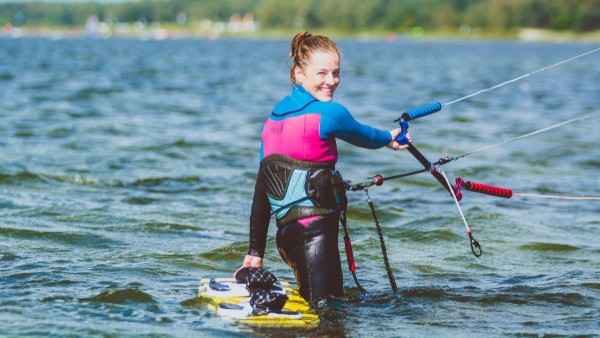
Photo: IKO Center KiteStyle in Jastarnia
Jastarnia is a resort town located on the Hel Peninsula and is home to several IKO Centers. You’ll find flat, shallow water at this spot and consistent winds from May to September.
Mewia Rewa
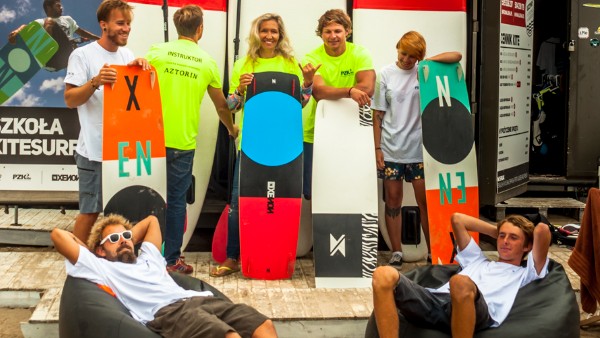
Photo: IKO Center Aloha Kiteboarding in Rewa
Rewa is best known for the Rewski promontory, a stunning location and one of the most popular places for people to start their kitesurfing journey. This beach is just as breathtaking in person as it is in photos.
Kuźnica
Kuźnica is an extremely picturesque place with great conditions for kitesurfing. The 60 meter wide and 1 kilometer long sandy beach makes Kuźnica the best place on the Hel peninsula for aquatic recreational activities and offers unforgettable experiences for kitesurfers.
Łeba
Łeba is a perfect place for practicing water sports.The wide and sandy beaches provide great conditions for kitesurfers, with the best conditions being found from the western side of the estuary of the settlement to the Baltic Sea.
ABOUT THE COUNTRY
Brief History of Poland
Poland has a long and rich history dating back to prehistoric times when Slavic tribes arrived on this territory and settled it. In 966, Duke Mieszko I converted to Christianity and, by baptism, brought Poland to the community of Western nations. The 16th century was Poland’s “Golden Age.” During the Renaissance, Poland advanced culturally, making significant strides in the arts and sciences. There was a time when Poland was the largest country in Europe, but it was erased from the world map for 123 years. It was only in 1918, after World War I, that Poland reappeared on the map of Europe. Shortly thereafter, on September 1st, 1939, Poland was invaded by Nazi Germany and World War II began. Shortly thereafter, Poland fell under Soviet control. A modern Polish state arose after the first elections of the Third Polish Republic, and Poland now has a new constitution which was signed in 1997. The country has been a member of NATO since 1999 and joined the European Union in 2004. After years of turbulent history, Poland has finally found some stability and a chance for growth and peace.
Things to Do When There’s No Wind
There are plenty of things to do when there is no wind. You can relax on beautiful beaches or try other sports like paddle boarding and cycling. You can visit local forests and try local food—fresh fish and common Polish dishes like Pierogi and Gołąbki can’t be beat. When the sun sets, you’ll find that night clubs are not only open during the holiday season, but they’re a great opportunity to take a quick break from sport and enjoy free time with friends.
Getting to Poland
Getting to Poland is very easy. You can get to Poland by airplane and, when you arrive, rent a car to explore the country. Renting a car is quick and easy, as there are multiple car rental companies near the airports and the prices are very reasonable.The closest airport to Hel peninsula is located in Gdańsk, which is approximately two hours away from Hel (if you don’t have a car, you can also get there by bus or train).
USEFUL RESOURCES
SIMILAR KITESURFING DESTINATIONS
If you think of a European destination where “beer,” “bratwurst,” and “vast highways” are keywords, then Germany comes to mind. But Germany is much more: how about the beautiful cities, great nightlife, and unpopulated islands with beautiful nature? Or how about surfing on a river in the middle of a city and, of course, the beautiful kitesurf spots perfect for the Freeride and Freestyle kitesurfers!
HIGHLIGHTS OF GERMANY
THE CITIES
Great cities such as Hamburg, Berlin, and Munich have it all: from art museums and classic opera to underground clubs. You'll find yourself wandering through the streets full of architectural creations from the Romanesque, Gothic, and Baroque times. In Berlin you mustn't skip Club Sage and make sure to grab a bite at Tiki Heart Cafe + Shop or head to Taquería Ta’Cabrón for the best tacos in town.
KITESURF EVENTS
Germany might not be considered the windiest place in Europe, but still, the country hosted dozens of kitesurf events and competitions, including one of the stops on the freestyle kiteboarding world tour. Germany holds a variety of kitesurf spots: from deserted and super flat with sheep on the grassy area where you launch your kite, to spots with waves, chop, and wide sandy beaches as far as you can see.
ECO-FRIENDLY STORES
It's great to contribute to the environment by stopping buying new, unsustainably-produced (and disposable) stuff and instead buying eco-friendly & second-hand. In Germany, you've come to the right place for this. There are plenty of small boutiques and eco-friendly stores run by freelance designers, for example. You can find them in the St. Pauli district in Hamburg. Rather buy second-hand? In the cities you will find many flea markets. In Berlin, visit the Sunday flea markets at Mauerpark, Arkonaplatz, and Boxhagener Platz.
THE BLACK FOREST
Take a hike on one of the many forest trails the Black Forest holds. This forest gets its name from its canopy of evergreens. You'll find valleys, luscious meadows, and fairytale-like farmhouses. During winter you'll come across some snowy slopes here too, which makes the area very popular for a weekend of snowboard/ski-action for the locals (snowkiting is done here, too).
PALACES OF POTSDAM
Visit the palaces of Potsdam. This place is located on a river about 20 kilometers from Berlin. You can get here by public transportation. We advise you to visit the Prussian Royal Seat. This is where you can see amazing gardens and palaces that have been under Unesco World Heritage since 1990. The old market and the New Palace are worth visiting too.
KITESURFING IN GERMANY
There are many beautiful kitesurf spots, perfect for the freeride kitesurfer. Most of them you’ll find in the North of Germany along the coastline. Both the North and the Baltic Sea have their fair share of must-visit European kitesurf spots. Therefore, you don't have to look far to find a spot that suits your needs. A large shallow area where you can stand and flatwater ride? The not without reason well known Loissin or the lesser known but not less beautiful peninsula Rügen are places where you can have a lot of fun. Do you want vast sandy beaches, lots of space, and a bit of a challenge? Sylt will satisfy your hunger for these conditions.
Don't forget to pack a (somewhat thicker) wetsuit, because both water and air temperatures never really rise up to a point that it gets really warm in Germany. Nevertheless, kitesurfing on these open waters, with steady winds and no obstacles or hazards below the surface, really is worthwhile.
WHEN IS THE BEST TIME TO KITESURF IN GERMANY?
Due to stormy weather in the fall and winter, Northern Europe's Germany is popular for storm-chasers. Unfortunately, that period usually also brings a lot of rain and cold air, which makes this time of the year not ideal for kitesurfing. But spring and summer also bring more than enough wind days in Germany. Temperatures are pleasant then as well, and some spots even have thermals, making it definitely not a wind-uncertain destination.
WHAT ARE THE BEST KITESURF SPOTS IN GERMANY?
Loissin

A spot that satisfies the needs of many: flat to choppy waters, a lot of space on the water, and a large standing-deep area make Loissin a top priority to go and ride for kitesurfers visiting Germany.
Sylt
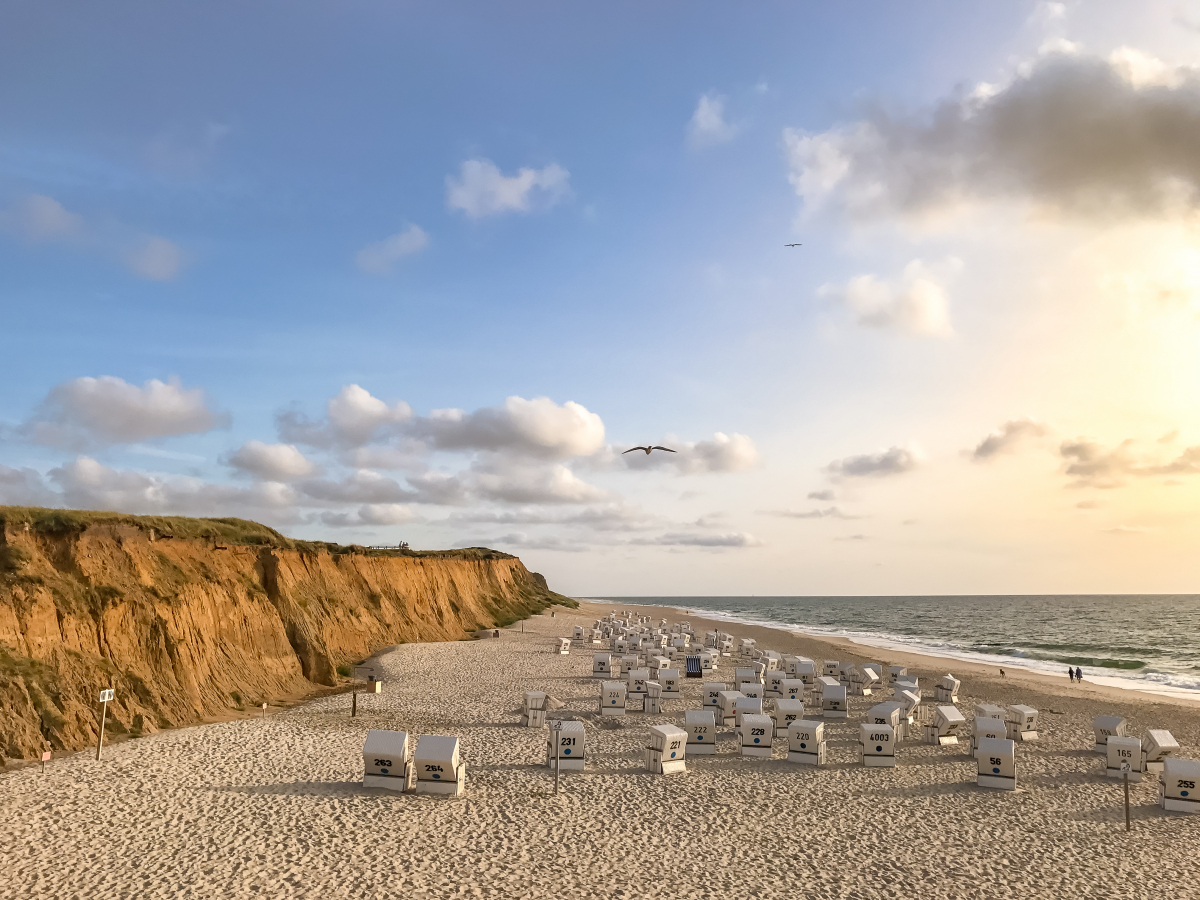
Close to the Danish border lies Germany's most famous Wadden Island: Sylt. This island is not even 100 square kilometers and due to erosion the island is still shrinking bit by bit. The water conditions can be turbulent at this spot where you often find waves. A beautiful spot with a wide sandy beach. The pretty dunes with beach grass complete the picture.
Gelting
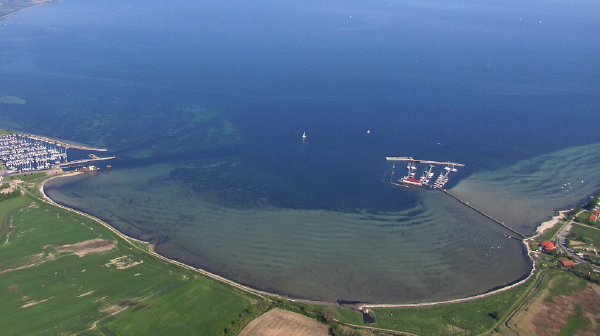
This spot on the Baltic sea is where you want to kitesurf. Especially if you're looking for an accessible spot that always works and which is unquestionably suitable for beginners. This area has some great benefits: it has a very large standing area and the variety of spots (3) that make kitesurfing possible in any wind direction. The bays border a narrow shell/sand strip and grassland where you can rig, start, and land.
Butjadingen

Butjadingen is a piece of Germany that juts up into the North Sea. Kiteboarding is possible on both sides. At Burhave and Tossens. Ebb and flow are making the spot look different as night and day. Yet the shallow and mostly flatwater remains, making Butjadingen a popular kitesurf spot just a few hours drive from Hamburg.
Bremerhaven
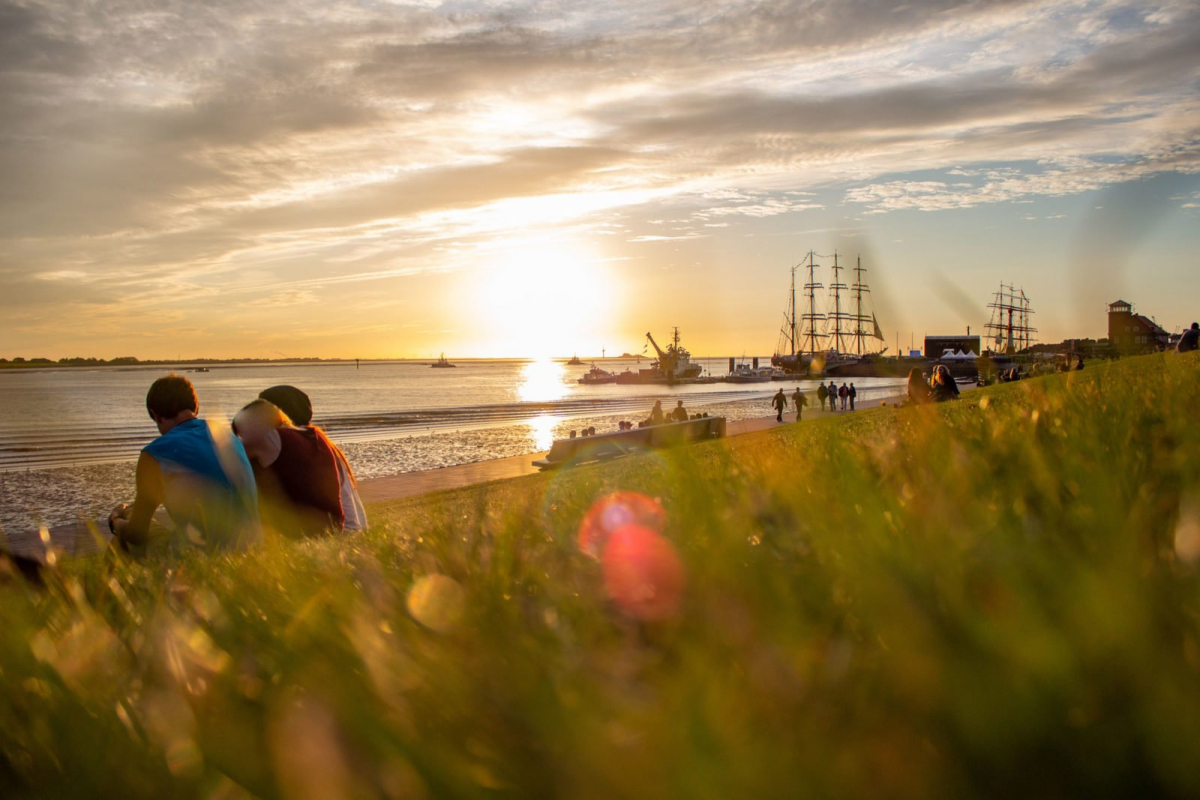
Bremerhaven is to the right of Butjadingen on the map. You will find similar conditions to the last mentioned. Wremen and Dorum are two great spots north of Bremerhaven: Shallow, flat, chop, and small waves are keywords for the spots in this area.
Barlt
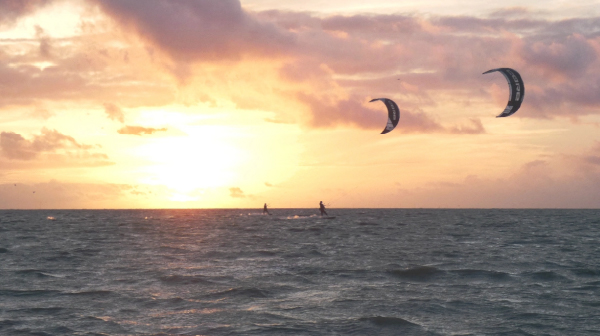
To the northeast of Hamburg lies Barlt. The place is ideal for beginners in kitesurfing due to its huge pitch and plenty of space. Nature is also beautiful here and, in addition to kiting, it's fun to go mountain biking or cycling.
Bielenberg
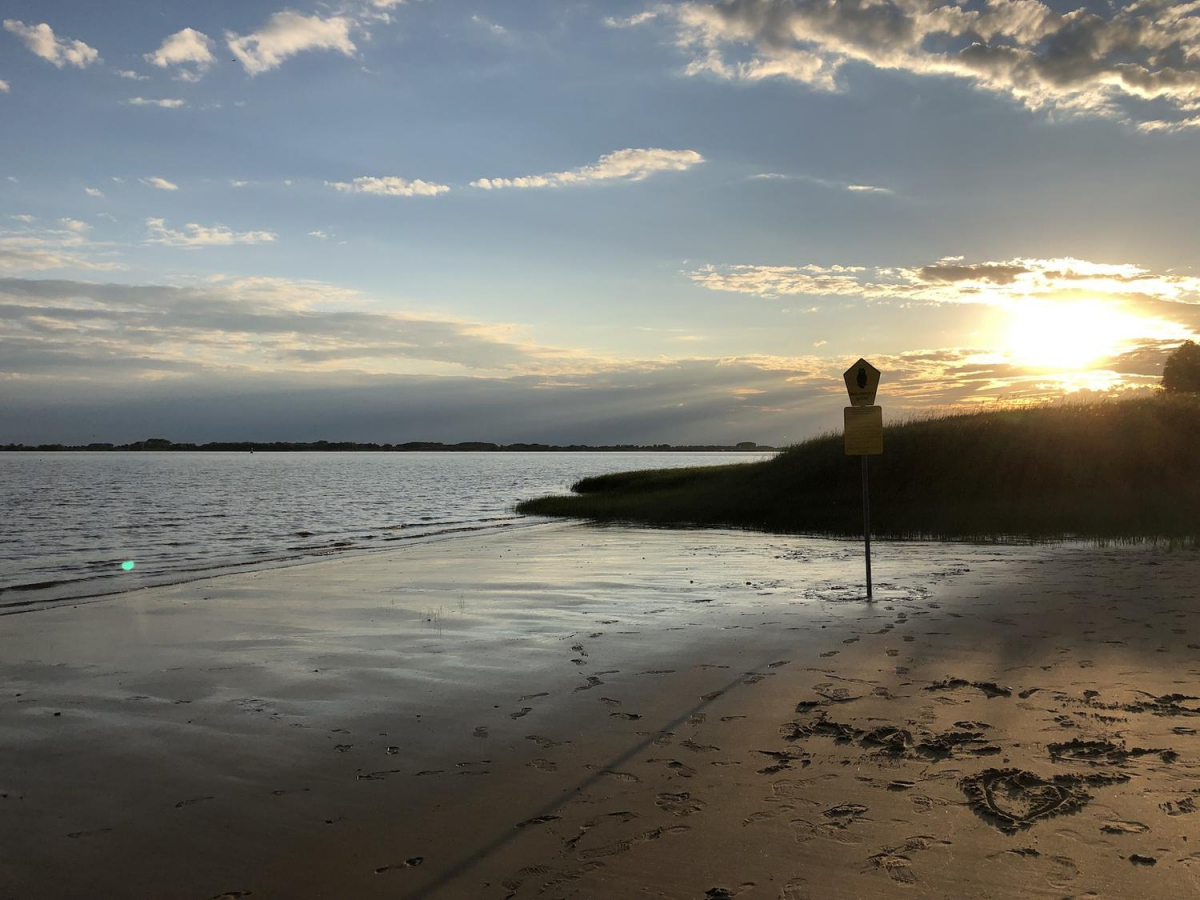
Bielenberg is just a half-hour drive from Hamburg and therefore very popular as an after-work-session spot for the Hamburgers. This spot in the river Elbe has a fine sandy beach where you can rig up and unrig. Enjoy kitesurfing alongside a beautiful landscape. The water here is choppy, but when the wind is stronger, a small chop wave builds up which is ideal for jumping with the twintip or riding a directional.
ABOUT THE COUNTRY
A Brief History of Germany
Germany has an eventful history, to say the least. The Germanic tribes advanced from the North toward the South even before the era began, and when the Roman Empire fell, they settled within those then borders. During the Middle Ages there were great misfortunes for the people such as the raging of the Black Death. This event in particular led to pogroms against Jews. All Jews were either murdered or exiled; many fled to Poland. These disasters meant that Germany's development was not very fast: as a result, there was a lot going on, not only politically but also religiously and economically.
Many turbulent years followed, amongst them the Thirty Years' War with France, Spain, and Sweden. Much of that was fought in Germany, leaving the country blighted. Then, there was the battle against the French during the time of Napoleon Bonaparte (1789-1815). After this period Germany wanted to stabilize power, so the German states united as the "German Confederation." In 1849 came the constitution for the German Empire with a Reichstag as legislature and universal suffrage.
The empire was authoritarian, anti-liberal and strongly militaristic.
Under the leadership of Reich Chancellor Otto Bismarck, Germany became economically stronger: with much territory conquered overseas, such as Namibia, to trade. Wilhelm II succeeded him but his new course (for trade) made the British, French, and Russians begin to form an anti-German bloc, the Triple Entente.
In 1914, World War I ensued, a war glorified and initially fully supported by many people of all parties. However, the price paid for this war was high: the war ended with a trench war in which an awful lot of young soldiers died. In 1917, the Americans entered the war and Germany came to realize that she could not win the battle and had to negotiate with the Allies to end the war.
The period between World War I and World War II is also called the interwar period. The Germans were given a more socialist government and the country could not recover well and fell into a great depression. Economically things were very bad and after the stock market crash in America, the economy collapsed completely.
Shortly after, or actually during this period, Adolf Hitler came to power (1933). He emerged as a dictator: citizens were given far fewer rights, and school was placed under state control. Jews in particular faced severe discriminatory measures. At this time, the population started to get thoroughly indoctrinated. Censorship was introduced. It became impossible for newspapers, radio stations, and even art to freely spread feelings, thoughts and information. At this time the Penal camps were already built. Initially for political opponents, but later Jews, homosexuals, and the Romani people ended up there too. Germany isolated while Hitler reintroduced conscription, produced superior weapons, and expanded the army.
On Sept. 1, 1939, after months full of threats, German troops crossed the Polish border, ending the Interwar period and beginning World War II. On May 10, Germany attacked the Netherlands, France, and Belgium. The Netherlands surrendered after five days. Not long after, France also succumbed to the now practiced German armies (the Blitzkrieg). Years of heavy fighting and gross war crimes followed with millions of casualties. The extermination camps killed people in large numbers in an unimaginably inhumane way. The estimate is 62 to 72 million people. A shocking, unfathomable number.
There was growing opposition to the war and the way Hitler conducted it. And after several failed attacks, including in France, things went downhill for the Nazis: in 1945 the Soviets and Americans conquered large parts of the east and west. Hitler retreated to Berlin and committed suicide.
After WW2, Germany was divided into West Germany (the Federal Republic of Germany) and East Germany (the German Democratic Republic). A wall divided Berlin, which was situated on the border. It was not until the early 1970s that east and west started talking. After the fall of the wall—a symbol for the divide east and west—in 1989, the borders opened. Yet, it took several years until the Federal Republic of Germany was formed (1990 to present).
Other Attractions in Germany
For those who want to learn more about Germany's eventful history, opt to visit parts of the fallen wall between east and west Berlin. Apart from the cultural sights, Berlin has much more to offer: from underground clubs to Europe's best flea markets. Rather have more action but still want to enjoy some time in a city? Visit Munich and surf the river! This is a popular activity for both locals and tourists, so there are almost always surfers riding the wave behind the bridge in the Eisbach.
As Germany holds the world record for the number of brands and types of beer, this country definitely has plenty of good places to enjoy a cold beer at some point! You might want to do so, during "Oktoberfest"! This is an annual folk festival in Munich. It is considered the largest beer festival and folk festival in the world.
Apart from the cities, Germany also has beautiful nature such as National Park Hainich and National Park Jasmund. The latter has chalk cliffs and beautiful hiking trails, located on the Rügen peninsula which also has several beautiful kitesurfing spots like "Wiek."
Getting to Germany
To travel to and within Germany, you can use the extensive train network (Deutsche Bahn). A more sustainable choice. Many international trains go to surrounding European countries such as the Netherlands and Austria. Also within the country, it’s easy to hop on a train. From Hamburg trains run to Greifswald (where Loissin is located).
The major cities almost all have international airports. Some are also busy transfer airports for onward destinations. For example, you often fly through Munich when traveling to distant destinations from Europe, such as South Africa.
Airlines like British Airways and KLM fly to cities like Hamburg and Berlin. Hamburg is a good base to start your kitesurfing vacation in Germany and from Hamburg airport you can rent a car to drive on the vast "Deutsche Autobahn" towards one of the many beautiful kitesurf spots Germany holds.
USEFUL RESOURCES
The Netherlands, also known as Holland, is a small country but it’s not to be underestimated when it comes to kiteboarding. With over 450 kilometers of coastline, there are many spots where kiteboarders can kite their heart out. It’s even possible to ride throughout the year provided you have a good wetsuit or a drysuit for the coldest days.
HIGHLIGHTS OF THE NETHERLANDS
SPOTS FOR ANY WIND DIRECTION
As kiteboarders we rely on a safe wind direction to go kiting. The wind direction will therefore play a large role in deciding which spot you choose for your session. The Netherlands doesn’t only provide kiting on the coastline. There are also a couple of lakes where kiteboarding is allowed making them perfect spots for the days when the wind is offshore on the coastline.
WIDE BEACHES
You know those spots where kites are parked almost on top of one another and it’s always a struggle to launch your kite on the little strip of beach available? Surely there are a few of those in the Netherlands, especially when it’s high season but there are also numerous spots where the beach stretches over a 100 meters from dune to coastline, hello space!
GO RIDE A BIKE!
It doesn’t really matter where you are in the Netherlands, there’s always a bike path close by. Rent a bike and explore parts of the country on two wheels, like a local. You can make stops at tourist attractions along the way or at a pannenkoekenhuis and eat some delicious Dutch pancakes or poffertjes.
TULIP FIELDS, WINDMILLS AND CHEESE
This is what the Netherlands is known for. The best time to come view the tulip fields is from the end of March until mid-May. The windmills can be visited year-round and of course it’s always possible to taste some delicious Dutch cheese. A little less well-known is our love for fried snacks - be sure to visit a ‘frituur’ to get your taste of a ‘frikandel’ or ‘kroket’!
KITESURFING IN THE NETHERLANDS
The Netherlands offers a variety of spots where kiters can ride. A majority of the spots face the North Sea which means the conditions can be pretty tough for beginners but it’s a heaven for big kickers that help you boost your jumps even higher.
Just starting out or prefer flatwater spots to practice your tricks? Schellinkhout or the Zandmotor are great for this although it can get crowded pretty quickly. Either way, make sure to bring a wetsuit. Even during the summer the water is pretty cold and it’s best to wear a shorty or thin full wetsuit.
When entering the beach, there will be signs that describe hazards at the spot and whether or not kiting is allowed. Check signs carefully before pumping up your kite.
With such a large coastline, many watersport activities and a lot of swimming tourists during the summer, the Netherlands has a royal sea rescue institution. If you ever happen to lose your board or kite make sure you report this to them and mention whether you’re safely back on land so they don’t waste resources looking for you out on the water. For those planning to stay longer in the Netherlands, you can order free stickers to put on your gear with your name and phone number so you can be contacted easily once your gear is found. The Royal Netherlands Sea Rescue Institution works on the basis of donations and a team of volunteers so make sure to support them if you can as they might end up saving your life one day!
WHEN IS THE BEST TIME TO KITESURF IN THE NETHERLANDS
Depending on your preferred riding style, there are different times when kiting in the Netherlands is optimal for you. If you prefer stormy sessions and boosting high jumps, you’ll love the autumn and winter seasons when it’s blowing a constant 25+ knots, but even better are the winter storms which will treat you to 30+ knots of wind. Be aware of the rough conditions and know your own limits. Storm kiting can be dangerous if you’re not experienced and knowledgeable about safety procedures.
If you prefer cruising or wave riding, spring is the ideal time to go kiting. The wind may not be as reliable as in autumn and winter but there are definitely some beautiful days when it’s perfect to go for a cruise. For beginner and intermediate kiteboarders this is a perfect time to take your skills to the next level.
The season with the least windy days is summer. If you’ve already discovered foiling then that is the perfect time to get your foil out and glide on the calm sea.
WHAT ARE THE BEST KITESURF SPOTS IN THE NETHERLANDS?
Brouwersdam
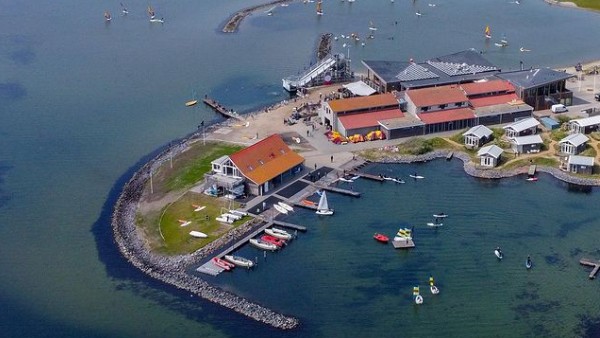
Photo courtesy of Surfcentrum Brouwersdam
This is a beautiful and very accessible spot in the south of the Netherlands with a huge beach that stretches approximately 500 meters from dune to coastline and is about 2 kilometers long. Riding conditions are perfect for beginners, freestyle and freeride as the spot is located in a bay with relatively flat water and you’re able to walk out for about 200 meters in the water. There is free parking available at this spot, accommodations can be found close by and there are plenty of places to get food and drinks. Be aware, this spot can get extremely crowded.
Ideal wind directions: northeast, north, northwest, west and southwest
Zandvoort Aan Zee
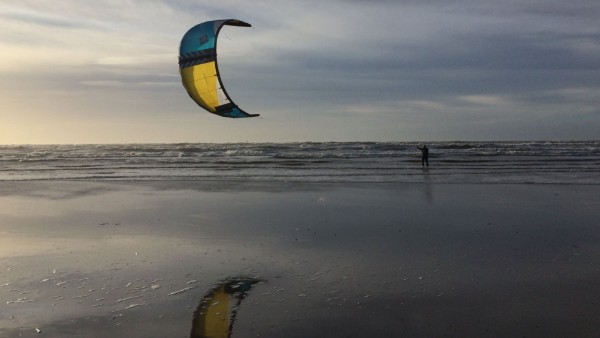
Photo courtesy of IKO Center Kitezone
An amazing spot that usually isn’t crowded. Here you’re kiting directly on the North Sea which means you can experience some waves and chop making this a nice spot for wave riding, freeriding and big air. The Redbull Megaloop challenge has taken place several times at this spot. Beware of rip currents and strong currents in general. During the summer, the beach will be crowded with beachgoers.
Ideal wind directions: southwest, west, northwest, north and northeast
Zandmotor
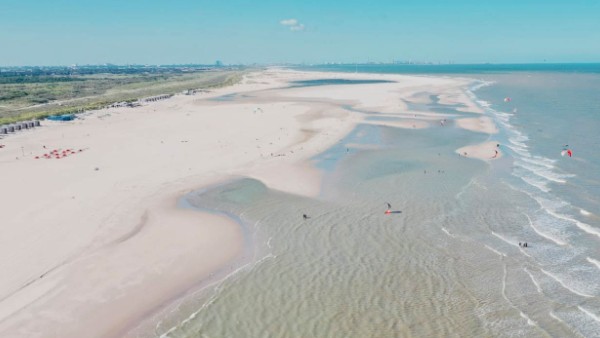
Photo courtesy of IKO Center kiteboardschool.nl
This is a very special spot that offers kiteboarding in different conditions. Whether you feel like kiting on flat water or in the sea, both options are available to you. ‘De Zandmotor’ is an artificial peninsula where you can find what is essentially a man-made ‘lake’ filled with seawater right next to the sea. All types of kitesurfing can be done at this spot due to the different conditions. It can get very crowded on good wind days with a wide range of kitesurfers from beginners with their instructors to the more advanced riders performing impressive tricks.
Ideal wind directions: all wind directions, but offshore wind is not ideal due to turbulence caused by the sand dunes.
Schellinkhout
This spot is located at a lake and is very popular with locals. It’s perfect for practicing freestyle but also great for beginners with flat and shallow water for up to 500 meters from the beach. There’s not as much room to set up your kite as there will be at some of the other spots but there’s a small beach and a field with grass. There are obstacles at this spot that you should watch out for including trees, waste bins and swimming areas and you’re not allowed to kite in front of the harbour.
Ideal wind directions: northwest, north, northeast, east, southeast and south
Rockanje
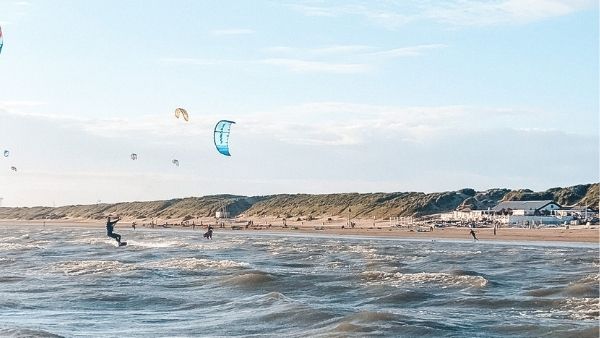
Photo courtesy of IKO Center Loops and Barrels
Rockanje is roughly an hour away from Rotterdam by car. It’s a very large flat water spot but it’s not well-known so it’s not busy with kitesurfers yet. The spot is blocked from the ocean by big sandbanks, which you can ride towards for even flatter water. You can also go downwind to Oostvoorne and ride back upwind. Above 25 knots, the water gets a bit choppy.
Ideal wind direction: southwest
's-Gravenzande
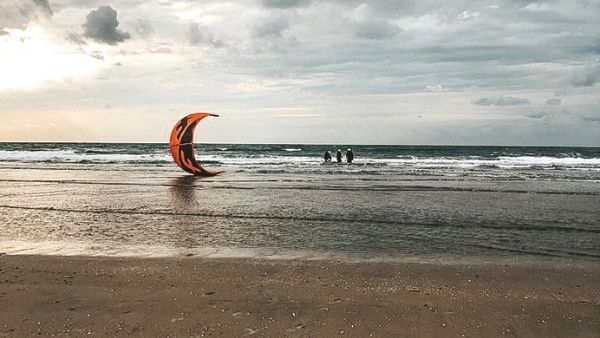
Photo courtesy of IKO Center Loops and Barrels
's-Gravenzande is a wave spot between the Hague and Hoek van Holland. It’s a hidden spot, so it’s not very crowded.
Ideal wind direction: northwest
Noordwijk

Photo courtesy of IKO Center Beach Break
Noordwijk is about 45 minutes away from Amsterdam by car. Wind strength varies from 12 to 45 knots, with stronger wind in the winter. Water conditions vary between flat to really big waves, depending on the strength of the wind. Most of the time this spot has choppy water with some waves. There’s also a large area for launching.
Ideal wind directions: south, west and northwest
ABOUT THE COUNTRY
Brief History of the Netherlands
The Netherlands is a small country located in western Europe, famous for having a significant percentage of its land below sea level. There are many ways in which the Dutch are stopping the sea from entering the land, through sand dunes, dams and wave breakers on the beach. The Netherlands once had an overseas colony that included what is now Indonesia and Suriname, and the influence of these former colonies can still be found today all over Holland. During World War II, the Netherlands was occupied by the Germans and liberation day is a national holiday celebrated on the 5th of May. Their love for the color orange stems from the royal family whose last name literally translated is ‘from orange.’ The whole of the Netherlands turns orange when celebrating the King’s birthday on April 27th
Things to Do When There’s No Wind
Water and Beach Activities
The Dutch coastline is full of beach pavilions which offer a range of facilities and activities, including ‘bumperball’, volleyball, beach tennis and soccer. Others will offer wave surfing, stand up paddle boarding, cycling or even jumping onto a huge inflated cushion to be launched into the water. Usually they will have space for you to sit and enjoy a drink or a full meal and at the more well-known and busy kitespots it’s possible for them to also have (hot) showers available.
Go Cycling
There are bike paths all over the Netherlands. Some go through a city or through the sand dunes but there are also bike trails through forests that may be slightly more challenging and require a mountain bike. No matter what sort of biking you want to do, it’s possible to rent all sorts of bikes in almost every city in the Netherlands. If you’re not up for a day of heavy peddling, then they will even have e-bikes for your convenience.
Visit ‘Keukenhof’
If you’re in the Netherlands from the end of March until mid-May, you’re lucky as this is when the tulips bloom and fields full of this beautiful flower can be seen. You can drive or bike past fields or you can visit a park made especially for tourists called Keukenhof.
Visit a City
There are many different cities in the Netherlands that are worth a visit. Some have a rich history for you to discover while others offer access to breweries, canal boat tours, a variety of markets and other shopping and food experiences. Some cities that are definitely worth a visit on a non-windy day are Amsterdam, Rotterdam, Utrecht, Breda and Maastricht.
Getting to and Around the Netherlands
The Netherlands is easy to access no matter your mode of transportation.
There are several airports in the country. The largest is Schiphol Airport in Amsterdam. Most long-haul international flights will arrive here, in addition to flights from all over Europe.
The Netherlands is also reachable by land over many motorways. Neighbouring countries Germany and Belgium have good roads as well so wherever you’re driving from, you’ll be able to reach the Netherlands with minimal trouble.
There are also many ports and harbors where you can enter with your boat, just make sure to contact port authorities beforehand to ensure that there’s enough space for your boat.
Getting around Holland is also a breeze. Public transportation is well-developed and it’s definitely recommended if you don’t have a car. Although there may be minor delays now and then, trains and buses generally run on time. You can usually pay for your ticket with cash, debit or credit card and you can easily plan your trip ahead of time online on 9292.nl.
USEFUL RESOURCES
Egypt is well-known for its wide sandy beaches and shallow, flat water. With pleasant temperatures year-round and steady winds between April and October, Egypt is a great kiteboarding holiday destination, to say the least!
HIGHLIGHTS OF EGYPT
FLAT WATER LAGOONS
Egypt has some amazing flat water lagoons with perfect conditions if you like kiteboarding in warm temperatures and steady winds. Freestyle kiteboarders can play their hearts out in Egypt, because flat water makes this a perfect place to kite.
COLORFUL CORAL REEFS
Don’t just stay above water, take a look under the water, too. Go swimming, snorkeling, and diving with exotic fish. The Red Sea is a world-class diving destination.
RELAXATION
Many of the hotels located on the waterfront of kitesurf spots offer wellness packages. From massages to facials, allow yourself to relax after a kite session.
KITE CRUISES
Imagine waking up in the middle of the Red Sea with a jaw-dropping sunrise and clear, blue water. Goal of the day: chasing the best wind for another ultimate session. Freedom combined with luxury and, of course, every single day you get to visit the most beautiful kitespots Egypt has to offer.
KITESURFING IN EGYPT
Egypt is a destination where sunshine is guaranteed, perfect for kitesurfers who are mainly looking for an eat-kite-sleep kitesurfing holiday.The desert and its sand dunes, the space on the water, the steady winds which blow during the greater part of the year, and the underwater world make Egypt a wonderful destination for a kitesurfing vacation!
WHEN IS THE BEST TIME TO KITESURF IN EGYPT?
You’ll experience wind throughout the year, but the best time to visit Egypt for kitesurfing is between April and October when the wind is the most consistent.
WHAT ARE THE BEST KITESURF SPOTS IN EGYPT?
Hurghada

Photo: Colona Watersports
You’ve probably heard of this place, and there’s good reason for that. Hurghada is one of Egypt’s most popular beach resorts.
Diving, snorkeling. and of course kitesurfing! In Hurghada you’ll find shallow waters near the beach, but a bit further out you’ll find deeper waters perfect for practicing new tricks.
El Gouna
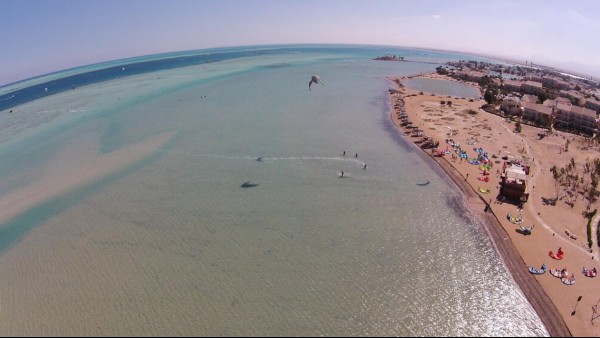
Photo: Kite People
A short drive (20km) from Hurghada, El Gouna is a place that is increasing in popularity. From there you can see the many villas and luxury hotels that have been built here in recent years. But don’t let that fool you, because El Gouna is still best known for its beautiful coral reefs and flat, shallow waters—perfect for learning to kitesurf.
Safaga
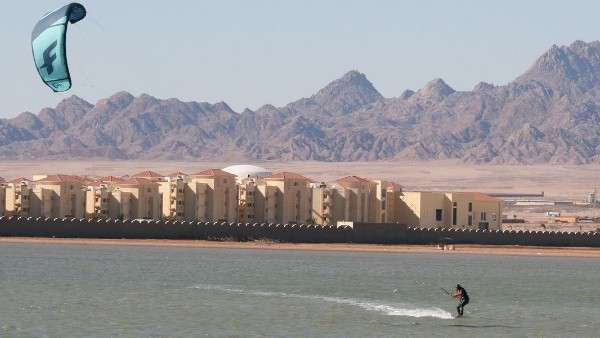
Photo: Tornado Surf
South of Hurghada lies Safaga, which once was a quiet fishing village. Safaga boasts a unique desert landscape—wide, sandy beaches and clear, turquoise waters surrounded by mountains. There is not much to do beyond kitesurfing, but who needs more than kiting if you opt for a kitesurfing holiday!?
Ras Sedr
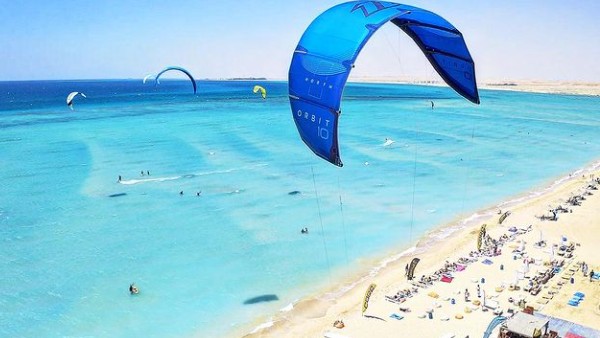
Photo: Soul Kitesurfing Center
Ras Sedr has almost 100 km of coastline with waters great for kitesurfing. The shallow waters here are increasingly popular among kiters. Aside from watersports, you can enjoy bird watching, as Ras Sidr is a hub for migrating birds.
Sharm El Sheikh
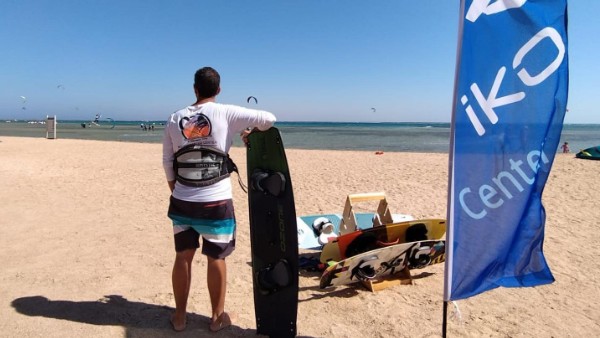
Photo: The Kite Bubble
A short taxi ride from the airport with a wide range of luxury hotels to choose from, Sharm El Sheikh is popular among kitesurfers who like to bring their non-kitesurfing partners too.
Marsa Alam

Photo: Wadi Lahmi Kitesurfing Center
Another windy pearl, Marsa Alam is a large kite spot with flat water shielded by a reef (nice for snorkeling, too). You’ll find a lot of all-inclusive hotels here which offer on-the-kitespot accommodations that are near the water.
ABOUT THE COUNTRY
A Brief History of Egypt
The ancient Egyptian civilization, well-known for its mummies, tombs, and pyramids, flourished for thousands of years. Between 2200 BCE and 332 BCE Ancient Egypt was sometimes united into one empire led by one king called the pharaoh. It was the custom of these kings to have a pyramid or two built as a tomb for themselves. Fun fact: did you know Cleopatra wasn’t actually Egyptian? She was born in Egypt, but her family was originally from Macedonia. In the 7th century, the Arabs conquered Egypt and it became part of an Islamic empire ruled by Baghdad.
The Nile River has been a natural lifeline and important economic engine since ancient times. Egypt has been dominated over the years by several colonial powers including the British. In 1952, a group of Egyptian military officers (“the free officers”) deposed the king, and with him, the British. The country has been unstable at times. Mubarak—the president ruling with absolute power—was deposed in 2011, after which elections followed. These parliamentary elections led to a presidential election in which a president elected from the Muslim Brotherhood was chosen to rule.
Other Attractions in Egypt
Aside from kitesurfing, diving, and snorkeling, you should definitely visit Cairo’s impressive Egyptian Museum. There you can admire an amazing collection of ancient Egyptian artifacts that take you back to the fascinating world of the ancient Egyptians, including the death mask of Tutankhamun!The Pyramids of Giza and the Sphinx are fairly close to Cairo too, and worth visiting. Last but not least, a quad bike or 4x4 Jeep trip through the desert is a rad day-trip option if you’re an adventurous spirit.
Getting to Egypt
Many tour operators offer all-inclusive kitesurfing holiday packages to Egypt: flight plus hotel directly on the waterfront of one of the amazing kitesurfing spots Egypt has to offer, such as El Gouna or Marsa Alam. Transavia, Swiss Austrian, Easyjet, and Saudi Arabian Airlines offer direct flights to Cairo where you can hop in a cab to your final destination.
USEFUL RESOURCES
SIMILAR KITESURFING DESTINATIONS
SPOT
WORLD > AFRICA > EGYPT > HURGHADA
HURGHADA
Hurghada is a perfect kitesurfing spot for a comfortable holiday where you’ll find yourself enjoying shallow, flat water, and enjoying the sun and steady wind of Egypt. Hurghada has a number of IKO Centers, some of which include kite equipment storage, compressors, beach assistance, purewater showers, changing rooms, bathrooms, and bars/restaurants onsite where you can chill out after your session using the free Wi-Fi while letting your kids play in the kids area.
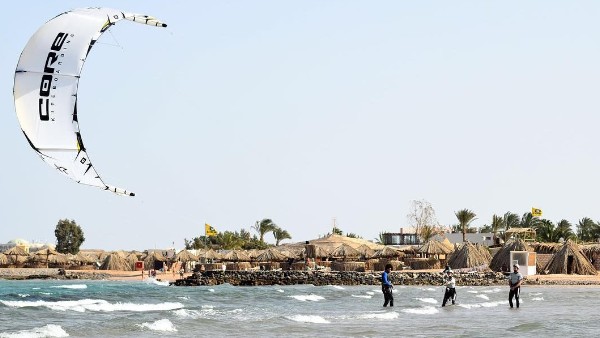
Photo: Colona Watersports
HIGHLIGHTS
VACATION PACKAGES
Lots of cheap package deals to visit this clear water kitesurfing holiday gem. You can stay in an all-inclusive beachfront hotel which makes for a hassle-free destination—even for families or groups with some non-kitesurfers amongst them!
NIGHTLIFE
Hurghada town has many bars and clubs, so this Egyptian kitesurfing destination is perfect if you want to loosen up your muscles by dancing after hours.
WATERSPORTS
Hurghada is a prime watersports holiday destination due to the many options on (and under) the beautiful turquoise surface. Try snorkeling, diving, or hopping on a jet ski.
FLAT AND SHALLOW WATER
The flat water—shallow for a few dozen meters—offers perfect conditions for beginners, freeriders, and freestyle kitesurfers. It’s a perfect destination to learn about kitesurfing and to progress in the sport. You might even spot a dolphin or two during your kitesurfing course!
KITESURFING IN HURGHADA
You’ll be afforded turquoise water, sunny days, and wind for most of the year, too! This Egyptian kitesurfing destination is popular for many reasons.
The thermal wind in Egypt is perfect for kitesurfing because it’s dependable and stable. The wind blows from the northwest in the morning and by the time you might be having your second cup of coffee, it becomes a perfectly stable northwind! Hit the water and come back for lunch around 1 p.m. because the wind usually has a dip around that time. In the afternoon, it will pick up again for you to enjoy a second session with (usually) stronger winds.
Wind, weather and water
With an average of 15 to 25 knots of wind, Egypt offers some great conditions due to its pleasant weather and water temperatures which vary between 20 degrees celsius during winter and 29 degrees celsius during the summer months. Therefore, a wetsuit (3/2mm) is recommended from December to April. During spring and fall you can easily wear a shorty wetsuit and, if you are looking for a kitesurfing holiday destination where you can kite in shorts or bikini, the best time for you to visit is during the summer when you can find the strongest winds and most favorable weather. March to November is Egypt’s peak-season for kitesurfing holidays.
WHAT ARE THE BEST BEACHES FOR KITESURFING IN HURGHADA?
Megawish Beach
This 2km long sandy beach is split into two areas: the school bay, which is basically a training bay for beginner kiters (and also for those who are not yet independent and confident enough to kite alone). The second spot (bay) is an intermediate area for riders who can go up-wind confidently.
Wind direction: Side-shore & side-offshore.
Water conditions: Flat, shallow water with deeper choppy parts.
Discipline(s): Beginners, freestyle, freeride.
Skill level: Beginners, freestyle and freeride.
Watch out for: (hazards) Mind the fishing boats and the reef.
Getting there: Fly to Cairo or book an all-inclusive flight and hotel. Walking distance from Hurghada town.
Tip: Your best option might be to stay in one of the beachfront hotels such as Aqua Marine.
Aqua Marine Private Beach (Megawish District)
At Jaz Aqua Marine—just minutes away from the airport—you can hit the water directly, whereas this hotel has its own private beach from where IKO Center Kite Marine operates.
Wind direction: Side-shore & side-offshore.
Water conditions: Flat, shallow water with deeper choppy parts too.
Discipline(s): Beginners, freestyle, freeride.
Skill level: Beginner, freeride/ freestyle.
Watch out for: (hazards)
Getting there: Fly to Cairo or book an all-inclusive flight and hotel.
Royal Beach Hurghada
Another great sandy beach spot with shallow water and a clean bottom. This spot is a perfect place to learn kitesurfing or improve your skills while freestyling or free riding the beautiful turquoise waters.
Wind direction: Side-shore
Water conditions: Flat, shallow water with deeper choppy parts too.
Discipline(s): Beginners, freeride and freestyle.
Skill level: Beginner to intermediate/ advanced (freestyle).
Watch out for: (hazards) Mind the fishing boats and the reef.Getting there: fly to Cairo or book an all-inclusive flight and hotel.
TRAVELING TO HURGHADA AS A KITER
Getting There
If you want to go kitesurfing in Egypt, book your flight to Cairo. Hurghada is a popular spot for a kitesurfing holiday because of the cheap (but good) package deals: you can book a flight and hotel (including airport transfers) to one of the many beachfront all-inclusive resorts. Taxis are affordable and can bring you to your hotel, the kitespot, or to one of the must-visit tourist sights such as the Great Pyramid of Giza.
Accommodation
There are plenty of choices for your stay in Hurghada. Options include many luxurious beachfront hotels, but also some smaller hotels in town. A lot of accommodations are all-inclusive which is pretty convenient for kitesurfers who want to focus on spending as much time on the water as possible.
Getting Around
Taxis are common in and around Hurghada. Many hotels offer airport transfers and you likely won’t need transport to go kitesurfing since many accommodations are situated near the water. Some of the IKO Centers offer kitesurfing storage options in order to make your kitesurfing holiday easy and relaxed!
Food and Drink
The all-inclusive concept is very popular in Egypt. But if you want to go out for lunch or dinner elsewhere, you’ll have good options in Hurghada. Some of the kite schools have a lagoon-view bar/restaurant. If you’d like to eat in town, we recommend Granada restaurant and pub as well as Bongoyo.
No Wind?
The resorts and hotels often offer a wide range of wellness experiences, such as soothing massages and body wraps. This is perfect for a day off the water to relax the muscles and recharge for your next kitesurf session. Of course, you can also indulge yourself in the rich Egyption culture by visiting the Great Pyramid of Giza. A quad bike or 4x4 Jeep tour is a cool option if you’re adventurous.
Useful Resources
|
Italy is a boot-shaped peninsula in the Northern Mediterranean Sea with more than 4,000 kilometers of coastline offering a variety of spots to riders of all levels and disciplines. You can sail in the flat water of the lakes or in the waves of its major Islands, always ending the day with good wine and delicious food!
HIGHLIGHTS OF ITALYA VARIETY OF CONDITIONS FOR RIDERS OF ALL LEVELS Italy is not comparable to any other country in the world. The whole coast, the northern lakes and its major islands offer a variety of spots in spring, summer and autumn. During winter, snow-lovers can have fun snowkiting in the Alps or in the Apennines. A PARADISE FOR LOVERS OF DELICIOUS FOOD AND GOOD WINE Italian food is loved and imitated all over the world, with an absolutely enviable food and wine legacy. Each region has its own culinary traditions. All of them can be discovered and tasted - perfect after a nice day of kitesurfing! PERFECT FOR NATURE LOVERS Italy is a great country for wind sports, but also for nature lovers and outdoor sport enthusiasts. Its seas with their crystal clear waters are wonderful places to explore while diving and are often awarded with the famous Blue Flag, a certification given to clean beaches and coastlines. You can walk along endless nature trails and climb one of Italy’s many mountains, including Mount Etna, an active volcano in Sicily. It's the highest peak in southern Italy and it's on the list of UNESCO World Heritage Sites. The country is also famous for its many spas, ideal for relaxing and regenerating in historic structures that date back to the ancient Romans HISTORICAL CITIES, MUSEUMS AND CULTURE Italy has more UNESCO World Heritage Sites than any other country in the world. From large cities to quaint villages, Vatican City to Rome, to the archaeological excavations of Herculaneum and Pompeii, you can literally walk through history! And of course there’s art, fashion, sports cars and music that can be enjoyed in some of the most beautiful cities, theaters and galleries in the world.
KITESURFING IN ITALYLike with food and culture, each region in Italy has something unique to offer kiters. You can sail in lakes surrounded by the green mountains of the north or enjoy the warmth of Sicily in the south with its famous Stagnone lagoon, surf the waves in Sardinia or one of the many spots along the east and west coasts. All of the spots are easily reachable by car and you can travel by train, plane or ferry which connects the islands with the mainland.
WHEN IS THE BEST TIME TO KITESURF IN ITALY?The best time to kitesurf in Italy is from March to October. Most of the spots in spring and summer have good wind everyday thanks to the thermal effect, while in the winter the wind is more intense.The water is warm during the spring and summer and requires only a short wetsuit but if you go kiting in autumn and winter, don’t forget to bring a long wetsuit. In lakes, colder waters require a long wetsuit all year round.
WHAT ARE THE BEST KITESURF SPOTS IN ITALY?
Lake Garda and Lake ComoLocated in the north of Italy, close to the border, these two lakes are perfect for kitesurfing thanks to thermal winds. |
Australia is one the best countries in the world for kiteboarding. Its coastline measures 35,877 kilometers, and the conditions range from flat water lakes to waves and windy coasts. Being so big, there is always wind somewhere and it’s full of hidden gems. White beaches and flat waters make for the perfect place to learn. One of the most famous locations, Safety Bay, is where you can probably spot a few champion kiters; it is popular for having consistently good conditions.
Australia is definitely up there when it comes to places to learn. You can find amazing schools all over the country, and beaches that are super safe because of how big they are. You can find flat water almost anywhere, which makes for the perfect learning condition. Many schools are IKO affiliated, which guarantees a high standard of safety and progression.
Capital: Canberra
Currency: Australian Dollar
Level: Beginner to Experienced
Winds: 10-40 knots (Depends where and when you go)
Kite Sizes: 7-9m Small / 10-14m Big
Flat Water Spots: Yes
Beach Break Spots: Yes
Wetsuit Needed?: Some places
Water Temperatures: South 17-25 °C; NE 23-27 °C; West 20-24 °C
Uncrowded Waters: Yes
Kiteboarding Lessons Average: 35- 80 USD Per Hour +/- depending if solo or group lessons and package
Daily Food Budget Average: 35 USD
Downwinder Spots: Yes
Argentina might not be on the most popular kiteboarding destinations list, but it definitely has some good spots and any level kiter is welcome. The water conditions are endless, you can kite lagoons, rivers, beaches or open waters. If you’re not sure where to go, you can go on organized kite tours where they take you around the Patagonia, or they even have some tours that are three days long where you go kiteboarding with other participants and have meals together. It is particularly popular December and January; depending on how you like to kite you should plan around that.
Other popular wind and water sports in Argentina are windsurfing, surfing, rafting, paragliding and fishing. Some fun things that you can do are learn and dance Tango, go sightseeing and visit the Recoleta cemetery, play tennis or hockey. Argentina is also popular for their nightlife, whether it is to go clubbing, bar hopping or listen to live music.
Capital: Buenos Aires
Currency: Argentine Peso
Level: Beginner to experienced
Winds: 15-25 knots when there is wind, up to 30 knots in Rodeo
Kite Sizes: 7-9 Small / 11-14 Big (Depends where and when you go)
Flat Water Spots: Yes
Beach Break Spots: Yes
Wetsuit Needed?: Yes
Water Temperatures: 18- 21 °C (December - April), 10- 17 °C (May - October)
Uncrowded Waters: Yes
Kiteboarding Lessons Average:
Daily Food Budget Average: $8 USD
Downwinder Spots: Yes
When you’re researching a vacation in Mexico, your non-kiter friends will bombard you with advice about Aztec ruins, tequila bars, $1 dollar tacos, deep-sea fishing, and cenotes. Suggestions for time-share rentals in Puerto Vallarta, Cabo San Lucas, and Cancun will follow. But your kiter friends know better. They’ll tell you about the beautiful turquoise and aquamarine waters in El Cuyo and the perfect foiling conditions in La Ventana. They’ll talk to you about the waves in Los Barilles and the flat water in Isla Blanca.
Mexico is a great place for a kiteboarding vacation because it offers every kiter every kind of riding condition. Whether you’re kiting the Pacific, the Atlantic, or the Gulf, you’ll find great conditions for kiteboarding, kitesurfing, and foiling in Mexico. And don’t disregard your non-kiter friends’ advice - Mexico also has some fantastic no-wind activities for your rest days. And you can have a great time in Mexico without spending a ton of money!
HIGHLIGHTS OF MEXICO
A VARIETY OF KITESURFING CONDITIONS
Like its neighbor to the north, the United States, Mexico has a spot for every level of kiter and every discipline. Both the East and West coasts have great waves, flat water, and foiling spots, and the gulf-side offers slightly stronger winds and good waves and chop for jumping. Regardless of the conditions, you’re looking for, almost every spot in Mexico is ideal for learning. Not only is the water warm and comfortable all year round, the most popular spots in Mexico offer very safe conditions for learning, while still offering challenges for more advanced kiters.
A NATURAL PLAYGROUND
Mexico has all of the natural beauty that any kiter could want. Aside from kiting, the country has fantastic waves for surfing and beautiful Cenotes where you can swim, paddleboard, snorkel, and dive. Baja California is a mountain-biking mecca, but if you’re more of a motorhead, you can go 4-wheeling in Cozumel. And if you’re tired of the land and the water, Mexico is also a great place for parasailing and paragliding or you can hit the zip-lines in Tulum.
A CULTURAL MECCA
Mexico is also a great place for a cultural fix. Chichen Itza, perhaps the most famous of the Aztec ruins, is located in the Yucatan, but you can also visit the Mayan ruins in the Riviera Maya, just 30 minutes from Tulum. If you’re in Oaxaca eating some of the best food in Mexico, you’re only 20 minutes from the pre-Columbian ruins of Monte Alban. And then there’s Mexico City. There’s not enough time here to talk about all the cultural attractions in that incredible city, but here is TripAdvisor’s take on the city.
KITESURFING IN MEXICO
Mexico does truly satisfy every kitesurfer’s desire. Whether you’re seeking out flat water paradise, foilboard heaven, or a surfer’s dream conditions, you can find it all in Mexico. The country is a winter escape for kiters in the Northern Hemisphere looking for warm, pretty water from October through May.
WHEN IS THE BEST TIME TO KITESURF IN MEXICO?
Although you can technically kite in Mexico all year around, the kind of wind that you’re going to travel for is typically between October through May. After that, the wind drops and the heat kicks way up.
WHAT ARE THE BEST KITESURF SPOTS IN MEXICO?
Mexico has a wide variety of kiting conditions and spots all along its coastline. Kiteboarding on the West Coast is very different than the East Coast and the gulf. But each spot has something wonderful to offer visitors.
La Ventana/El Sargento, Baja California
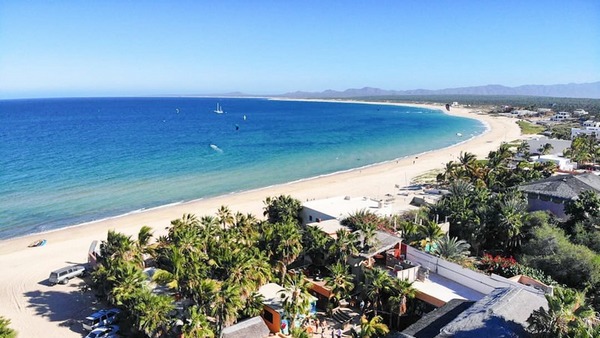
Discovered by windsurfers in the 1980s, La Ventana is located on the Sea of Cortez -- a warm-ish water paradise for foilers and twintippers seeking beautiful water and friendly faces. The bay is shaped like a “catcher’s mitt” -- making it a great, safe place for learning -- and foilers love the fact that the water gets pretty deep fast.
Thanks to the venturi effect between the Cacachilas mountains and the offshore Island of El Cerralvo, La Ventana gets an accelerated thermal wind almost every day. The average wind in La Ventana ranges from 10-25 knots. Occasionally, an “El Norte” wind comes through and kicks up the wind for about three or four days. Although you’re in Mexico, you’re still in the Pacific Ocean, so you’re going to need at least a shorty wetsuit. On the colder days, you might even want a 3/2 or 4/3, depending on your own inner temperature and preferences.
Los Barilles, Baja California
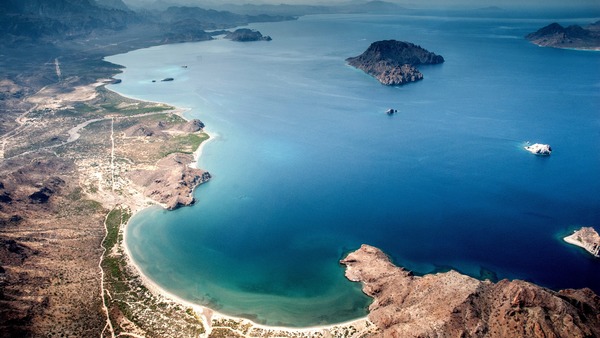
An hour drive south of La Ventana, Los Barilles feels like a big city compared to La Ventana. The road used to end at Los Barilles, which is why the town is so built up with seasonal residents, both kiters and pickleball players. The water and air temperatures are the same as La Ventana, but if you’re looking for waves, Los Barilles is the spot for you. An average day can start with a four to six foot swells and build to eight or ten feet! If you’re looking for paradise, with a little more civilization, Los Barilles is the place for you.
El Cuyo, Yucatan

Just two and a half hours drive from the hustle and bustle of Cancun, El Cuyo still feels like an undiscovered kite spot. The town is small and has very few services. There are a handful of restaurants near the charming town center, where children play soccer until late in the evening. It’s surprising there aren’t more kiters in El Cuyo because the kiting is great. The water is a lot warmer than the west side of Mexico, so you can get by with just a rashguard and board shorts. On a northeast or east side shore wind, the spot is perfect for riding the medium-sized waves. If you’re a beginner wave rider, this is a great place for learning, but the more advanced wave riders are also going to have a lot of fun. The water is shallow for a while, so it’s a decent place for learning, but it gets deep fast enough for foilers to enjoy the spot as well.
The average wind speed in the Yucatan is slightly higher than Baja, ranging from 12-25 knots. If you want to get away from it all, and ride some beautiful waves, head to El Cuyo.
Isla Blanca
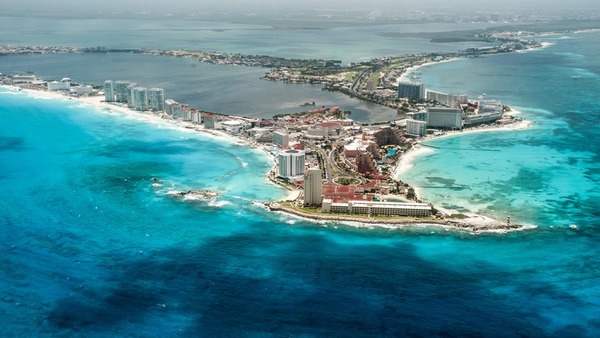
With its shallow, flat water, Isla Blanca is an ideal spot for learning. The “isla” is a large strip of sand in a shallow seawater lagoon. Advanced twintippers will also love this spot, but it’s not going to be a favorite for foilers, even with a very short mast.
Located just 25 miles north of Cancun, this small peninsula is a perfect blend of white sand beaches and beautiful jungle. Like most of Mexico, the windy season is from October/November to May/June. The winds at Isla Blanca average 10-30ish knots, and depending on the month, you may need a shorty.
Tulum

Although Tulum is not far from Cancun and is drivable to both El Cuyo and Isla Blanca, the town has a totally different vibe. It’s the kind of town that makes you think of yoga retreats and vegan restaurants. The wind is lighter than both El Cuyo and Isla Blanca, averaging 12-25 knots, but rarely as high as 25. The water is mostly chop with some waves farther out by the reef. It’s mostly onshore wind, so it can be a bit challenging to get out in the lighter winds, but once you’re out, it’s worth it. The spot is gorgeous, and even prettier from the water. The air temperature ranges from 20°C to 28°C and the water is about as warm during the kiting season.
ABOUT THE COUNTRY
Brief History of Mexico
Mexico is rich in history, tradition and culture. The country consists of 31 states and one federal district -- with many of Mexico’s rural areas still inhabited by indigenous people whose every day lives reflect those of their ancestors. With more than 100 million people living in Mexico, it is the third largest country in Latin America. A kiteboarding vacation to this amazing country wouldn’t be complete without a tour of the many ancient Mayan and Aztec ruins or a taste of the local cuisine.
Things to Do When There’s No Wind
Mexico has more to offer than just kiteboarding! The country is a natural playground for non-wind activities including swimming in Cenotes, diving, deep sea fishing, mountain biking and ATV touring, and any kind of boardsport -- stand up paddle, surf and skate! The country also has a deep history and rich culture. If you want to take a break from the water, you can head to the Aztec or Mayan ruins that are sprinkled throughout the country or take to the sky for parasailing and paragliding.
Getting to Mexico
Flying to and around Mexico is easy and convenient. The major entry points include San Jose del Cabo (SJD) and La Paz (LAP) for Baja kiting and Cancun (CUN) for the east coast and Yucatan. Once you arrive in Mexico, car rentals are usually reasonably priced depending on the season.
USEFUL RESOURCES
SIMILAR KITESURFING DESTINATIONS
Ever wondered where to find the perfect kitesurfing spot? Look no further than Vietnam, a heaven for kitesurfing enthusiasts. With its stunning beaches, consistent winds, and vibrant local culture, Vietnam offers an exhilarating experience for both beginners and seasoned surfers. Whether you're drawn to the bustling energy of Mui Ne or the serene beauty of Phan Rang, Vietnam's coastal gems promise excitement and adventure. Ready to catch the breeze and ride the waves? Stay tuned to discover why this Southeast Asian gem is an unparalleled kitesurfing paradise.
Best Kitesurfing Locations in Vietnam
Vietnam is a haven for kitesurfing enthusiasts, offering a unique blend of stunning landscapes, reliable wind conditions, and vibrant local culture. Whether you're new to kitesurfing or a seasoned pro looking for your next big adventure, Vietnam's diverse coastlines have something for everyone. Let's explore the top kitesurfing locations across this beautiful country.
Mui Ne
Known as the kitesurfing capital of Vietnam, Mui Ne is the ultimate hotspot for wind chasers. With its steady trade winds blowing from November to April, average wind speeds here reach around 12 to 20 knots, making it an ideal playground for kitesurfers. Besides, the town is bustling with numerous amenities to make your stay comfortable—think cozy beachfront resorts, kitesurfing schools, and tasty local eateries. If you're after reliable conditions and a lively atmosphere, Mui Ne won't disappoint.
Phan Rang
If you prefer less crowded beaches, Phan Rang is your go-to spot. Its reputation for consistent wind and spacious sands makes it a favorite among those seeking a quieter scene. What sets Phan Rang apart is its authentic local culture and hidden attractions. Here, you can explore traditional markets and take in the sights of ancient Cham towers. It’s a place where you can embrace both the thrill of kitesurfing and Vietnam's rich heritage.
Da Nang
In Da Nang, the coastline is a breathtaking blend of urban life and natural beauty. Imagine kitesurfing with a backdrop of vibrant city lights and bustling beaches. The city's accessibility to other tourist sites like the Marble Mountains and the ancient town of Hoi An makes it an appealing choice for travelers. Whether you're riding the waves or exploring local attractions, Da Nang provides a dynamic experience like no other.
Nha Trang
Famed for its vibrant beach scene, Nha Trang offers opportunities for both beginners and seasoned kitesurfers alike. The city is home to numerous kitesurfing schools where you can polish your skills or learn the ropes. The lively atmosphere, with beach parties and fun events, ensures there's never a dull moment. Whether you're catching your first wave or tackling advanced tricks, Nha Trang's supportive community is there to cheer you on.
Con Dao Islands
For those seeking a more remote adventure, the Con Dao Islands are a pristine paradise. With their crystal-clear waters and untouched beaches, they offer a serene escape from the usual kitesurfing spots. Ideal for experienced kitesurfers, the islands promise an exhilarating experience in a truly remote environment. If you crave solitude and scenic beauty to fuel your kitesurfing passion, Con Dao Islands are your perfect canvas.
Kitesurfing Conditions in Vietnam
Vietnam is a kitesurfer's paradise boasting ideal conditions that keep the waves packed throughout the year. With its long stretches of coastline, warm climate, and steady winds, it's a magnet for both beginner and experienced kitesurfers. Whether you're riding the waves or just starting out, understanding the conditions will help you make the most of your kitesurfing adventure.
Wind Patterns
Vietnam's wind patterns are as reliable as a clock. Each season brings its own charm, but consistency is what makes it a kitesurfing hotspot.
- Mui Ne: This place is famous for its strong, steady winds. The best time to visit is from November to April, when the northeast monsoon kicks in. Winds can range from 18 to 25 knots, perfect for riding waves or practicing trick
- Nha Trang: Here, the action peaks between November and March. The winds are milder compared to Mui Ne, making it a great spot for beginners.
- Phan Rang: Known for its wild and adventurous wind conditions. The best months to kite here are from November to March, where you can experience both flat water and small waves.
Are you aiming for the perfect balance? Aim for December or January to get the best out of these spots!
Water Temperatures
No wetsuit? No problem! Vietnam’s water temperatures are a dream come true for kitesurfers year-round.
- The coastlines flaunt temperatures ranging from 76°F to 86°F. Unlike other regions, where a thick wetsuit becomes your best friend, in Vietnam, you can enjoy a swim without hopping into neoprene.
- Summers: Waters are warm, inviting, and perfect for long hours of kitesurfing. It's like riding a liquid carpet under the sun.
- Winters: While colder elsewhere, Vietnam offers mild temperatures that dip just slightly, allowing you to keep your sessions long and enjoyable.
Ready to feel the sun on your back and the wind at your side? Dive into Vietnam's seas without fear of the chill!
About the Country
Vietnam is an enchanting land that charms visitors with its unique mix of ancient history and vibrant modern culture. From its bustling cities to its serene countryside, Vietnam offers a rich tapestry of experiences. If you're considering kitesurfing here, it's worth taking a moment to appreciate the country's fascinating background and current allure.
Brief History of Vietnam
Vietnam's history is both rich and complex, stretching back over 2,000 years. Originally ruled by various dynasties, it was heavily influenced by Chinese culture and politics. This influence is evident in Vietnam's rich tapestry of traditions and languages, much like threads in a beautiful tapestry.
Throughout the centuries, Vietnam has been a land of resilience, facing invasions and colonization. The French colonial period left a distinct mark on the country's architecture and cuisine. However, the Vietnam War in the mid-20th century was a defining moment, shaping its modern identity and spirit like a blacksmith forging steel.
Vibrant Culture and Cuisine
Vietnam's culture is a vibrant quilt patched together by diverse traditions, folk art, and a strong sense of community. Imagine a vivid painting that's alive with colors and stories. It is a country where ancient temples stand beside skyscrapers, and traditional markets hum with the chatter of locals and the sizzling of street food.
Modern-Day Vietnam: A Tourist's Paradise
Today, Vietnam is on many travel bucket lists for its stunning landscapes and welcoming locals. The country's coastlines offer some of the most breathtaking beaches and are perfect for adventurous activities like kitesurfing. It's a place where nature paints stunning canvases every day, from the lush green mountains of Sapa to the tranquil waters of Ha Long Bay.
If you’re visiting for kitesurfing, you might be surprised to discover the friendly and curious locals, eager to share their culture with visitors. They are the heartbeats of the land, like the rhythm in a favorite song.
Whether you're exploring the historic streets of Hanoi or lounging on the sunny beaches of Da Nang, Vietnam promises an unforgettable journey. Each corner of the country tells a story, waiting for you to listen and become part of it.
In Vietnam, adventure and history are always at your doorstep, inviting you to explore and soak in all the wonders it has to offer.
Other Attractions in Vietnam
Vietnam is a treasure trove of exciting activities and vibrant cultural experiences just waiting to be explored. Whether you're a foodie, a night owl, or someone who loves a good adventure, Vietnam has something for everyone. Here's a look at some of the must-see attractions and activities you shouldn't miss while visiting this diverse country.
Delicious Vietnamese Cuisine
Vietnamese food is a feast for all senses with its rich flavors and enticing aromas. If you're passionate about food, you'll find a variety of delectable dishes to try:
- Pho: This is a classic Vietnamese noodle soup that's both comforting and satisfying. Imagine steaming hot broth poured over rice noodles, piled high with herbs and your choice of beef or chicken. It's the perfect meal to start or end your day.
-
Banh Mi: A Vietnamese take on the sandwich, this street food is packed with a variety of ingredients like pickled vegetables, pâté, and various meats, all wrapped in a crispy baguette.
-
Goi Cuon: Also known as spring rolls, these refreshing morsels are made with fresh vegetables and shrimp wrapped in delicate rice paper. Dunk them in peanut sauce for an unforgettable taste.
Vibrant Nightlife
When the sun sets, Vietnam transforms into a lively playground with its bustling nightlife. There's something for everyone, whether you prefer a laid-back lounge or an energetic club:
- Ho Chi Minh City: This city never sleeps. You'll find lively bars and clubs where you can dance until dawn. Check out the rooftop bars for a breathtaking view of the city skyline.
- Hanoi: Hanoi offers a charming mix of old-world charm and modern energy. Explore the Old Quarter for unique bars that whisper tales of yesteryear while serving up innovative cocktails.
- Da Nang: Known for its beachside vibes, Da Nang has relaxed beach bars and live music venues where the tunes carry you through the night.
Adventures and Activities
Vietnam is not only about food and nightlife. It also offers a range of thrilling activities that keep you on your toes:
- Exploring Caves in Phong Nha: Phong Nha-Ke Bang National Park is home to some of the world's largest caves. Trek through these ancient limestone formations and discover an underground world.
- Cruising Ha Long Bay: Picture yourself gliding through emerald waters, scattered with towering limestone islands. Opt for a day cruise or an overnight stay on a traditional junk boat to soak in the tranquility.
- Mekong Delta Tours: Navigate the maze of waterways in the Mekong Delta. Discover floating markets, lush fruit orchards, and local villages that give you a taste of rural life.
Engaging Festivals and Culture
Diving into Vietnam's festivals and cultural practices gives you a deeper appreciation for this vibrant nation. Attend the colorful Tet Festival if you visit around the Lunar New Year, or participate in a lantern festival in Hoi An, where the streets glow with multi-colored lanterns floating along the river.
Vietnam is brimming with attractions that cater to every taste and interest. Whether you’re dining on street food or exploring natural wonders, each day offers a thrilling adventure that leaves you wanting more.
Safety Tips for Kitesurfing in Vietnam
When you're gearing up for an exhilarating kitesurfing adventure in Vietnam, it's easy to get caught up in the thrill of the ride. However, keeping safety in mind is just as important as having fun. Kitesurfing combines the power of the wind with the waves, creating an experience like no other. Ensuring that you have a safe trip involves understanding local regulations and using the right safety gear.
Understanding Local Regulations
Vietnam is a fantastic place for kitesurfing, but staying safe means knowing the local rules. Every beach can have specific guidelines that keep both the environment and you safe. Why do these regulations matter? Ignoring them can lead to accidents or trouble with local authorities.
Familiarize yourself with any restricted zones and weather warnings. Speak with local kitesurfing centers. These professionals provide insights into the best practices for each beach.
Remember, you wouldn't drive into a new city without knowing its rules. Think of kitesurfing in a new place the same way. Local regulations are there for your safety and to help protect these beautiful coastal environments.
Safety Gear and Precautions
Safety gear is your best friend when kitesurfing. Not only does it protect you from potential harm, but it also gives you the confidence to enjoy the waves fully. We recommend our IKO eCourse ¨Equipment¨ to know which equipment you need
Before heading out, always check your gear. A thorough inspection reduces the risk of things going wrong on the water. An experienced kitesurfer once said, “Check twice, ride secure.” It’s not just about having fun; it’s about doing it safely.
By understanding these aspects of kitesurfing in Vietnam, you'll be more prepared to tackle the waves with both excitement and caution. Enjoy the adventure, but remember: Safety first!
Cultural Considerations
Vietnam is not just a beautiful destination for kitesurfing; it's also a place rich with vibrant culture and warm hospitality. Understanding and respecting local customs enhances your kitesurfing experience and builds goodwill with the communities. Let's explore how we can kite responsibly and foster meaningful interactions with the locals.
Local Etiquette
Interacting with local communities in Vietnam requires sensitivity to their customs and traditions. Here are some tips to help ensure your experience is respectful and enjoyable:
- Use Basic Vietnamese Phrases: A simple "xin chào" (hello) or "cảm ơn" (thank you) shows respect and a willingness to connect. This small effort often goes a long way in establishing rapport.
- Dress Modestly: While the beach might allow for more relaxed attire, remember to cover up when venturing into villages or cities. Traditional areas appreciate modest clothing, especially in temples or rural settings.
- Respect Private Property: Avoid walking through private land without permission. Many kitesurfing spots are near local communities, and being considerate of their property rights is essential.
- Mind Your Manners: Vietnamese culture values politeness. A gentle demeanor and a friendly smile can help break cultural barriers. Avoid loud or disruptive behavior, especially in community-driven areas.
- Be Aware of Environmental Impact: Vietnam’s stunning landscapes are precious to both locals and visitors. Make sure to leave no trace behind—pick up your trash and avoid damaging natural habitats.
Incorporating these practices not only respects the people who call Vietnam home but also enriches your adventure. It's often in these small gestures that we find the most rewarding connections. Enjoying the waves and wind is amazing, but leaving a positive impact ensures that your presence as a kitesurfer is welcomed and celebrated.
How to Get to Vietnam
Planning a kitesurfing adventure in Vietnam? You're in for an unforgettable experience filled with excitement and cultural exploration. But first, let's talk about how to get there. Vietnam’s diverse landscapes entice travelers, much like a treasure waiting to be uncovered. Navigating your way to this beautiful country can be as simple as catching the wind in your kite once you know the steps.
Travel Tips from Europe
If you're flying in from Europe, there are multiple flight options to consider. Direct flights to Vietnam are rare, so you might land somewhere in Asia first. Major stopovers:
- Bangkok, Thailand: Often deemed the gateway to Southeast Asia.
- Doha, Qatar: Known for quick layovers.
- Dubai, UAE: Offers frequent connections to Vietnam.
Booking flights in advance can help you snag deals, like finding a golden opportunity before anyone else.
Travel Tips from America
For those coming from America, the journey can seem long, but the destination is worth the wait. Most flights will have at least one stop. Here are some common routes:
- Los Angeles to Ho Chi Minh City: A popular choice among West Coast travelers.
- New York to Hanoi: Often includes a layover in Beijing or Seoul.
- Seattle to Da Nang: Ideal for reaching Central Vietnam’s beaches.
Remember, patience is key, much like waiting for the perfect wave.
Local Transportation
Once you arrive, getting around in Vietnam is an adventure in itself. The country's transportation system resembles a bustling hive, always moving and buzzing with life.
- Domestic flights: Quick and efficient for long distances.
- Trains: Offer scenic routes and glimpses into the countryside's heart.
- Buses: A budget-friendly option for backpackers and explorers.
- Motorbikes: The most popular mode, giving you freedom like the wind beneath a kite.
Each travel method offers a unique view of Vietnam, as if peering through a kaleidoscope into its vibrant culture and landscapes. Now that you know how to reach Vietnam, you're one step closer to catching that perfect breeze on your kitesurfing journey.
Kitesurfing in Vietnam offers an exhilarating adventure wrapped in stunning coastal beauty. With its pristine beaches and ideal wind conditions, there's a certain magic here that beckons kitesurfers from around the world to experience its allure. As the sun sets over the South China Sea, kitesurfers become silhouettes dancing against the vibrant sky, creating memories that last a lifetime.
The Call to Adventure
Why not take the plunge and try kitesurfing in Vietnam? It's more than just a sport; it's an invitation to explore nature's playground. Picture yourself skimming across the water, the warm sea breeze on your face, and the vibrant landscape stretching before you. Doesn't it sound like a dream worth chasing?
Kitesurfing here isn't only about perfecting your technique; it's about embracing an unforgettable journey. So, pack your gear, bring your sense of adventure, and get ready to make some waves. Whether you're catching your first gust or mastering new tricks, Vietnam promises a kitesurfing experience that’s unlike any other.
| Contact IKO | |
 |
Call us |
| Our office team is available from 12:00 p.m to 5:00 p.m and 6:00 p.m to 8:30 p.m UTC/GMT. +1(809) 5719530 |
|
 |
Email us |
| Not found your answer from the FAQs? We experience high volume requests, however we will do our best to answer as soon as possible. |
|
| Contact IKO | |
 |
Call us |
| Our office team is available from 12:00 p.m to 5:00 p.m and 6:00 p.m to 8:30 p.m UTC/GMT. +1(809) 5719530 |
|
 |
Email us |
| Not found your answer from the FAQs? We experience high volume requests, however we will do our best to answer as soon as possible. |
|
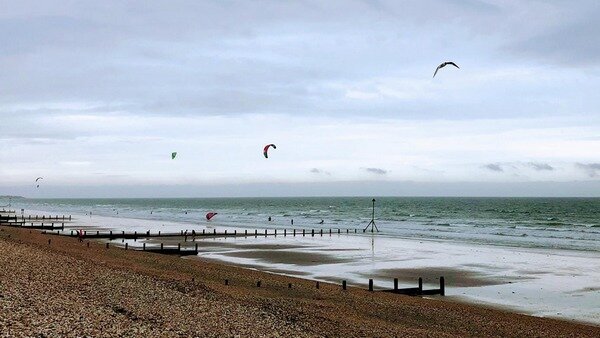
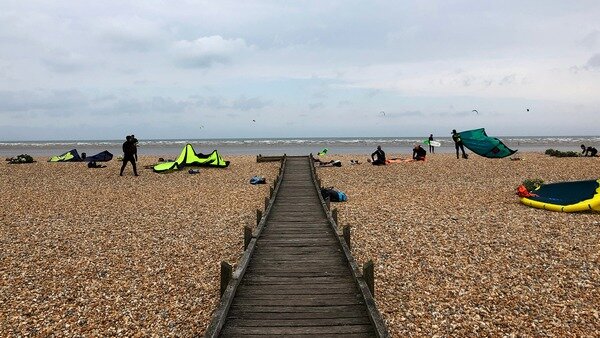
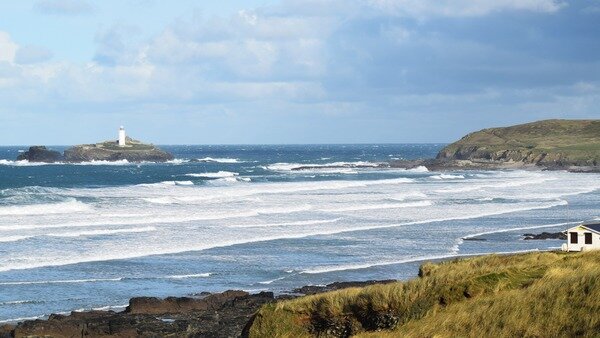
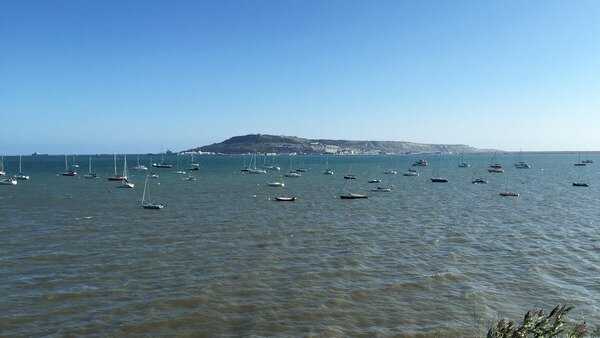
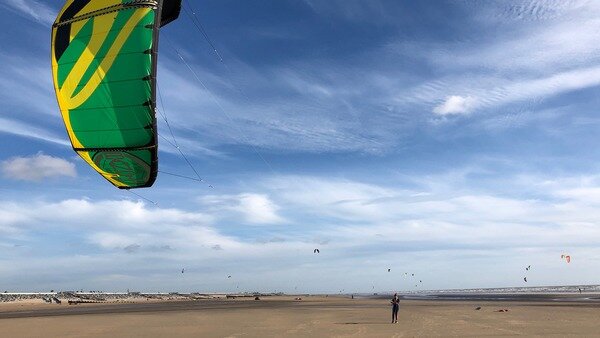
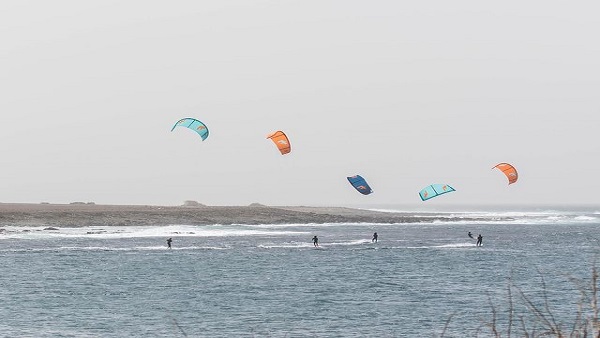
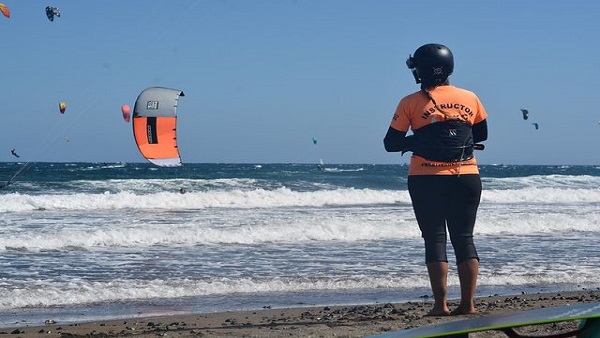
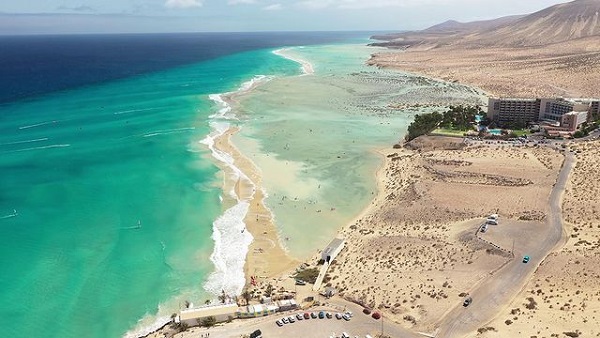
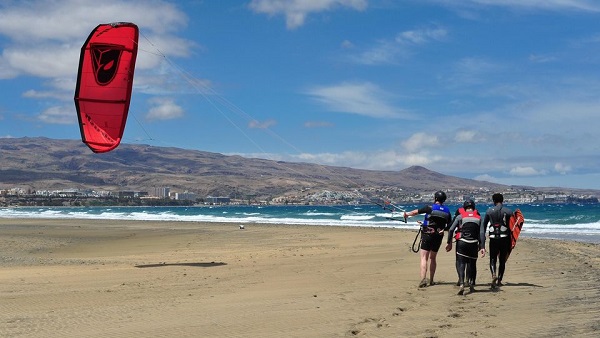
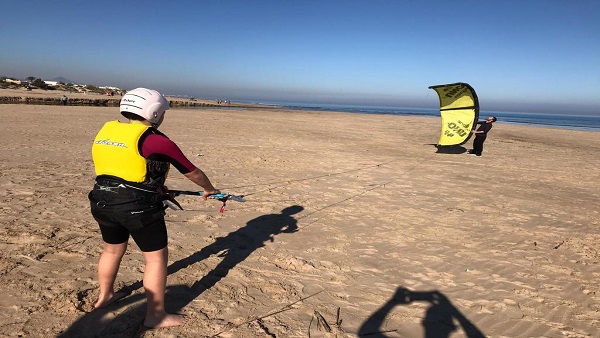
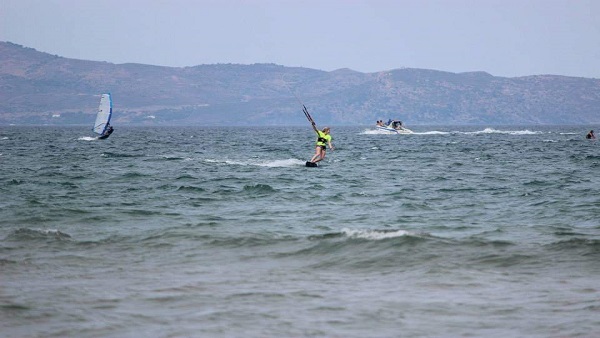
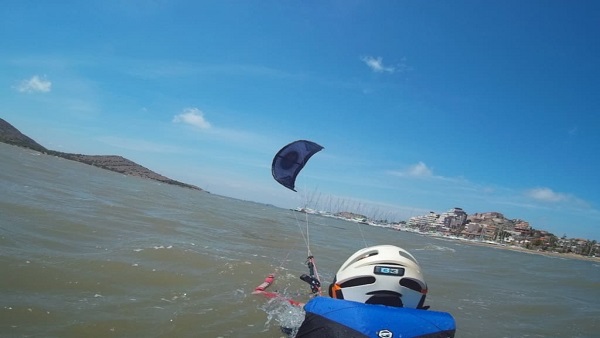
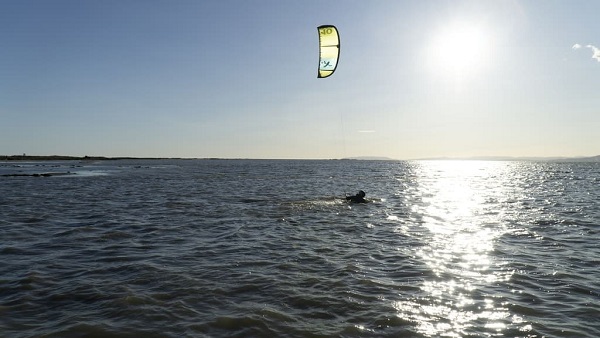
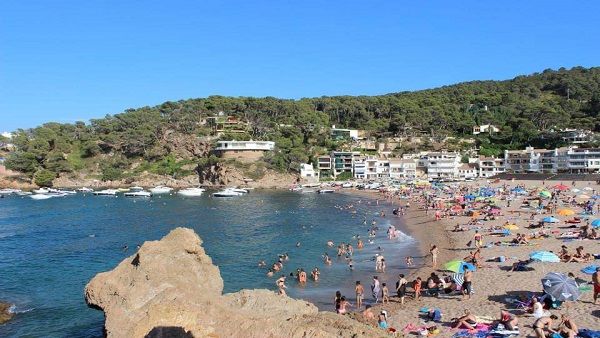
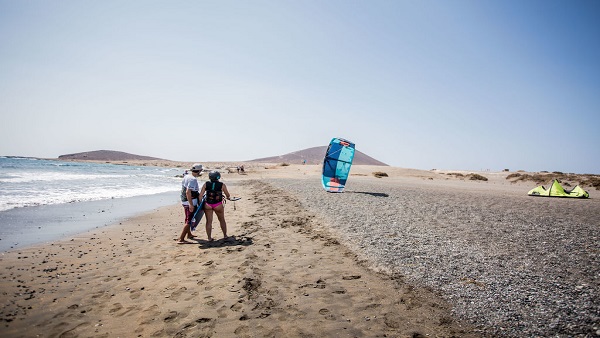
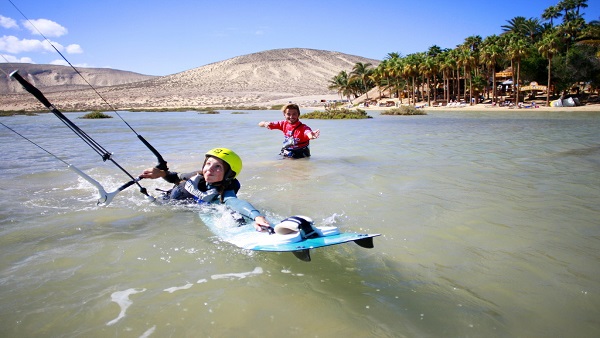

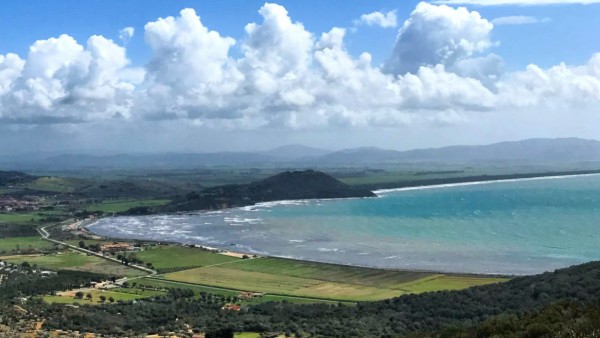
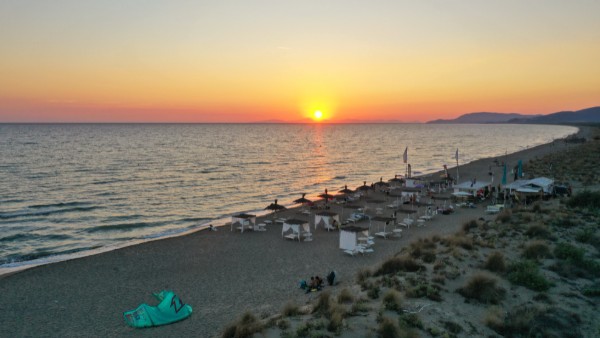
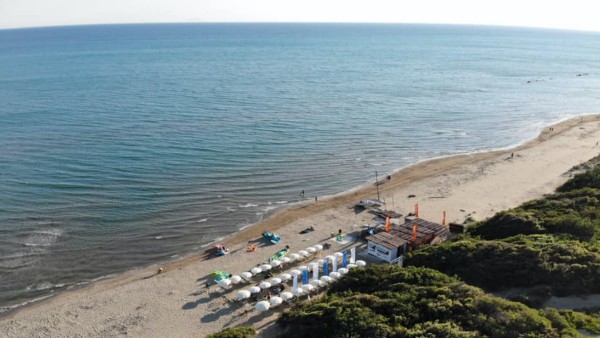
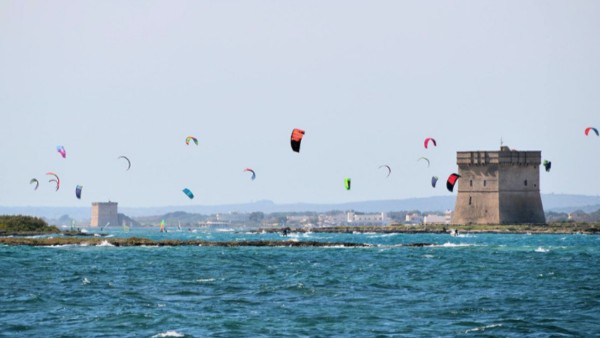
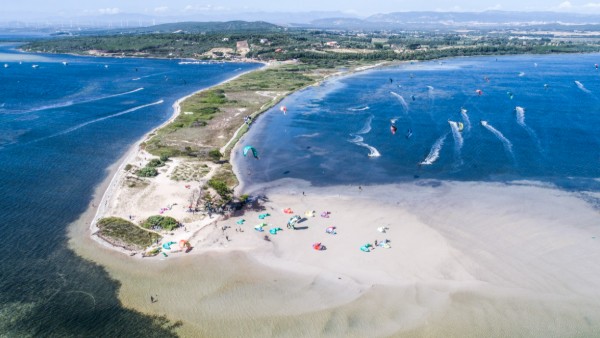
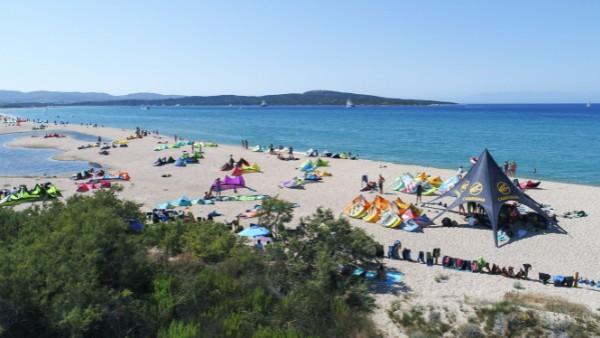
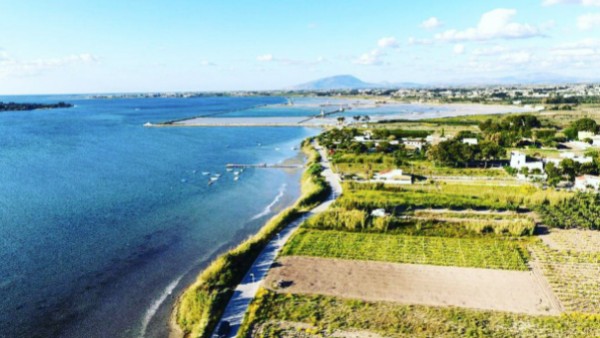
.png)

